The Reykjavík Grapevine

The Identity Of Us Volume 20 Issue 6 2023 Best before June 1 Free copy Culture Music Travel
IMAGES
MAKEUP
ACCESSORIES
Editorial Diversifying Demographics
WORDS Catharine Fulton, Editor in Chief
CATHERINE MAGNÚS DÓTTIR
It’s a conundrum being “other” in a country as small and tight-knit as Iceland. It’s something I’m keenly aware of being an immigrant in this country and it’s something I’m mindful of raising two children who are both Icelandic and not. We are part of the nearly 20% of Iceland’s population comprised of first- and second-generation immigrants.
When we set out to put together this issue of the magazine, the feature article was clear: a profile of four Icelandic artists of diverse backgrounds making their mark on the arts and cultural spheres of this country and reflecting on what their dual herit ages meant for them growing up in Iceland (read that on Page 12-14).

But the concepts of race and Icelandicness came up unexpectedly in other articles, as well – brilliantly in Shruthi Basappa’s reflection on the exhausting lack of respect and technique Icelandic chefs and food bloggers afford many international cuisines (Page 32-33), and frustratingly in an article about film dubbing (Page 18).


Iceland can do better. It’s time to do better.
20% is no small number. The individuals counted within that percentage are Icelandic, whether born and raised here or having adopted this island as their new home and working their way toward citizenship. Within that 20% there is a beautiful diversity of cultures, languages, skin colours and traditions that can make Iceland a better place to live – if the rest of Iceland embraces the diversity with respect and understanding.
Catherine studies culture and literature in Iceland and came to the Grapevine for the internship but ended up freelancing for the magazine. When she’s not trying to reconnect with her Icelandic roots, she’s usually watching video essays or attempting to finally come up with that one good story idea that she can actually finish writing.
JÓHANNES BJARKI BJARKASON
Jóhannes Bjarki is a Reykjavík local, straight out of Grafarvogur. Having been active as the frontman of the post-punk band Skoffín and in the post-dreifing art collective, Jóhannes is fascinated by the Icelandic music scene. Among his interests are politics, history and pop culture.

IRYNA ZUBENKO
Iryna is a Ukrainian journalist working at the cross-section of media and technology for the past five years. While still figuring out what to do in life, Iryna’s love of travelling, unspoiled nature and Scandi design has brought her to Reykjavík. One day she’ll write a non-fiction book.



REX BECKETT
Rex Beckett has been a fixture in the Reykjavík culture scene for over a decade as a longtime music/art writer and as former synthpunk diva Rex Pistols. They are currently working on a series delving into the influence of Garfield on queer millennials.

SHRUTHI BASAPPA
Shruthi Basappa traded the warmth of Indian summers for Arctic winds of Iceland. She’s a food enthusiast masquerading as an architect at Sei Studio and loves obsessive attention to detail. When not leading our Best of Reykjavík food panel, Shruthi can be found trying to become a Michelin restaurant inspector.

In
6 Unveiling the secrets of Icelandic moss 12–14 Multiculturalism and art: insights from four artists of mixed heritage
We took a trip to NYC to celebrate Iceland. It was a success! 26 Rap veteran Emmsjé Gauti is just getting started 28 Kayaking with a view and a secret snack 38 Questioning our existence in Reykjavík’s many parking lots
This Issue
16–17
the
Late night dining Our kitchen is open for until 23:00 on weekdays and 24:00 on weekends A local favourite for over 20 years BOOK YOUR TABLE TAPASBARINN | Vesturgata 3B | Tel: 551 2344 | tapas.is
Cover model Davíð Þór Katrínarson is an actor and musician of Icelandic and Gambian heritage. In the cover feature, he and three other artists – Dýrfinna Benita Basalan, María Thelma Smáradóttir and Logi Pedro Stefánsson – reflect on growing up and making art in Iceland as people of mixed racial descent .
On
Cover
COVER & FEATURE
Kazuma Takigawa
Kolbrún Anna Vignisdóttir
AURUM by Guðbjörg
Contributors





KONTOR REYKJAVÍK
OUR STORES IN REYKJAVÍK: FARMERS & FRIENDS
Reykjavík Streets
Overrun By Men With Machine Guns
The Council of Europe made Iceland secure to the max
But not for the people holding the guns. Icelandic police have been champing at the bit to get their trigger fingers on cold hard metal, so the arrival of 47 world leaders in Reykjavík for the Council of Europe Summit was like Christmas came early for our men and women in blue – er, black and neon yellow.
As for the event, it was just the fourth summit held in the Council of Europe’s 73-year history. It was convened in response to a report prepared in October by the Council’s High-Level Reflection Group that outlined 30 recommendations for the Council to meet the challenges presented by the war in Ukraine. The summit is being tagged as “an historic opportunity for the Council of Europe to refocus its mission, in the light of new threats to democracy and human rights, and to support Ukraine.”
WALK? YOU’RE KIDDING
If it wasn’t the armed officers repelling people from the city centre over the course of the two day gathering, it was the concrete barriers and metal fencing. You can’t make a car-loving nation park several blocks from their destination of choice. That’s madness. It would appear, based on the number of abandoned electric scooters around the perimeter of the no-go zone that you can make scooter riders hoof it.
PROTESTERS IN THE RAIN
and roughly a dozen people convened in the rain Thursday morning to protest legislation to change the retirement age in France.
SERIOUSLY, JUST STOP
Speaking of whaling, a long-awaited report on the 2022 whaling season was released by the Icelandic Food and Veterinary Authority (MAST) in early May and it found, in part, that whaling is not in line with animal welfare legislation in Iceland. We know. Shocking. Animal welfare observers and cameras were placed on the ships of Hvalur hf – the only company in Iceland hunting whales – during the 2022 whaling season to take stock of the activities.
A total of 148 whales were killed in the 2022 season, with 58 of those deaths filmed and analysed. Though Hvalur has long maintained that the whales die immediately after being shot in the head with an explosive harpoon, the report stated that 36 whales needed to be shot more than once, with five shot three times and four shot five times. One whale was chased for five hours with a harpoon in its back (it eventually got away) and some whales took up to two hours to die.
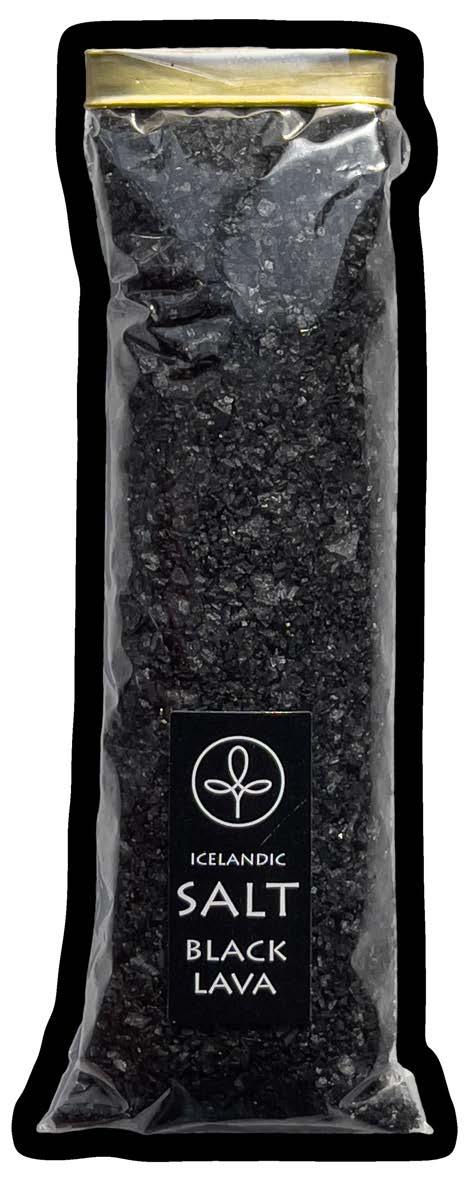
Reykjavík residents actively avoided the downtown core May 17 and 18 as roving gangs of men with submachine guns occupied the streets. They were reinforced by a posse of masked men positioned atop the Harpa Conference Centre brandishing sniper rifles. Surely this is the worst timeline.

One could assume from the lockdown efforts that authorities were expecting large scale protests against the gathered heads of state. Instead, a modest group met on Arnarhóll (the designated protest zone of the Summit) Wednesday to voice their opposition to Iceland’s reprehensible whaling practices,
“This alarming report underscores the need for a discussion in Iceland about the values we want to be known for,” Minister of Food, Agriculture and Fisheries Svandís Svavarsdóttir said. “I believe that industries incapable of guaranteeing animal welfare should be considered part of our past rather than our future. This report, along with the expert council on animal welfare’s findings, will serve as essential background material for making decisions about the future of whaling post 2023.”
The Reykjavík Grapevine 6 / 23 4 shop.grapevine.is shop.grapevine.is shop.grapevine.is* shop.grapevine.is shop.grapevine.is
Get Grapevine Merch! Don't Hesitate! Act Now! * You only need to type the URL in once VOLCANO COLLECTION The Reykjavík Grapevine PUBLISHED BY Fröken ehf. Aðalstræti 2, 101 Reykjavík www.grapevine.is grapevine@grapevine.is Member of the Icelandic Travel Industry Association www.saf.is PRINTED BY Landsprent ehf. PUBLISHER Jón Trausti Sigurðarson jontrausti@grapevine.is EDITOR IN CHIEF Catharine Fulton editor@grapevine.is PHOTO & MEDIA EDITOR Art Bicnick art@grapevine.is DESIGN & LAYOUT Arnar Hjartarson Sóley Ylja A. Bartsch JOURNALISTS Iryna Zubenko Jóhannes Bjarkason CONTRIBUTORS Catherine Magnúsdóttir Charlie Winters Davíð Roach Gunnarsson Elías Þórsson Francesca Stoppani Katla Gunnlaugsdóttir Lea Dorschel Sævar Andri Sigurðarson Shruthi Basappa Sóley Þöll Bjarnadóttir Valur Gunnarsson PHOTOGRAPHY Art Bicnick Einar Jarl Björgvinsson Patrik Ontkovic PODCAST & LISTINGS EDITOR Rex Beckett SALES DIRECTOR Aðalsteinn Jörundsson adalsteinn@grapevine.is STORE MANAGER Helgi Þór Harðarson helgi@grapevine.is FOUNDERS Aldís Pálsdóttir Hilmar Steinn Grétarsson Hörður Kristbjörnsson Jón Trausti Sigurðarson Oddur Óskar Kjartansson Valur Gunnarsson CONTACT US EDITORIAL editor@grapevine.is ADVERTISING ads@grapevine.is DISTRIBUTION & SUBSCRIPTIONS distribution@grapevine.is PRESS RELEASES events@grapevine.is GENERAL INQUIRIES grapevine@grapevine.is The Reykjavík Grapevine is published every month by Fröken Ltd. Nothing in this magazine may be reproduced in whole or in part without the written permission of the publishers. The Reykjavík Grapevine is distributed in and around Reykjavík and at key locations along Iceland's route 1. It is also available at all major tourist attractions and information centres around the country. The Grapevine is an independent publication. You may not agree with what we print, but at least our hot takes aren't paid for. None of our editorial is directed or influenced by sponsors or advertisers, and all opinions expressed are the writer's own.
shop.grapevine.is
WORDS Catharine Fulton
IMAGE Art Bicnick
What The News!?
ONE OF THE FOOD WONDERS OF THE WORLD
ICELANDIC LAMB IS THE FIRST ICELANDIC FOOD PRODUCT TO BE PDO-MARKED
Icelandic lamb has acquired the PDO label, the highest level of geographical indication in Europe, placing it in the company of the world's best-known and most sought-after quality products.
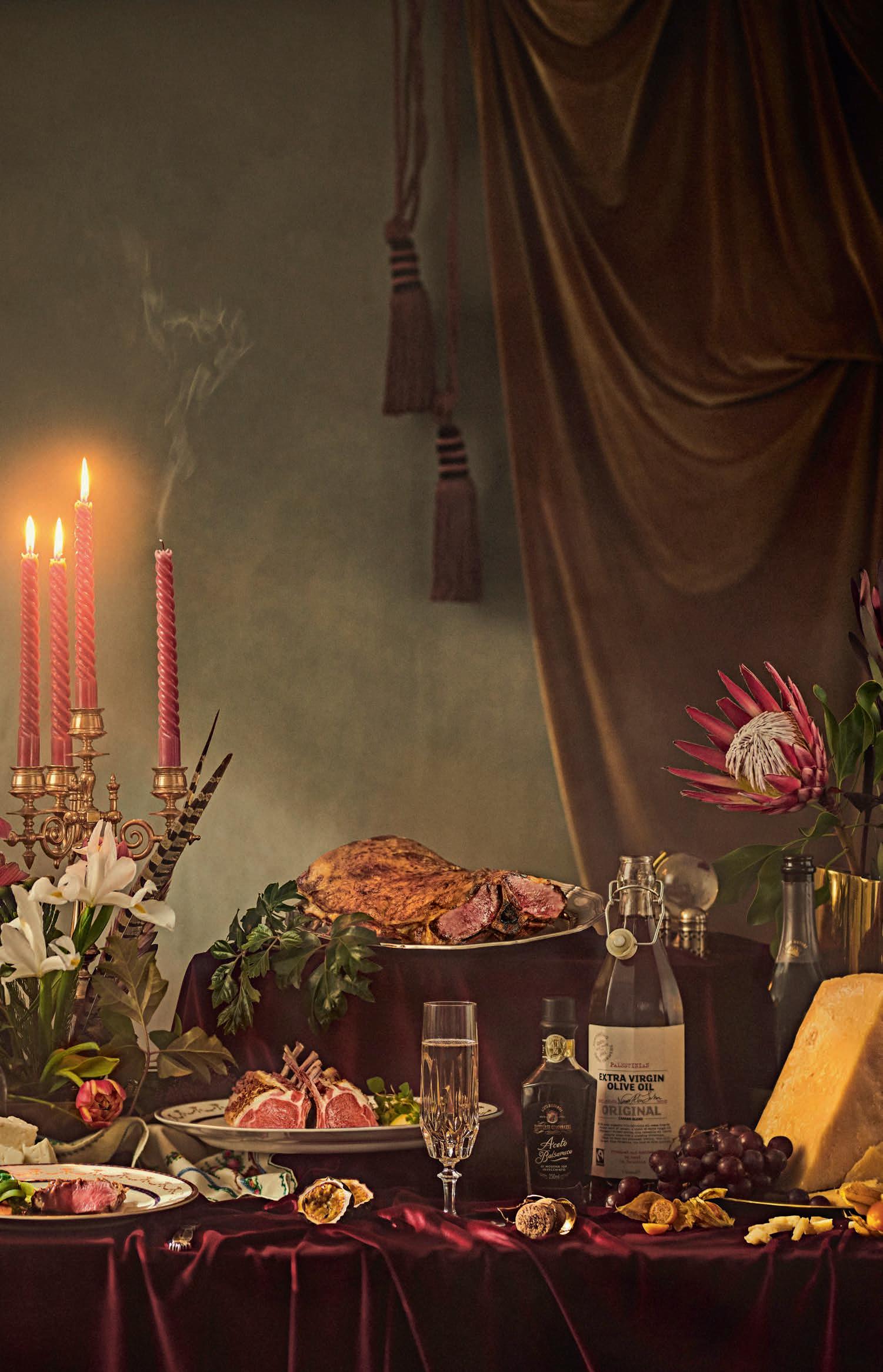
What Makes Icelandic Moss So Special?
We turned to an ecology professor for answers
WORDS Catherine Magnúsdóttir
IMAGE Art Bicnick
Icelandic Moss is frequently advertised for its high nutritional value and health benefits. People love to slap the name on their cooking herbs or cough pastilles to make sure you know that you’re getting the real good stuff into your system. But what’s so special about that pillowy green stuff anyways? We went to Professor of Ecology, Ingibjörg Svala Jónsdóttir, of the University of Iceland, to learn more about what makes it special and that – gasp! – Icelandic moss is not actually moss!
Ingibjörg clarifies. “You have the term ‘bryophytes,’ which include mosses, and then you have lichens. The common name adopted for this species of lichen is ‘Icelandic Moss’ and that has been used particularly in tourist brochures and when new products are launched that are made from these lichens.”
At this point it’s hard to say whether the mossy labelling originates from a translation issue (the blanket term in Icelandic is “mosi”) or because of the lichen’s moss-like appearance. But don’t let appearances fool you – moss and lichen are very different. Unlike moss, a lichen is not a single organism but a symbiosis with a fungus and different bacteria and sometimes green algae.
it can survive in the more extreme environments and not even just here. “Cetraria islandica grows around the northern hemisphere, including in the Arctic, where it is an important food source for reindeer, and in alpine areas of the Rocky Mountains, the Appalachian Mountains, Wales, England and Scotland.”
The lichen is a source for carbohydrates, for example when cooked in milk to make fjallagrasamjólk, and has medicinal properties. “The lichen produces different chemicals, some are antibiotic or have antibiotic functions to different extents,” Ingibjörg says.
The Útlendingur’s Guide To Getting Shit Done
Learn Icelandic already
WORDS Catharine Fulton
IMAGE Stock

fluency might be different than the path taken by others. If you have the time to dedicate, the arguably best way of establishing a strong grasp of Icelandic fast is to enroll at Háskóli Íslands. The university offers a bachelor’s degree in Icelandic as a second language, as well as a diploma in Icelandic as a second language for practical purposes. At just 60 credits, the latter is a one-year programme geared toward “people who want to improve their language skills as a preparation for further studies in Icelandic as a second language or to develop their career options in Icelandic society.”
“What is called ‘Icelandic Moss’ in English is actually a lichen,” Ingibjörg explains. “It’s a very common lichen here and one of the few, if not the only, that has been consumed by humans as a source of carbohydrates and also for health benefits – more or less because it is a good source of energy.”
The lichen – known as Cetraria islandica, Fjallagrös or even “True Icelandic Lichen” – has long been called a moss in English. “There is technically a distinction in English,”
“Symbiosis means that two or more organisms are working closely together,” Ingibjörg elaborates. “In the case of lichens, they are so close that we view them more or less as one single organism, even though they are this combination of two or more. The fungi get organic compounds from the photosynthesis by the photobiont, whether it’s algae or bacteria, in exchange for shelter and nutrients and protection from harmful UV radiation.”
“Together they build a very tough organism that can better tolerate harsh conditions such as high degrees of desiccation and low temperatures.” That explains why
So best be careful not to step on the precious greenery, as it’s also very slow growing. According to Ingibjörg, “mosses, which are for example covering lava fields – yes, that is moss, not lichen – are very sensitive to trampling. Particularly when they are dry. Lichens that often grow within this moss – sometimes also within some other vegetation – also become very brittle when they are dry.”
Given that the lichens and moss have a significant impact on the ecosystems, carbon fluxes and the circulation of nutrients, and serve as strong indicators of the system’s health, it’s important to be careful with them. Plus, we’ve sort of taken a lichen to them.
Good luck.
That could be the start and end of this column if based solely on my own attempts and failures at learning Icelandic over the *cough*
14 years I’ve lived in this country
– yes, I’m one of those útlendingur Icelanders bitch about in the Vísir comments section – but instead I’ll take a “do what I say and not as I do” approach.

And what I say is: invest the time. It’s really worth it. Language unlocks so many doors, both socially and professionally.
There are so many resources out there, so your journey to Icelandic
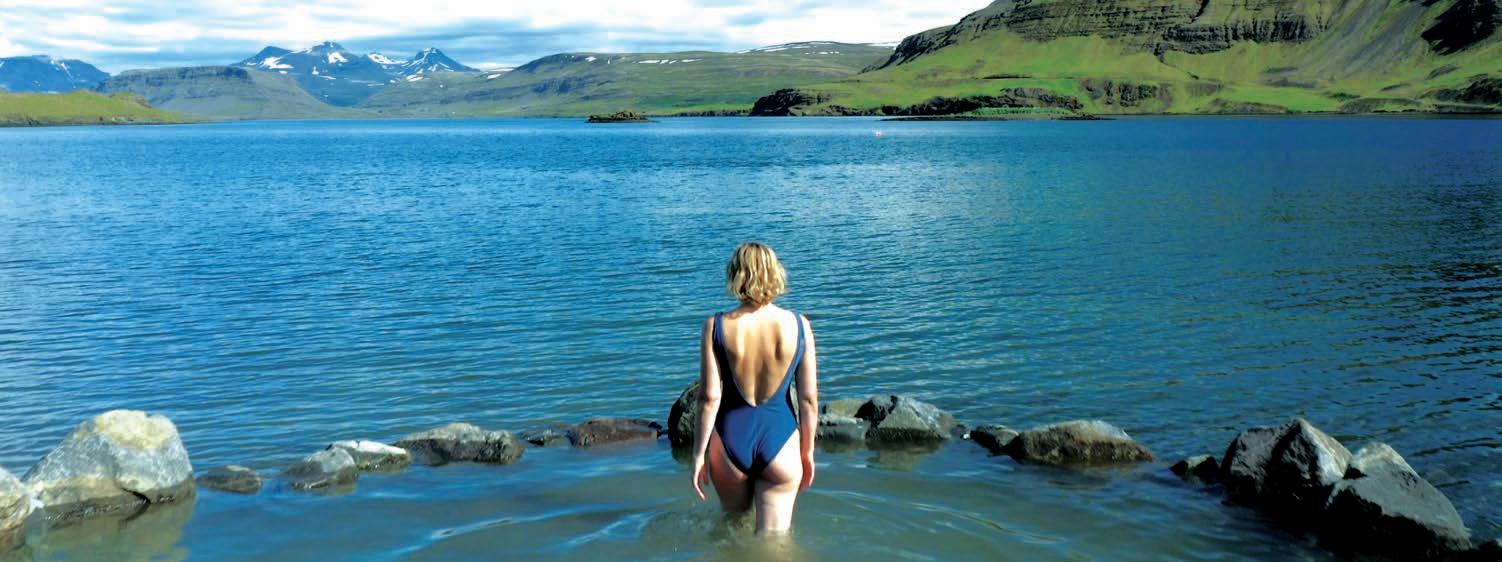
Alternatively, you can go it alone with the free courses at IcelandicOnline. com (they also offer “plus courses” with a tutor for a fee), or enroll in a language school. Mímir is the OG and also facilitates the language proficiency tests for citizenship, but there’s also Tin Can Factory, Múltí Kúltí and many others out there offering day and evening lessons, remote lessons and courses suited for those working shifts. Check with your union to get some of your course fees reimbursed.

Finally, don’t be afraid to practice your burgeoning Icelandic skills out in the wild. If an Icelander bellows an indignant “HA?” at your minor mispronunciation, that says less about your language aptitude than it does about them being a gaping asshole.

The Reykjavík Grapevine 6 / 23 6 THE #1 BEST THING TO DO IN THE WORLD - by TimeOut Magazine NATURAL HOT SPRINGS SINCE 1187 HVAMMSVIK.COM ONLY 45 MINUTES FROM REYKJAVÍK
Ask An Expert
Do Shit
Experience Icelandic Bathing Culture
Minutes from the City Centre

Islanders
Juggling Two Worlds
IMAGE Art Bicnick
“Look, there is one there that is breathing a bit weirdly in the corner. We should keep an eye on her,” says Pálína Axelsdóttir Njarðvík as she walks around the farm checking about 200 sheep expected to give birth any day now. It’s the third day of the lambing season and the beginning of a few busy weeks on her family’s farm in South Iceland. With Sunna, whom Pálína lovingly refers to as ‘my puppy,’ by her side, she’s fully prepared.
aunts farm here. I help out as much as I can and during lambing I’m always here. I like to spend time with the sheep and, in general, help out and have an opinion on everything. But I also live in Reykjavík with my girlfriend María, and I have a job there. I moved to Reykjavík when I was 16 so I could go to school there. Then I went to university and did a master’s degree in Social Psychology.
I’ve been helping out as long as I’ve been able. As a kid who lives on a farm, you get tasks as you grow, and you always get more and more responsibility until you are doing everything. I always liked it. I don’t think I’ve ever really seen it as a job. Obviously, it is a job, but it’s also just your life when you live on a farm. As a child you enjoy being around animals, your parents, relatives, and just being out and about.
A SHEEPFLUENCER
I started my Instagram in 2015 and I didn’t really expect much. I thought maybe someone out there wants to learn about sheep farming in Iceland, and I have a lot of pictures and stories to share. I just started posting and somehow it took off. I would like to say it just happened, but obviously there is a lot of work behind it. I really enjoy it, and obviously I have strong opinions regarding everything connected to sheep, farming, animal welfare and so on. I don’t like factory farming. It should not be called farming. It has nothing to do with how people farm.
I feel like I have a message that I want to share – I think sheep are quite underrated in general, people don’t really know them. But sheep are great animals, as you learn when you see the connection that you can have with them. My Instagram opens a little window into this world.
the night, someone stays up a bit late, someone wakes up in the middle of the night and someone goes very early in the morning. Throughout the day, we all help out with what has to be done. During lambing, you don’t sleep enough. If something goes wrong, you get called out and you have to go and help the sheep deliver.
It’s horrible if you see a dead lamb and you know it’s dead because you weren’t there. We want to avoid that, obviously. We feed them twice a day, in the morning and then in the afternoon. Between the feedings there’s just a lot to do – we’re always keeping an eye if someone is giving birth and then we keep an eye on the birth so we know if we have to help them. Usually we don’t have to, but it’s always better to know what’s going on.
If you see that there’s only a head coming out and no legs, you have to go in and find the legs. And if you get the back legs, you have to get the lamb out quickly. I feel like today I know pretty much everything. That’s why I get the least sleep sometimes.
active role than usual. But of course, I want to be here and be a part of everything.
THE TIES THAT BIND
If you have animals, you’re going to get connected to some of them. We were walking with my Sunna earlier today. She grew up in our basement because she was very weak when she was born. I took her home and nursed her back to health. She’s deaf and she was really tiny. She wouldn’t have stood a chance alone because her mother didn’t care for her. We have a very strong bond. She’s more of a pet, really. When we walk around the paddock to look at the sheep, she always follows us like a dog.
We’re all animals, in a way. We all have feelings. We all feel sad, happy or hungry. Sheep have sheep friends, they hang out with their families, we often see a mother and her daughter spending the summer together, even if they are both adults, and sisters spend summers together too.
This farm has been in my family for, I think, seven generations. My parents live here, and my uncles and
I feel like I get the best of both worlds. I get to spend time at the farm, but I also have a life in Reykjavík.
CIRCLE OF LIFE
During lambing season, someone has to be in the sheep house every hour of the day. We take turns during

This year, lambing will be a lot different for me, because it’s not just the sheep who are pregnant – I am too! During pregnancy, I have to avoid some things, so I am playing a less
I don’t think I’ll ever grow tired of this. The farm might change, but it will still be our family’s farm. The roots are so deep here. I can’t imagine not having this farm and being able to be here as much as I want.
Follow Pálína’s farming adventures on Instagram: @farmlifeiceland
The Reykjavík Grapevine 6 / 23 8
WORDS Iryna Zubenko
Icelandic farmer Pálína Axelsdóttir Njarðvík balances farm life and city life
I think sheep are quite underrated in general. People don’t really know them.
The Munasafn Tool Library Enters A New Phase
Circular is the word of the day and the concept of the future
officer. “His role is mainly helping us find funding and make connections,” Anna says. “I’ve been meeting with him virtually and finally met him in
“Don’t get me wrong,” Anna clarifies, “I understand the necessity of money. If you need to use a drill every day, by all means, buy a drill. But why
All things Icelandic in design and craft

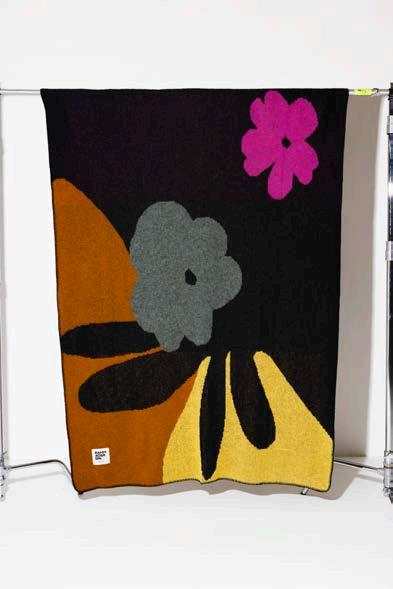
Anna Worthington De Matos has been a prominent figure in the Icelandic environmental movement since moving here from England. Having founded the Munasafn Tool Library in 2018 – which has landed in Hafnarhaus after a few relocations – Anna has been at the forefront of the circular economy movement.

The idea behind a tool library is simple: libraries lend books; tool libraries lend tools. Despite this seemingly simple and straightforward idea, Anna’s work is sometimes met with inertia. “There is a huge lack of understanding of what we do and a lack of understanding what a circular economy is,” she says. From going through the Kafkaesque process of communicating with city officials to securing funding for the operations, she knows all too well the frustration of bureaucracy.
SHARING IS CARING
In the last months, Anna has been preparing for a new phase in the library’s life. In between running the tool library, the non-profit organisation Hringrásarsetur Íslands (Circular Centre of Iceland), and a self-checkout circular library in three locations, Anna has now secured an investor to join the team.
The investor, Daniel Haltia, has a background in circular business development with IKEA and will be joining the circular centre’s operations as a chief circular economy
person at the Loop Circular Conference in Copenhagen the other day,” Anna tells the Grapevine upon her return from the late-April event.
“He understands my vision and sees what we’re trying to do. If you’re an investor, you need to check a lot of boxes before I bring you on,” she says jokingly.
The whole deal behind the tool library is to create a community that’s willing to share more and emphasise usership as opposed to ownership. It’s an idealistic notion, but Anna has realistic expectations and believes in change. “There is no alternative. Either we end up in a Wall-E world where there’s trash everywhere and fat rich people live
in space,” she muses. “Or we’re going to end up in a society where we care for each other and respect the limited resources.”
The responsibility for addressing the climate crisis is all too often passed onto individuals. While individuals can and should adopt environmentally friendlier lifestyles, Anna says change needs to be instigated top-down. “I think there’s a lot of policies in place that need to be changed to accommodate this new concept of circularity.”
are we importing cheap and trashy products to Iceland that break in six months and end up in the landfill?”
A HOMEMADE SOLUTION
Asked whether local communities should start similar lending schemes, Anna encourages it but identifies a common point of contention. Again, it’s about ownership. “The main issue with peer-to-peer lending,” Anna says, “is that there has to be an understanding that by donating the item, you transfer the ownership to the community. It’s complicated. Emotions are complicated.”
In celebration of the 100th anniversary of the city library, Munasafnið is offering free membership give-
aways which will run at least into the end of May. You only need to visit the downtown city library and take a picture of your library card, put it on Instagram with the exclusive Hringrásarsafnið filter and tag the Munasafn Tool Library and the Borgarbókasafn city library in your story.
Hringrásarsetur operates a monthly repair café where people can bring broken items and repair them. You can volunteer with them and learn the tricks of the trade.
9
1 Eden Blanket, designed by Aníta Hirlekar. Made in Reykjavík from pure Icelandic wool.
1 WWW.RAMMAGERDIN.IS RAMMAGERÐIN, ÍSLAND 1940 2 Skólavörðustígur
Skólavörðustígur
Kringlan Harpa Flugstöð
BEST O R EYKJAVÍK BEST DE GN STORE BEST O R E KJAVÍK BEST DES GN STORE BEST OF R E KJAVÍK BEST DES GN STORE
2 Arctic Blanket, designed by Sigrún Halla Unnarsdóttir. Made in Reykjavík from pure Icelandic wool.
7
12
Leifs Eiríkssonar
WORDS Jóhannes Bjarkason
IMAGE Art Bicnick
The Neighbourhood Watch
There is no alternative. Either we end up in a Wall-E world where there’s trash everywhere and fat rich people live in space. Or we’re going to end up in a society where we care for each other and respect the limited resources.
Emotions are complicated.
Is Crime True In Iceland?

How a small country can have so much true crime fodder
WORDS Katla Gunnarsdóttir
IMAGES Art Bicnick
more than one serial killer. “What is special in Iceland is how easy it is to disappear into nature; in lava holes
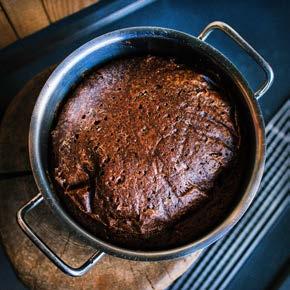
no evidence of their guilt. The case was cracked by forced confessions after the accused were kept in iso-
land. Remember the lava holes and cracks? That's apparently a great place to hide a body.
Who tunes in for these grizzly tales?

There haven't been many, but they occur in Iceland as they do everywhere else. Murders and violent crime. The harsh conditions and isolation here are sure to drive a man insane. But with so few inhabitants to choose from, it’s hard out there for a serial killer.
No missing person goes unnoticed and rural areas are notorious for being home to busybodies with an oddly vested interest in what you’re hiding in that freshly dug hole in your backyard.
SERIAN SUSPICIONS
There is only one record of a serial killer in Iceland; the fearsome “Axlar-Björn” or “Shoulder-Björn”
– a name earned from his hometown of Öxl, which you may have ascertained by now means “shoulder.” His weapon of choice was an axe. One of his victims, a young boy, escaped, though his sister hadn’t been so lucky. When Björn was questioned, he was wearing the hat of a previous victim, sealing his fate. He confessed to 18 murders and was sentenced to death, first by having all his limbs broken and then being decapitated. It should, of course, be noted that this happened in 1596. Axlar-Björn’s case is one of legend – Iceland’s one and only serial killer… or are there others?
Journalist, filmmaker and Iceland’s no.1 true crime expert Sigursteinn Másson doesn’t rule out there being
or cracks,” he says. “There have been 50 or 60 missing persons since the Second World War. Some of those are definitely murders.”
Sigursteinn’s true crime TV series Sönn íslensk sakamál has been going strong since 1999, still he’s frequently asked if such a series is necessary in a small community. To that he says it’s even more important to bring the facts of a criminal case to light here since small town gossip quickly tarnishes a person’s reputation and can ruin their life faster than any unlawful tendencies.
FORCED CONFESSION
“The case of Guðmundur and Geirfinnur” revolves around the disappearance of two men in 1974 who were allegedly murdered, though their bodies were never recovered. It is Iceland’s most notorious criminal case.
In 1997, Sigursteinn was approached by the number one suspect in the case, Sævar Ciesielski, who wanted to make some of his case records public. He and his friends had been convicted of the crime in 1975 with
lation – in one instance for two years – and subjected to sleep deprivation and torture.
Sigursteinn intended to write an article on the subject, but as he dug deeper, he realized that a TV miniseries would be necessary to cover everything. He describes what happened in the Guðmundur and Geirfinnur case as a wild conspiracy against the accused, and a unique case in Europe and possibly even the whole world. The case still haunts Sigursteinn and he subsequently lost his belief in the integrity of the Icelandic justice system and authorities after learning the truth. The convicted were only pardoned in 2018.
MADE FOR WOMEN
True crime podcasts have been gaining a dedicated following all over the world and Iceland is no exception, with an abundance of local series to choose from. Nína Snorradóttir, host of legendary local true crime podcast “Myrkur” (Darkness) also subscribes to the belief that there has been more than one serial killer on this windspect is-
Women. Nína tells us that when she started her podcast a few years ago over 90% of her audience were women. Since then more men and non-binary folks have come aboard. In Iceland around 78% percent of suspects of violent crime are male. One theory states that consciously and unconsciously, women want to be ready. As they account for the majority of victims, they want to know what to look out for.
BUT IS CRIME TRUE ?
Contrary to popular belief, there are alot of guns circulating in Iceland, either registered to collectors or used for hunting. That hasn’t translated to guns being the weapon of
Still, crime rates have stayed virtually the same since the 40s. There was, however, a 12% uptick in violent crime in 2022 compared to the median of the three years prior. There were four murders that year, which is unusually high. The likeliest explanation for that statistical increase is that violent crime had actually decreased during the pandemic and then returned with a bang when restrictions were lifted.
Doctor of criminology Margrét Valdimarsdóttir says there’s no need to take any more precaution in Iceland than anywhere else, though she said that less alcohol consumed on a night out will make you a less likely target for perpetrators of crime.

The landscape in today's Reykjavík is a little different than it was back in the Sturlungaöld, the age of vikings

choice in violent crimes. Those with violent intentions usually go for knives, screwdrivers or their bare hands, possibly because murder is almost never premeditated in Iceland.
Today’s underworld is more organized than it once was and drug trafficking is more prevalent, with 2022 being a record year for seized narcotics.
and “an eye for an eye.” Back when you couldn’t even laugh a little too loud at someone’s bad joke without being fearful for your life.
Today we really are doing pretty good, with the third lowest murder rate in Europe, almost “Best in Show.” But, in all seriousness just like anywhere else in the world; be wary of suspicious individuals or violent behavior wherever you are.
10 Geothermal baths Natural steam baths Geothermal Bakery Geothermal Baths fontana.is fontana@fontana.is +354 486-1400
No missing person goes unnoticed and rural areas are notorious for being home to busybodies with an oddly vested interest in what you’re hiding in that freshly dug hole in your backyard.
Huh, Interesting
The case still haunts Sigursteinn and he subsequently lost his belief in the integrity of the Icelandic justice system and authorities after learning the truth.
A Night At Prikið

One DJ’s account of a night on the town
WORDS Sóley Þöll Bjarnadóttir
IMAGE Art Bicnick
night without having a chat with Helgi first.
The Weekend Musician
Modelling and music to make ends meet
WORDS Iryna Zubenko & Sébastien Nouat
IMAGE Art Bicnick
April 29th, Prikið
Prikið, where everybody knows your name. My venue for the night. “Bartender – get me a Red Bull, a glass of water and one coffee.” Staying hydrated is key.

The place is packed with tourists and regulars. I really can’t start my
When my set starts I bring out some classics and mix in local hip hop artists. Throwing in a little Beyonce or Britney here and there always gets people on the dance floor pretty quickly. A guy approaches and starts scrolling through his Spotify playlist to show me five different songs to play. I give him the thumbs up while not paying him any attention. People are dancing, making out. Some are fighting. A classic Saturday night.
The lights turn on and I choose my closing song carefully. I decided on “Gloria” by Laura Branigan. You can never go wrong with that.
I say my goodbyes, go buy a frozen pizza and head home. Another successful night over.
Prices in Reykjavík are rising as you read this, postpandemic layoffs persist and AI is threatening to take over everybody’s job. Today’s generation isn’t worried about affording a house; we’re just happy if our expenses don’t surpass our income. Everyone is hustling. Here’s how one Reykjavíking makes a few more krónur.
extra: you are mostly paid for waiting for your time to dimly shine in the background of a production and the odds are that you’ll be cut out. In a similar vein of being in front of observers, I modelled for drawing classes; holding a pose for 10 minutes is surprisingly a very satisfying effort.
But my favourite side hustle is music: musicals like Hedwig and the Angry Inch or live soundtracks with my project Wazy Lizard for yoga and improvised dance classes. When I say improvised, I mean it – once the dancers took over, beating their feet and clapping their hands. I had no choice but to listen and watch.
DOES AND DON’TS
The first step to side-hustling as a musician is to decide it’s good enough and go for it! People will only invite you to play if they see you or hear of you doing it, so you just have to get the ball rolling and talk to people. That’s how I shifted from solo improvisation sessions to doing soundtracks for classes. As for the modelling hustle, I can tell you one thing not to do: send a photo of yourself with a bare torso to all the main colleges in Reykjavík saying that you are available as a model for drawing classes. Just don’t!
MONEY- SAVING TRICK
Sébastien Nouat, 31, Software Engineer

I occupy my weekdays working on software to tame 3D models of buildings and run sound simulations in them. From 2019 to 2021, I did the un-rewarding task of being an
The best thing about my side hustle is the interaction between the music, the teacher and the attendees: we all affect each other and take the lead in shaping the general movement, like a multi-organism. What I like less is carrying all the instruments and gear – though the excitement grows as soon as I start setting it up.
It’s hard to count how much money I have saved by “learning” to dance sober, but since then, parties downtown have never been an expense for me!
Want to share how you’re making ends meet? Email us at grapevine@ grapevine.is with the subject line “Side Hustle.” We’ll happily keep your identity anonymous.
11
What Happened Last Night?
Side Hustle Of The Issue
Feature
The Identity of Us
Meet
first and second generation immigrants doubled from 8% to 16.3%. Look back to 2002 and that number was just 4.2%.
Iceland’s evolving visage has become increasingly obvious in recent years as a new generation of artists with mixed racial descent step into the spotlight, showcasing the expanding diversity of the nation. We


“When my mom landed in Keflavík everything was covered in snow – something she’d never seen before – and she felt it was magical and thought ‘this is where I belong,’” María relates.
Earlier this year María appeared as Snæfríður Íslandssól in the theatrical adaptation of Nobel laureate Halldór Laxness’ novel Iceland's
and mocks what it means to be Icelandic and the relationship the country had with its Danish rulers.
“In high school I read Iceland’s Bell at a point where I was considering becoming an actress,” says María.
“I connected so much with the character of Snæfríður Íslandssól, but I didn’t think it was possible for me, being of mixed race, to portray her in Iceland. There were no mixed race actresses, so I really doubted if it was possible.”
The character of Snæfríður Íslandssól can be seen as an idealised image of Icelanders – she believes in justice and self determination, but she is controlled by the more powerful men in her life. She is also a romanticised personification of the perfect beauty, with her figure being described as “elfish” and her being referred to as “the light woman.”
María believes artists can occupy a unique place in the conversation about race and Iceland simply by continuing in their creative endeavours and making themselves more visible. The more the general public sees the cultural output of Icelanders of mixed racial descent, the more they will shift their focus to the quality of the work and away from the race of the creator.
“I think society is going through a kind of growth spurt,” María suggests. “When people see something they are not used to they get almost an error message in their heads and can’t process what they are seeing. But after they’ve seen something often enough they get used to it and stop thinking about it.”
A FATHER’S HERITAGE
The past 30 years have brought about the biggest demographic shift in Iceland since disgruntled Norwegian pagans settled here more than 1000 years ago. In the decade leading up to 2022, the percentage of Iceland’s population composed of
sat down with four artists of mixed heritage to discuss the Icelandic identity and the impact of multiculturalism and race on art and society.
PERFORMANCE IDENTITY
Born in 1993 to a Thai mother and an Icelandic father, María Thelma Smáradóttir has been at the forefront of the emergence of young, multiracial actors beginning to make waves in Iceland’s culture sector. And she’s setting the bar high, having already appeared in several Icelandic TV series as well as co-starring in the 2018 movie Arctic alongside Danish actor Mads Mikkelsen.
Bell. The performance was a collaboration between the National Theatre of Iceland and Elefant, a group of young Icelandic actors of mixed racial descent.
Iceland’s Bell is, in many ways, the quintessential Icelandic novel. It starts out with the story of Jón Hreggviðsson, a rather unfortunate, often drunk, poor farmer who is punished with lashings and sent to prison in Copenhagen for stealing a piece of string. The novel was released in three parts, with the first published in 1943, a year before the country gained independence, and the third in 1946. It both explores
It is hard to disregard the symbolism of a multiracial artist depicting a character as Icelandic as Snæfríður Íslandssól. In the 40s, Laxness sought to explore what it was to be an independent Icelandic nation; now the Elefant staging of his work holds a mirror to 21st century Iceland, forcing us as a nation to consider who we are.
“The feedback I received was just positive,” María says matter of factly.
“I don’t know if there were people who didn’t like it – possibly there were – but I try not to focus on comments like that,” she says. “The demands of audiences have also changed in recent years and they want more diversity on stage, which is great.”
“We didn’t want to take the activist approach to art – we wanted to put the issue of what it means to be Icelandic into the hands of the audience, to make them face that question,” explains actor and musician Davíð Þór Katrínarson, an Elefant member who starred alongside María in Iceland’s Bell. He was born in Norway in 1993 to an Icelandic mother and a Gambian father, but moved to Iceland when he was sixyears old.
“My father has never really been a part of my life and I lost touch with him pretty early on,” Davíð explains. “But in recent years I felt a need to get in touch with him again, especially because I just became a father myself.”
Without contact with his extended family in Africa, Davíð says he didn’t
The Reykjavík Grapevine 6 / 23 12 Feature
WORDS Elías Þórsson
IMAGES Kazuma Takigawa
changing the face of
arts and
four people
Icelandic
culture
When people see something they are not used to they get almost an error message in their heads and can’t process what they are seeing. But after they’ve seen something often enough they get used to it and stop thinking about it.
give much thought to his Gambian heritage as a child. However, that changed when he received a message through social media. “A year and a half ago this woman sent me a message on Instagram saying her name was Juka Darboe and that she was my aunt. Before that, I knew nothing about my Gambian family.”
In making that connection and learning more about his father’s country Davíð found a part of himself that he didn’t even know he was missing while growing up in Iceland. “I want my daughter to know about the Gambia, because knowing where you are from makes it easier to understand where you are in the world and where you are going,” says Davíð
It was not long after reconnecting with his Gambian heritage that Davíð was performing in Iceland’s Bell and discovered he is a direct descendant of Magnús Sigurðsson from Bræðratunga, the inspiration for one of the novel’s main characters. “It’s kind of funny,” he muses, “if anyone would say that I have no right to be in Iceland’s Bell, then I could argue that few people have more of a right.”
The question of who has the right to adapt or stage Icelandic cultural works was raised following the March 2023 premiere of the play. Apparently, there were people who objected
to Elefant’s performance, with one furious woman calling the theatre to admonish it for performing “this story with this group.”
Still, Davíð feels Icelandic society has taken leaps and bounds toward inclusivity in recent years and he’s hopeful future generations will be even more willing to see past the colour of a person’s skin.

“Kids today aren’t shocked when a black girl starts in their class, or if their friend’s mom is wearing a burka,” he says. “If we get used to something at an early age, we normalise it. And when we’ve normalised things, we don’t have to constantly have this conversation.”
People have a tendency to focus on the things that make us different from one another, but Davíð believes a greater focus on what we have in common is what will foster a better, more empathetic society.
“An Icelander is someone who goes to the pool and orders Domino’s,” he deadpans. “It is not what you look like, or the colour of your skin. We all live here, we pay the same taxes, are all affected by inflation and each year we hope we’ll have a nice summer, but it never happens. I believe it's those shared experiences that make us Icelandic.”
TOO FILIPINO TO BE ICELANDIC, TOO ICELANDIC TO BE FILIPINO
“When I think about the Icelandic identity I picture myself freezing cold on a boat in the middle of the ocean, fishing with my dad and working too much,” says Dýrfinna. “My father used to tell me with pride about the time, when he was younger, he’d stay up for 58 hours straight processing fish.”
Dýrfinna Benita Basalan is a 31-year old visual artist and musician who often goes by her nom de guerre Countess Malaise. She is of Filipino and Icelandic descent and her works often explore her upbringing as someone who is a part of two cultures, while feeling she didn’t belong to either.
“My mom is Filipino and my dad was an ancient boat builder and fisherman born in 1934 in the tiny fishing village of Raufarhöfn in northern Iceland,” says Dýrfinna. “Dad was a very old school Icelander and I think I got my DIY attitude, and my love for old music and the accordion from him. I fuck with the accordion.”
Dýrfinna explains that belonging to two different cultures was not always straightforward and could be confusing growing up in Iceland, leading to feelings of alienation. “In a way, I was excluded from the Filipino and Icelandic communities. I was never enough for anyone and was never allowed to be a part of anything,” says Dýrfinna, sharing that her mother opted not to teach her Filipino, believing that it was better in the sociocultural climate at the time, that she speak only Icelandic.
“For the longest time I didn’t know who the fuck I was, and because society and the people who raised me failed to give me satisfactory answers I had to go searching for myself.”
In 2019, Dýrfinna, along with artists Darren Mark and Melanie Ubaldo, founded Lucky 3, an art collective

exhibit in a major gallery, or anywhere that might be considered an ‘institution,’” says Dýrfinna.
THE LEGACY OF HANS JÓNATAN
Logi Pedro Stefánsson has long been a staple of the Icelandic culture scene. Since founding the band Retro Stefson in 2006, he has gone
seeking to explore the place and identity of the Filipino diaspora in Iceland.
“I had no brown artists to look up to when I was younger and part of why we founded Lucky 3 is that, at the bottom of it, we are all healing our inner child. We are doing this for our younger selves who needed someone like us, someone to show us love,” explains Dýrfinna.
The group’s 2019 debut exhibition at the art gallery Kling og Bang was a milestone for inclusion and diversity in the Icelandic art scene, but Dýrfinna claims that it also provided insight into the need for greater self-reflection within the country’s cultural institutions. “It has never been acknowledged that we were the first brown Icelandic artists to
on to release two solo albums, found a radio station and design for international fashion brands.
Born in 1992 to an Icelandic father and an Angolan mother, Logi says, “it is clear that my background is always a factor in what I do. Say, if you are from Akureyri then that is going to impact you, and when your background is more varied, then your point of view will be even more different. When you are working in creative fields, it is important to have people with different points of views and experiences.”
From the outset, an alternative point of view was a noticeable feature of Retro Stefson, which also counted Logi’s brother Unnsteinn among its members. Their mother would listen to Angolan and African music at
13 Feature
When we’ve normalised things, we don’t have to constantly have this conversation.
In a way, I was excluded from the Filipino and Icelandic communities. I was never enough for anyone and was never allowed to be a part of anything.
home and those influences helped shape a sound that was often hard to define.
“It has become clearer to me in recent years that we are all playing different roles,” Logi explains. “For me, some roles are very European, some are very Nordic, some are African and some are African diasporic. I’ve never lived in Africa, so in some way I have more in common with people of African descent in Europe than my family in Africa.”
This spring Logi completed a degree in product design from Iceland University of the Arts. His graduation
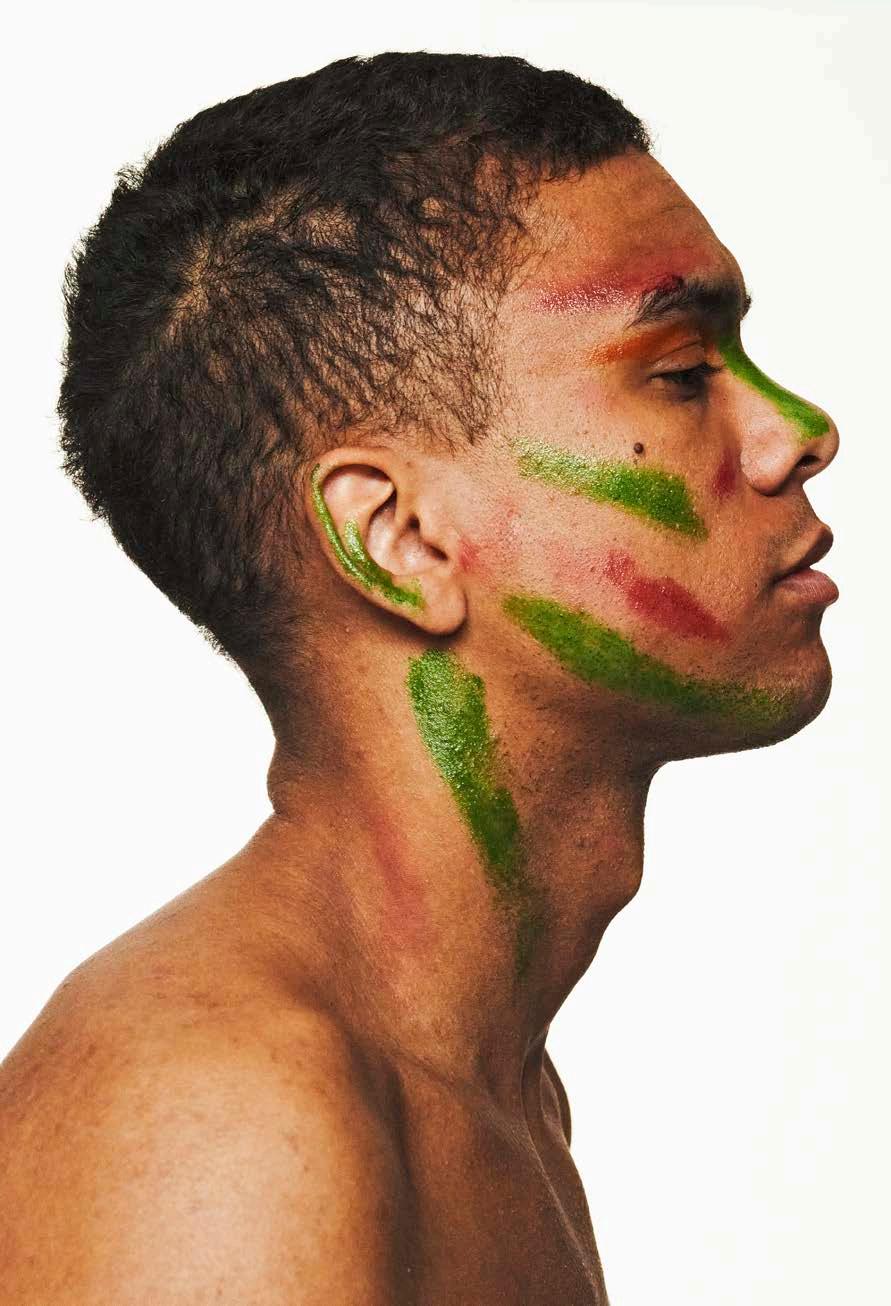
project focused on how heritage manifests itself through design by analysing the works of the African diaspora in Europe. The project is called “Love letter to litla Kongó” and is inspired by the remarkable story of Hans Jónatan, a once enslaved person who became the first known person of African descent to settle in Iceland.
“I read Hans Jónatan’s biography, The Man Who Stole Himself, and it made me wonder why I had never heard about this man before and why I had never learned about the colonial history of the Nordic countries,” says Logi. “At the same time,
hundreds of Icelanders can trace their family lineage to him.”

Hans Jónatan was enslaved by a colonial overseer in the Danish West Indies. After being taken to Copenhagen, he became a war hero in the Danish navy before fleeing from Denmark to east Iceland, where he settled in the village of Djúpivogur and married. For a long time, Hans Jónatan’s story was clouded by the nation’s racism-fuelled shame, but Icelanders have recently begun engaging in more fruitful conversations about race, sparking a renewed interest in “the man who stole himself.”
EXPLORE UNSEEN ICELAND
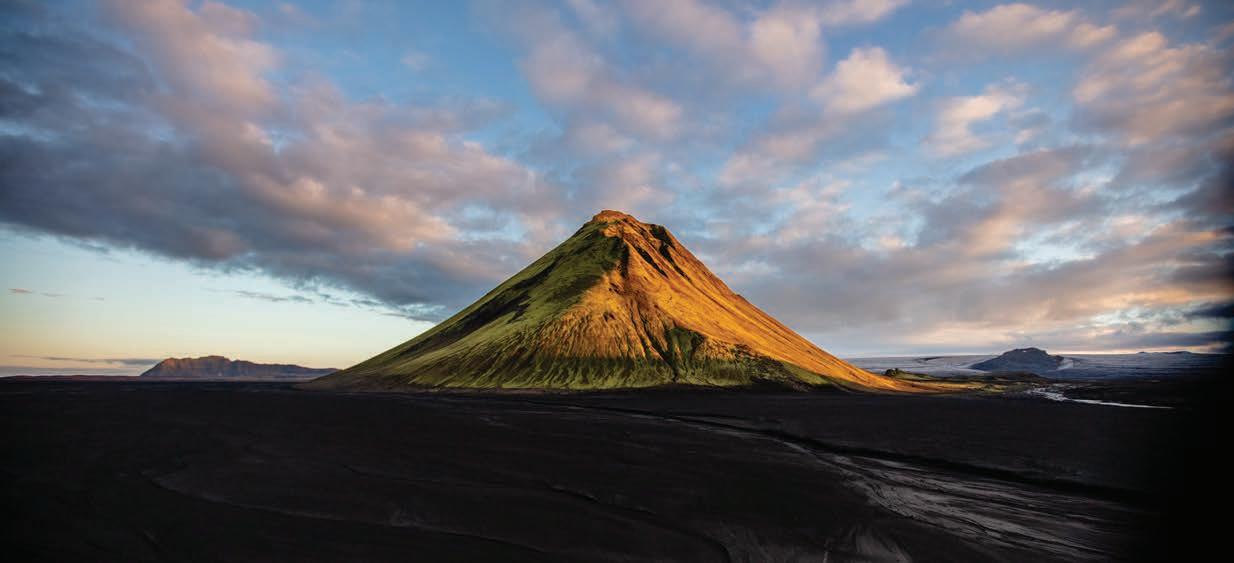
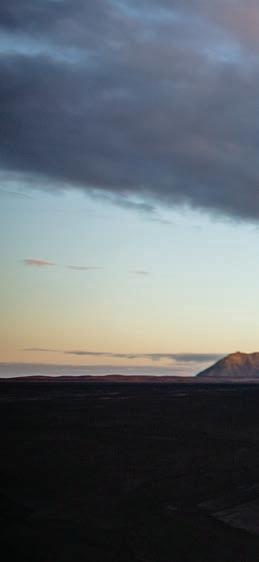

“I have two boys and both of them are blond and much whiter than I was as a kid,” Logi explains. “Seeing

Logi believes that the reaction would be very different today than in 2004 and an ongoing conversation about
them made me understand that we have all these definitions that don’t really matter. It makes no difference whether my blond son defines himself as black or white.”
Logi remembers vividly the debate that raged when, in 2004, Sheba Ojienda, a woman of colour, appeared on the cover of the Reykjavík Grapevine dressed in the traditional costume of the Fjallkonan – the female embodiment of Iceland. The image sparked a strong reaction in society and for weeks after little else
race and identity in this country helps foster a more inclusive society. “I think a big part of living in a society like Iceland, which is going through big changes, is to not focus too much on it,” he says. “Not that we should ignore it. But we are going to work at it and we do that by having a conversation – one I hope my art can contribute to.”
UNDER THE GLACIER
The characteristically cynical Halldór Laxness once wrote “soon times will be better, with flowery fields and
was discussed. The uproar saw the Grapevine receive hate mail from enraged Icelanders and international neo-nazi organisations who like to consider Iceland a bastion of “whiteness.”
“We need to understand that it is all nonsense,” Logi says matter of factly.
“Anger is a big mover when it comes to nationality, race, sexuality, identity, etc. But when we remove that anger, everything becomes funnier. I could be angry about the discussion happening when [Sheba] was Fjallkonan. I remember the debate well. But I now understand that anger is not a good way to approach things.”
“People are all programmed a certain way and in a sense we need to have sympathy with them, because I believe it is much better to tackle issues with sympathy than with anger.”
sweet, long summer days.” Perhaps being an Icelander is sharing the feeling of the oft misplaced optimism that drove people to settle on this rock in the north Atlantic 1000 years ago. Perhaps that is a requirement to make it through the darkness of winter, waiting for a summer that is always around the corner. The sort of maniacal optimism that births a nation that celebrates the first day of summer in April, yet routinely experiences frost in May.
As we barrel through the 21st century, the isolation that marked most of our history is gone. Iceland is becoming ever more international and diverse. It’s up to us as a nation to see how this diversity enriches our culture. It is up to us to look in the mirror and ask ourselves who we are and what sort of a country we want to be.
The Reykjavík Grapevine 6 / 23 14 Feature
ON THE ULTIMATE FLYING RIDE OPEN EVERY DAY | flyovericeland.com
I have two boys and both of them are blond and much whiter than I was as a kid. Seeing them made me understand that we have all these definitions that don’t really matter. It makes no difference whether my blond son defines himself as black or white.
We didn’t want to take the activist approach to art – we wanted to put the issue of what it means to be Icelandic into the hands of the audience, to make them face that question.
The Grapevine’s Top Picks
SKJALDBORG: ICELANDIC DOCUMENTARY FILM FESTIVAL
May 26–29
Patreksfjörður
10.000 ISK
Are you into watching real things happen on screen? Not that Love Is Blind shit, we’re talking fully unscripted, no producer interference, anything can happen realness. You just might be a documentary fan. Since 2007, the Westfjords hamlet of Patreksfjörður has become synonymous with documentary cinema, hosting a festival dedicated to the genre over the Whitsun weekend each year. International guest speakers, masterclasses and parties abound. If you love docs and need an excuse to head west, look no further. RX
Finding Inspiration
WORDS Catharine Fulton
decentralized, with happenings unfolding in various locations around Reykjavík, giving companies the
setting,” Melkorka elaborates. “I think that’s what Iceland and the festivals we hold here offer: this

mance really come into play. Named for Ok, the most recent ice cap in Iceland to melt to the point of losing its glacial status, Ok, Bye intertwines serious discussion about the climate crisis and the role of innovators in alleviating environmental stressors, with thematic artistic, visual and musical performances.
CARMINA BURANA
Thursday, June 1
20:00
Harpa Eldborg
2.700–7.700 ISK
That iconic opening boom of timpani, the explosion of a choir bellowing “O Fortuna!” Who doesn’t recognise this iconic piece of music as Carmina Burana? If you aren’t familiar with Carl Orff’s adaptation of medieval manuscripts about drinking, loving and God, then surprise surprise: that song is just the tip of the iceberg! The Iceland Symphony Orchestra, several soloists and six of the finest choirs in Iceland will perform the entire epic symphony for one night only. Don’t miss it. RX
Iceland has a shockingly flourishing startup scene for such a small country. Or maybe it’s not surprising at all and the island’s small size necessitates the individual creation of new creative and business ventures to avoid stagnation. Whatever the reason, the entrepreneurial landscape appears to be in constant bloom.
opportunity to play host and attendees a chance to see more than an auditorium.

“We have everything from karaoke parties in a startups headquarters to panel discussions about innovation in the public sector,” Melkorka says of the agenda. “We have a failure night, where people from different companies talk about their failures and fuck up stories, and we have nights dedicated to climate talks and so on.”
cool and quirky atmosphere where everything can happen serendipitously.”
FIVE THEMES AND A STAGE PRODUCTION
ACIDFEST ICELAND

May 20–21
Gallery Kaktus, Akureyri
Free
May 25–27
Various locations in Reykjavík
Free–2.700 ISK
Tune in and drop out at the second edition of Acidfest Iceland, a music festival dedicated to trippy music and good vibes. Put on by the Liverpool Psychedelic Society and Creation Dream Machine, the first edition took place on Snæfellsnes last year. This time it’s hitting Reykjavík and Akureyri, with a lineup of over a dozen bright artists – the perfect adventure for musical discovery. The Reykjavík events will take place at 12 Tónar, Kex Hostel, Lucky Records, Lemmy and Gaukurinn. RX
Enter Iceland Innovation Week, an annual festival celebrating and showcasing innovation while promising “insights into the dynamic world of Icelandic venture capital and funding trends from top industry experts.” Founded in 2019, the IIW is happening again May 22 to 26, promising opportunities for startups to connect with potential investors and solution-minded entrepreneurs to rub shoulders with policy makers and other agents of change.
“All the other Nordic countries have huge festivals aiming to showcase their innovation scene,” says festival director Melkorka Sigríður Magnúsdóttir. “Iceland didn’t have anything like that, so that’s kind of how it all started.”

BUSINESS, BUT MAKE IT QUIRKY
Melkorka wasn’t interested in founding an event that would usher hundreds of delegates into a stuffy room for long days of talks and presentations. Instead, IIW is
As Melkorka explains it, the vibe the IIW team is aiming to capture is akin to the sense of discovery one would get in the early days of the Iceland
All the talks, events, happy hours and other happenings throughout IIW fall into one (or more) of the festivals five themes: Fun & Games, highlighting startups in the gaming and entertainment sector; Greener Than Green, which includes innovations tackling the climate crisis; Everybody Loves Everybody, dedicated to discussions of diversity; Techno – Tech Yes!, which (you guessed is) is all about the wonders of technology; and Food Mood, focussing on innovation
“We wanted to create something that’s like going to the theatre. So we created a concept for the year and then we create a script around all our speakers who are coming and all the topics that they’re addressing,” Melkorka says of the performative approach to a climate conference. “So last year, we welcomed everybody to an Icelandic campsite recreated on stage and this year we’re welcoming everybody to an Icelandic oceanfront, where we were going on a boat trip to learn about the ocean and the problems and challenges we are facing.”
“I think Iceland is a perfect place to discuss these things because this is literally where we can see the glaciers melting in front of our eyes and the sea levels rising.”
READY TO BE INSPIRED
Melkorka is expecting 700 attendees at this year’s festival – half of them coming from abroad – including founders, investors and policy makers. But it’s not strictly an event for those with an established business on an upward trajectory or with big money to throw around. It’s an equally good opportunity to learn, network and maybe dust off that startup idea you’ve had kicking around the back of your mind.
As Melkorka says, “it’s a place for everybody to get inspired.”
Airwaves festival, when you could stumble into a bar or storefront and happen upon a performance from what could be the next big musical superstar. “We want you to be able to almost randomly pop into an office for a happy hour and see the CEO of the next big unicorn company talking in a more intimate
in food and drink production. Also wrapped into the week’s agenda are the Nordic Startup Awards. Then there’s the climate conference within the festival.
Ok, Bye is where Melkorka’s background in choreography and perfor-
Iceland Innovation Week takes place May 22–26, at Gróska and several other locations in and around Reykjavík. Check out the full schedule and buy festival passes at InnovationWeek.is. Many of the week’s happenings are open to the public, too.
15
IMAGE Supplied
I think Iceland is a perfect place to discuss these things because this is literally where we can see the glaciers melting in front of our eyes and the sea levels rising.
We want you to be able to almost randomly pop into an office for a happy hour and see the CEO of the next big unicorn company talking in a more intimate setting.
Iceland Innovation Week returns to showcase the big ideas of Icelandic startups
THIS IS ICELAND


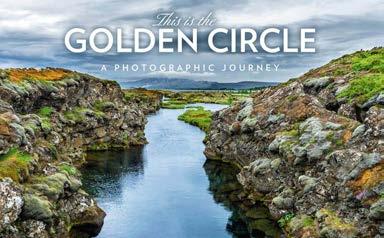

Katrín Elvarsdóttir
The Singing Fish Circus Takes New York
WORDS Jóhannes Bjarkason IMAGES Patrik Ontkovic
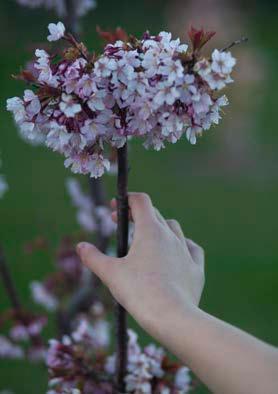
06.05.–08.07.
Fimmtíu plöntur fyrir frið Fifty Plants for Peace
of artists ventured from Reykjavík to New York. What followed was a celebration of experimental music, ephemeral literature and untethered creative expression.
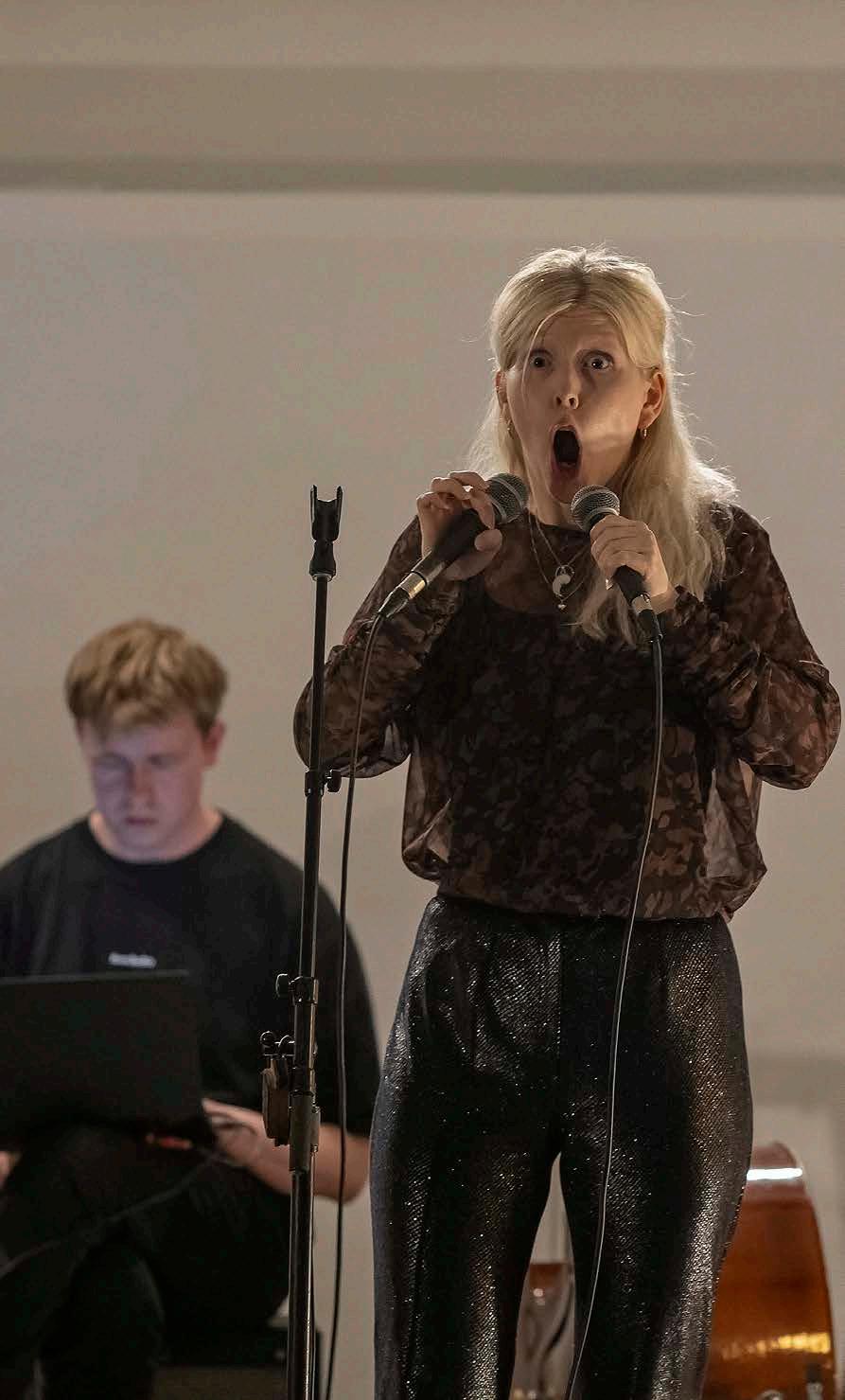
BURNING BOOKS
On a sticky New York afternoon, author and Moon Publishing organiser Ragnar Helgi Ólafsson sits on
in limited numbers, for this night’s event there were 69. Those who don’t sell are discarded – burnt even. “The idea is not to aggravate. It’s a poetic act, not a political one,” says Ragnar.
Mengi is a firmly rooted art space in Reykjavík, operating on the juncture of visual art, music and performance art. A trusty hub of all things experi-
Big cars, bright lights. The apple that never sleeps. Taste of Iceland – a cultural festival produced by the marketing platform Inspired by Iceland – brought artists, poets and musicians from the Mengi collective and Tunglið publishing house to New York May 12 and 13, for a celebration of both organisations’ 10th anniversaries. Dubbed The Singing Fish Circus, the 12-man strong troupe
the deck of the artists’ Airbnb. “This is an idea that sort of sprung up. I had been chatting with the folks at Mengi about doing something like this for a while,” Ragnar says.
Moon Publishing is not your run-ofthe-mill publishing company; authors and poets commence their work at the start of a lunar cycle and publish at the end of it. Copies are printed
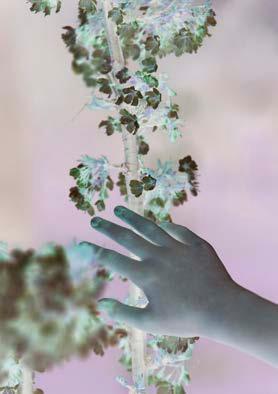
mental, performances by musicians associated with the venue is often characterised by improvisational methods.
Luring would-be visitors with the promise of a night of wonder and artistic exploration, Mengi kicked off the Singing Fish Circus on Friday night. An empty Williamsburg storefront had been transformed
The Reykjavík Grapevine 6 / 23 16 Culture
Culture Feature
Icelandic exceptionalism in the big apple Forlagið bookstore | Fiskislóð 39 | www.forlagid.is ICELAND’S LARGEST BOOKSTORE
Memories from Iceland that ft into your pocket!
It’s an art space, everything’s allowed
into a gallery space; the contents of the Art Crate – a literal box full of art pieces set to travel the world – were displayed on both gallery floors. A massive sea of cables, cords, pedals and instruments of all shapes and sizes covered the innermost part of the space. The night opened with a DJ set consisting exclusively of 78 rpm vinyl records played by Ingi Garðar Erlendsson. Spooky voices of long-dead singers reverberated off the gallery walls.
A MENGI VIBE IN BROOKLYN CLIMATE
The performing artists showcasing the Mengi talent were ASALAUS, Ásta Fanney, Bára Gísladóttir, Benni Hemm Hemm and the Melting
Hemm assumed the role of a singer with double bassist Bára Gísladóttir; Ásta Fanney made throat noises on top of ASALAUS’ dispersed guitar playing.
This felt like the highlight of the show and, in a way, evocative of Icelandic music. People imbued their personal skills and talents into their friends’ performances, making for a wholly unique experience. The artists experimented and improvised. Nothing was wrong, everything was allowed.
“It has a Mengi vibe,” remarked the Grapevine’s photographer.
One unexpected difficulty arose: the venue did not have a suitable bass amp. “It’s ok though,” said
How serendipitous for a chapter about communicating with the dead to be interrupted by a funeral procession.
Diamond Band, Guðmundur Ari Arnalds, Gyða Valtýsdóttir, Ingi Garðar, Kristín Valtýsdóttir and Páll Ivan Frá Eiðum. Each artist brought their unique style and setlists, but the happening was defined by the fluidity of collaboration. Benni Hemm
Guðmundur Ari, a Mengi curator and member of Final Boss Type Zero. “I’ll adjust my Ableton set.” Which he did, roughly 30 minutes before going onstage.
During Kristín Valtýsdóttir’s set,
screeching feedback erupted from a guest’s phone. “It’s all right,” Kristín remarked behind her keyboard – still playing, “If you’ve been here tonight you should know it’s ok. It’s an art space, everything’s allowed.”
One highlight of the evening was Ásta Fanney’s performance. A poet and visual artist, Ásta Fanney improvised most of her set, which ranged from making strange rasping sounds to delivering a hauntingly beautiful ballad. “Everything surprised me. Everything was improvised, just done on the spot. No one knows what happens until it does,” said Ásta Fanney after her performance.
The crowd, which was comprised of both local New Yorkers and Icelanders, was enchanted. The artists were riding high after the show, but jet lag soon took over, commanding them to the refuge of their beds.
TEMPORARY LITERATURE
On Saturday morning, the troupe met at their apartment to rehearse for the evening. Ásta Fanney brought matching grey flannel shirts for the artists, who started stretching and warming up for a rehearsal. There was no way of knowing what the evening had in store, neither for the audience nor the artists. It was
Tunglið’s time to shine, debuting three new English-language literature pieces: “A Hyena Called Yesterday” by Ásta Fanney, “My Father’s Library” by Ragnar Helgi (an English translation of an earlier book), and “Raw Salon – Sitcom,” by Canadian-born Icelandic citizen Anne Carson.
Earlier on Saturday, both Ásta and Ragnar had participated in a panel discussion of their books and the Icelandic literature scene. It was at the panel the Icelandic authors mentioned the ephemeral nature of their work and of Tunglið’s entire operation: The books are not meant to be everlasting, catalogued and kept in a library for the end of days. They represent intense creative outbursts, which come and fade away. Ásta read an excerpt from her book, “Hyena Called Yesterday,” and the morning’s rehearsal started to make slightly more sense.
With a few welcoming sentiments and a note on the nature of Tunglið, Ásta was first to hit the stage. Capturing the audience’s undivided attention, Ásta’s set sprung to life. As she read, the flannel-clad ‘hyenas’ took turns walking around the room, shouting “I want what’s best for me,” while a blow-up globe was thrown around the pristinely white
gallery. A book reading like no other, it brought a deep dimension to an otherwise routine format.
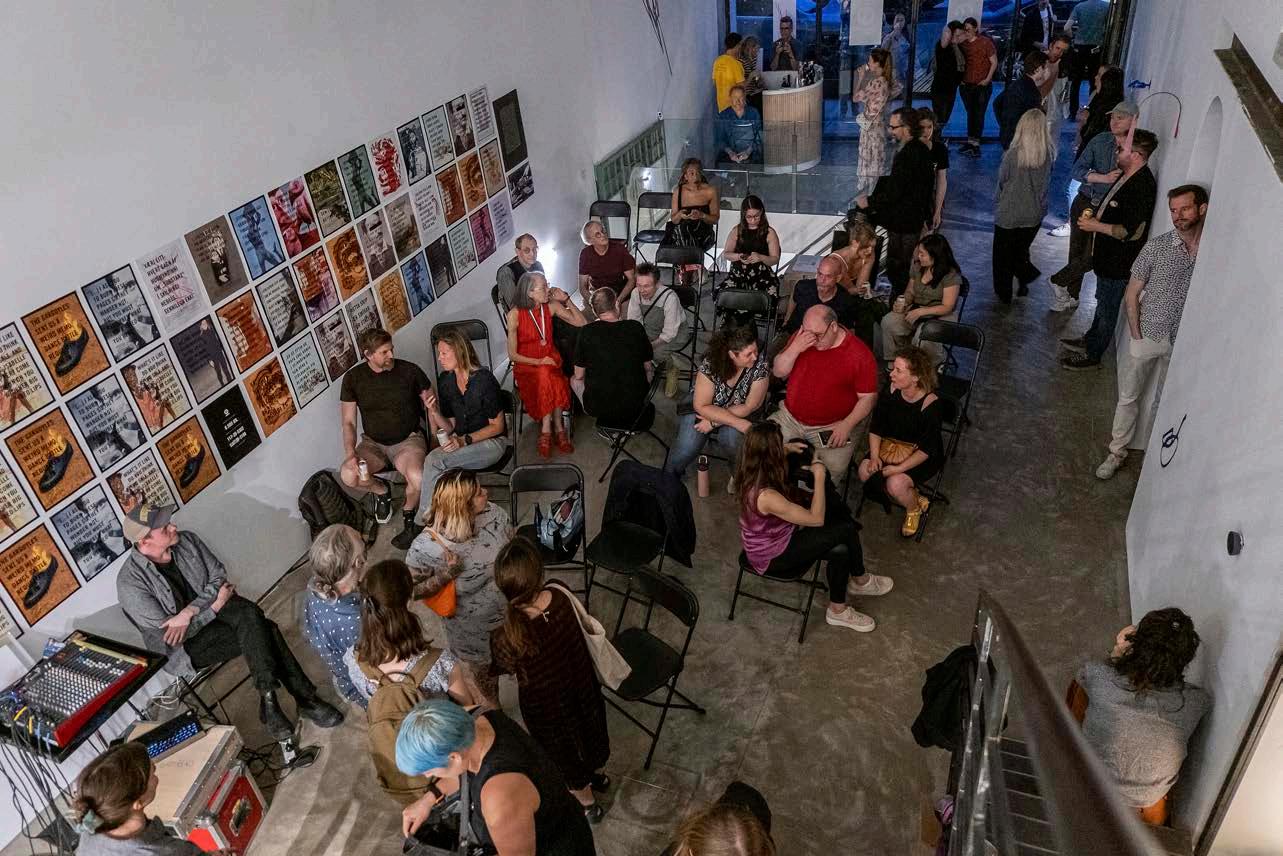
It might have been right after a chapter reading of Ragnar Helgi’s book, or maybe before – everything seemed blurry – when faint singing could be heard from outside. Almost angelic, the singing grew and grew, reaching a peak when the sound’s source came into view.
The audience grew silent. The performers paused. Did Ragnar Helgi plan for this? Before anyone could voice their questions aloud, a long line of people dressed in white marched past the gallery space. Led by what presumably was a priest, four people carried a small white ark, while the ecclesiastical gathering sang hymns.
“How serendipitous for a chapter about communicating with the dead to be interrupted by a funeral procession,” remarked Ragnar after the show.
The weekend was a success, at least in the minds of the performers. “An artistic triumph; a commercial failure,” said Ragnar. Having conquered New York, The Singing Fish Circus plans on taking on other cities in the future.
17 Culture
Best Newcomer* Book a table on brut.is Best Seafood* Best Brunch* Pósthússtræti 2 Brút - Brút - Brút - Brút - Brút - Brút - Brút - Brút - Brút - Brút - Brút - Brút - Brút - Brút - Brút - BrútBrút - Brút - Brút - Brút - Brút - Brút - BrútBrút - Brút - Brút - BrútBrút - Brút - Brút - Brút - Brút - B út - Brút - Brút - BrútBrút - Brút - Brút - Brút - Brút - Brút - Brút - Brút - Brút - Brút - Brút - Brút - Brút - Brút - Brút - Brút - Brút - Brút - Brút - Brút - Brút - Brút - B út - Brút - Brút - Brút - Brút - B út - Brút - B út - Brút - Brút - Brút - Brút Brút Brút - Brút - Brút - Brút - Brút - Brút - Brút - Brút - Brút - Brút - Brút - Brút - B út - Brút - Brút - Brút - Brút - Brút - Brút - B út - Brút - Brút - Brút - Brút - Brút - Brút - Brút - B út - B út - B út - B út - Brút - Brút - Brút - BrútBrút - Brút - Brút - Brút - Brút - B út - Brút - Brút - Brút - Brút - Brút - Brút - Brút - Brút - Brút - Brút - Brút - Brút - Brút - Brút - Brút - Brút - Brút - Brút - B út - Brút - Brút - Brút - Brút - Brút - B út - Brút - Brút - Brút - Brút - Brút - Brút - Brút - Brút - BrútBrút tseB remocwen tnarutsertseB b ur n c hBest seafood resturantBest rest u r a n t*BestofReykjavik - Grapevi ne 2022 +354 537 2788
WORDS Iryna Zubenko
IMAGE Art Bicnick
In a quest to better understand how movies are dubbed in Iceland, we find ourselves in front of an unremarkable building in the industrial block of Hafnarfjörður. Contrary to its unassuming exterior, Myndform holds a delightful surprise within its rugged exterior: an in-house cinema and walls adorned with beloved cartoon characters. Eager to show us around is studio manager Bjarki Gunnarsson. As the first door opens, I catch a glimpse of a new episode of Moominvalley on the screen – this is a movie geek’s version of Disneyland.
pany, he was hooked. “I started as a driver, then I was working on replication of VHS cassettes. Since then I have been just going from this to that. Now I manage the production department, which includes dubbing, subtitling, graphic design and much more,” he says.
The dubbing market in Iceland is really small, hence, the price for recording, syncing and dubbing can amount to about 6–7 million ISK per project. This excludes the price for mixing, which is usually handled by film production companies abroad.
Costs aside, how do the movies in Icelandic come to life? What does it feel like to see a highly anticipated movie before anyone else? And do you need to be a native Icelandic speaker to do the job? Bjarki has all the answers.
BEHIND THE MIC
“The process starts quite early. It can start one year before the release,” he shares. “Usually, we get key names and phrases we have to translate.” Film productions often release toys
movies, precision in voice matching is crucial. “Even if the character is small, it could be big in the next movie,” Bjarki explains, highlighting the importance of thinking ahead for this industry.
The next stage of the process is dubbing the trailers, followed by the movie translation and recordings.
“When we start recordings, we have to send selected scenes to them [Universal Pictures or other film production company]. They listen to the scenes, check the quality, and if the actor is matching what they want, they send us a review,” Bjarki shares. “There’s a lot of pressure to keep the quality high.”
It can take multiple takes for a voice actor to achieve a perfect lip sync. “They have to listen, watch, read, and act at the same time,” Bjarki laughs. “That’s why I’m not doing it.”
GIVING VOICE TO ICONIC CHARACTERS
The Super Mario Bros. Movie is the latest and – judging by local box office numbers – one of the most
“My kids waited way too long for the Mario movie,” says Bjarki, prompting me – momentarily pretending NDAs don’t exist – to ask if he couldn’t have just screened it for them. “No, I would like them to see it in the movie theatre in the best quality and completely ready,” Bjarki says. “Sometimes we get the film when it’s not ready,” he turns on his computer and shows us a short clip with the type of half-made animations that Myndform usually receives to start working on the lip sync. “It’s not so much fun to watch.”

FROM LE Ð URBLÖKUMA Ð UR
TO BATMAN
In an effort to preserve and popularise the Icelandic language, Iceland has a long history of linguistic and cultural adaptation in translation. It wasn’t that long ago that popular superheroes like Batman or Spiderman were known as Leðurblökumaðurinn and Köngulóarmaðurinn, respectively. These days, things have changed – Batman is just Batman, and, much to my disappointment, Super Mario is just Super Mario. Bjarki explains that due to toy sales and other marketing tools, it is more common that film productions veto the translation of proper names.
says Bjarki as he highlights the involvement of actor and writer Gói (Guðjón Davíð Karlsson) as the voice of Mario. “ There are also many very good musicians that tend to be very good dubbing actors,” Bjarki says, mentioning popular singer Eyþór Ingi Gunnlaugsson’s foray into the world of dubbing. “He was doing Gru for Despicable Me. There were brothers, Gru and Dru, and he did both brothers. It was quite good!”
According to Bjarki, fluency in Icelandic is a must for quality dubbing. He shares a case where the original voice actor was Asian and the film production insisted on having an Asian voice actor for the Icelandic dub. “We were like ‘Hey, we don’t know anyone who’s Asian and who can do dubbing in Icelandic,’” Bjarki shrugs, adding that he doesn’t recall any foreigner throughout his career who would be able to work with dubbing in Icelandic.
MANY MORE DUBS TO COME
Myndform is one of two companies in Iceland that provide dubbing services for movies. Dubbing? In Iceland? You’re right to be slightly surprised it’s a practice here – films are typically screened with their original audio accompanied by Icelandic subtitles. However, there is an exception when it comes to children’s movies and cartoons. Since its founding in 1984, Myndform has expanded from four to about 30 employees, establishing a fancy recording studio and amassing a portfolio of big-name projects along the way.
Bjarki has been with the company for almost 25 years. He admits it was only meant to be an in-between job, but once he got to know the com-
to promote the movie, Bjarki explains, “That’s the time when they start planning everything.” Then, the company runs some voice tests and does voice recordings. For each actor, Myndform has to suggest three voices before sending it to the film production for a review.
“The final decision is not with us,” Bjarki admits, but adds that usually, film productions are very responsive to comments from the Icelandic side.
Even for small characters in dubbed
successful projects Myndform has ever worked on. A big Mario fan myself, I’m curious how the project panned out?
“The challenge was that Nintendo was very picky. There was lots of uncertainty in the beginning,” Bjarki admits. “I grew up with Mario, so that was special for me. For most of the cast it was nostalgia. Otherwise, I think it was quite basic, just like any other movie. Except that everyone said ‘all eyes are on this one,’” he says.
“Myndform started with dubbing in 2011, and since we got started, it has been like this. I think they sell more toys than they sell movie tickets,” he smiles, adding: “In Iceland, at least.”
“We try to dub everything that we can,” says Bjarki. “If we are allowed to do the names, we do the names. If we’re allowed to do the songs, we do the songs. We try to make it as Icelandic as possible.”
ONE ACTOR, MANY VOICES
Bjarki boasts that the quality of dubbing in Iceland is very high. “The film productions often give us comments that Iceland has one of the best dubs in the world,” he says proudly.
The community of dubbing actors in Iceland may be small, but it is very professional. “We are lucky that we can use the best actors in Iceland,”
Bjarki doesn’t hesitate for a second when asked about his biggest dubbing projects. “Minions,” he responds immediately. “And Super Mario,” he adds. “Trolls was also complicated because there was singing. The singing projects are usually the hardest.”
In addition to dubbing in Icelandic, Myndform has also dubbed over the Icelandic for two Netflix series – Katla and Ófærð (Trapped). On request of director Baltasar Kormákur, they were dubbed in English by the original Icelandic cast.
After wrapping up The Super Mario Bros. Movie, the company has already started working on its next big projects – Trolls 3, Migration and Ruby Gillman, Teenage Kraken.
“This is an interesting job. You meet lots of creative people. This industry is very fun to work with. It keeps changing a lot,” Bjarki smiles. “There’s always something new and new movies all the time. That’s why I’ve been here so long.”
If we are allowed to do the names, we do the names. If we’re allowed to do the songs, we do the songs. We try to make it as Icelandic as possible.
Dance, Sweat and Share
to a strong community that fosters sharing, collaboration and exploration. It’s these values that underscore the new Dansdagar (“Dance Days”) festival, hosted by the IDC and the independent dance studio Dansverkstæðið
The field of dance in Iceland has long been a thing of mystery. But over the past decade, it’s emerged from the underworld with remarkable speed. The Iceland Dance Company (IDC) celebrated its 50th anniversary on April 29 – it’s the unofficial “anniversary of dance” in Iceland – and the contemporary dance

“Dansdagar is a celebration. The driving idea was to embrace the dance community, gather, dance, sweat and share,” says Erna Ómarsdóttir, artistic director of the IDC and an icon of dance and choreography.
“To use these few days to create an atmosphere of energetic and interesting dance workshops. To allow people to go from one type of dance class or dance workshop into
She describes the festival as an opportunity for people in the dance community and those connected to it to break out of their comfort zone and explore what and who else is out there.
Loosely modelled on festivals like ImPulsTanz in Austria and Deltebre Dansa in Spain, Dansdagar is the first such workshop-based dance festival in Iceland. “These are the biggest summer workshops and it is always such a great atmosphere,” Erna says about the aforementioned events. “It’s such a melting pot of dancers coming from all over the world – teachers, choreographers and dance artists. The dream was to
the theatres during the summertime.”
Dansverkstæðið and the IDC will share their spaces, studios and stages to host the workshops and performances, with some designated for professional and pre-professional dancers, and others fully open to the public. The event fills a gap in the dance world that has only recently begun to open. “Perhaps the need was not there before as the scene was much smaller,” says Tinna Grétarsdóttir, general manager of Dansverkstæðið. “Now that we have so many more freelancers, there is a need.”
adoption and participation. “Dance is definitely growing and becoming more and more accepted,” says Erna. “I believe the scene will grow stronger in the upcoming years. We hope that this will grow into a huge festival in the future with dance artists gathering from all over the world to share their knowledge and skills. It could become something truly amazing. There’s so much talent in this scene and we need to nurture this. Dance has something unique to give.”
Dansdagar takes place May 29 to June 2. Follow IDC and Dansverkstæðið for more details as they emerge.
Powering the Future Energy Exhibition
An interactive exhibition for the whole family, located at Ljósafoss Power Station, just a 50 min drive from Reykjavík.
The Energy Exhibition is open every day from 10 AM – 5 PM. No admission fee. landsvirkjun.com/energy-exhibition

19
WORDS Rex Beckett IMAGE Art Bicnick
Dance
The new festival Dansdagar pops the safety bubble
Centre Map
We're here to fill you in on our personal favourite places around town – and a few to consider avoiding.
Dining
1 NAPOLI Tryggvagata 24
We love places that do one thing and do them damn well. This takeaway place is a case in point. Napoli offers sourdough Neapolitan-style pizzas with a menu to match – think margherita, quattro formaggi, parma, calzone – plus vegan options and magnificent sandwiches. Look out for their lunch offer, every day from 11:30 to 15:00. JT
2 GAETA GELATO Aðalstræti 6 & Hlemmur Mathöll
Gaeta Gelato is at the centre of a heated ongoing debate at the Grapevine office about who makes the best ice cream in the country. For those keen on the deep tastiness of Italian gelato, this place is IT. They are also located right smack downtown, so you can take that icecream for a stroll – we suggest a stroll to their other location for another scoop. JT
3 PLANTAN Njálsgata 64
This cute little neighborhood cafe is 100% vegan and does a few things right: their soup of the day menu updates every week and uses seasonal produce, they mastered the plantbased cheese bun recipe to perfection, and this might be the most hearty vegan brunches in town. Look out for the daily bun and coffee deal, it truly is like a warm hug. IZ
4 BRAU Ð & CO. Frakkastígur 16 (and other locations)
If you’re dying to have some of the finest pastry, look no further than Brauð & Co. Although the bakery has several locations around town, our hearts are devoted to the Frakkastígur one. You have to try their pretzel croissants, vegan cinnamon rolls, and weekend specials. There’s nothing quite like sitting on a bench at the intersection of Njálsgata, Frakkastígur, and Kárastígur, sipping coffee and enjoying the sun. A true weekend essential! (Beware of windy weather, as some of our team members may or may not have had their pastry stolen by the wind at that exact spot.) IZ
5 CAFÉ BABALÚ
Skólavörðustígur 22
This quirky café hangout is a great choice when you’re looking for a cozy, chill experience. Decked with kitschy decor and plush chairs, the café is perfect for a refuge from an instant shower of rain. If you’re looking to snuggle up with a book and a good cup of coffee, look no further. JB
6 BAN THAI

Laugavegur 130
The absolute GOAT – as they say – in Thai cuisine in Reykjavík. Ban Thai’s menu is dotted with little symbols of chili, denoting the spice level of each course. You’re welcome to order a level-5 chili course, but do so at your own risk. JB
7 GRÁI KÖTTURINN Hverfisgata 16a
This no-nonsense downtown staple has been serving Reykjavík dwellers quality breakfast food since 1997. Tucked away in a cute cellar, the diner boasts retro Icelandic design charm, while its menu is far from outdated. Pancakes, bagels, and frying oil all have their special place at Grái Kötturinn. As Grái Kötturinn closes at 14:30 every day, it’s not a place for nighthawks, but early-birds. JB
8 CHICKPEA Hallveigarstígur 1
This Mediterranean-inspired restaurant is a great place for a quick bite. Servings are generous and the food nutritious, meaning you’ll go full well into the day. They do wraps, falafels, and all kinds of salads exceptionally well. Prices aren’t extremely steep, but nothing to write home about either. JB
9 KRÓNAN Hallveigarstígur 1 & more locations
If you’re ever in a pinch while looking for something cheap to eat if you’re downtown just go to Krónan and pick out some flatkökur. Flatkökur goes great with everything. Be it the Mediterranean/Icelandic fusion of lathering some with hummus, or turn it into a poor-man’s pizza with pizza sauce and cheese. Honestly, the flatkaka is an empty canvas for you to paint your wildest dreams on. JB
Drinking
10 APERÓ VÍNBAR
Laugavegur 20b
A wine bar that is both opulent and accessible? Yes please. The small team at Aperó remember the orders of regulars and make first-timers feel like regulars. If you know what you like, Aperó will tick your boxes; and if you’re new to wine, the sommelier will soon unite you with your ideal glass. CF
11 KEX HOSTEL Skúlagata 28
The former biscuit factory now serves as a trendy hostel, with a bar, restaurant, and a live concert space. There’s always something going on, and if not, it’s a great spot to grab those after-work drinks. With a rotation of foreign tourists who stumble onto a heavy metal show happening in the restaurant, you’re always bound for an enjoyable experience. JB
12 KAFFIBARINN Bergstaðastræti 1
No words are needed for Kaffibarinn. The hangout spot for the who’s who of Reykjavík. Frequented by Blur members in the 90s, drug dealers, and middle-managers, Kaffibarinn is an establishment in itself. JB
13 VITABAR Bergþórugata 21, Iceland
If you’re staying in Reykjavík more than a few days, you ought to find your own dive bar – this is ours. It seems like the time froze at Vitabar, but we love it that way. People come for their famous blue cheese burger, but stay for a few pints and delicious fries. Sometimes I wish Vitabar discovered craft beer, but I go back nevertheless – for a late night bite and Thule on draft. IZ
14 VÍNSTÚKAN TÍU SOPAR
Laugavegur 27
There are a few bars in Reykjavík that have learned how to do wine right, and Vínstúkan Tíu sopar, although located in the middle of the chaos and tourist buzz of Laugavegur, is one of them. Craving Pét-nat? In the mood for orange wine? Ready to explore small Slovenian wineries? You name it – the bar’s staff will be ready to come up with suggestions that will suit any pocket. Don’t get me started on their small bites to pair with wine – I’m already dreaming about their grilled peppers and torched broccoli with salted lemon. IZ
Shopping & Activities
15 BÍÓ PARADÍS Hverfisgata 54
Sometimes the smell of popcorn fills the air of Hverfisgata, as if beckoning you to come inside. You succumb and find yourself in the cutest art house cinema with colourful posters on the walls and vintage-looking bar straight outta Wes Anderson movie. There’s always a film screening and you rarely need to book tickets in advance, so enjoy the old school walk-in experience and one of the best Happy Hours in town. IZ
Random Spots
16 EINARSGAR Ð UR Laufásvegur 79
This little green space nestled into the curving juncture of Laufásvegur and Gamla Hringbraut is an oasis in the city. Exposed to full sun seemingly all the time, it’s a peaceful spot to stroll through, climb trees, luxuriate on the grass or toss the ball for your four-legged friend. Don’t do that last thing, though. It’s not allowed. CF
Be Warned
17 101 BISTRO Austurstræti 3
The bistro on the corner of Ingólfstorg and Austurstræti that has a plaque outside saying, “Come in and try the worst [insert popular food item] that one guy on Tripadvisor said we had”, or something like that. It’s a trap, do not go there. That plaque has been in the same spot ever since Hrunið RG
18 SBARRO Austurstræti 17 & Vatnsmýrarvegur 10
“What is this shit?” is how Greil
Marcus famously opened his review of Bob Dylan’s 1970 album in Rolling Stone. It is appropriate here. It looks like pizza, it is sold as pizza, it’s priced like foie gras, but it tastes like salted shit. Avoid. RG
19 REYKJAVÍK FISH RESTAURANT Tryggvagata 8
Our beef with this place has to do with their “plokkari” (Traditional Icelandic Fish Stew). The fish stew is what you make out of fish leftovers and potatoes, adding bechamel sauce, topped with cheese and then baked. It’s generally a good dish, a great way to avoid wasting food and it costs next to nothing to make. Taste wise, there is nothing wrong with how Reykjavík Fish makes their “plokkari”, the problem is that the volume you get for the price is unacceptable; a tiny cast iron pan of fish stew for 2.690 ISK. An outrage. RG
20 LEBOWSKI BAR
Laugavegur 20a
A joke that’s gone too far. The longest lasting theme bar that sprung up during a theme-bar craze many years ago. It is the only place in Reykjavík where I’ve witnessed a grizzly physical assault, pickpocketing and generally bad vibes. The Dude does not abide. RG
The Reykjavík Grapevine 6 / 23 20 Map FÁLKAGATA STURLUAGATA EGGERTSGATA LYNGHAGI STARHAGI VESTURVALLAGATA MÝRARGATA NÝLENDUGATA ÞORRAGATA EINARSNES BAUGANES SKILDINGANES SUÐURGATA HRINGBRAUT FISKISLÓÐ TJARNARGATASUÐURGATA LJÓSVALLAGATA HÓLAVALLAG. SÆMUNDARGATA FURUMELURBIRKIMELUR ESPIMELUR ÆGISGATA STÝRIMANNASTÍGUR NJAR VESTURGATARÁNARGATA BÁRUGATA ÖLDUGATA TÚNGATA TÚNGATAMARARG. SÓLVALLAGATA SÓLVALLAGATA HOLTSGATA HÁVALLAGATA HOLTSG. ÁSVALLAGATA REYNIMELUR
DUNHAGI ARAGATA ODDAGATA HAGAMELUR HOFSVALLAGATA ARSTÍGUR BRÆÐRABORG FRAMNESVEGUR SELJAVEGUR ÁNANAUST GRANDAGARÐUR GRANDAVEGUR LÁGHOLTSVEGUR ÆGISÍÐA FORNHAGI MELHAGI NESHAGI KAPLASKJÓLSVEGUR MEISTARAVELLIR ÁLAGRANDI EIÐSGRANDI HRINGBRAUT TÓMASARHAGI KVISTHAGI HJARÐARHAGI Nordic House Culture Center University of Iceland National Museum National Library Hólavallagarður Cemetary Reykjavík Domestic Airport Terminal Maritime Museum FlyOver Iceland Saga Museum Aurora Reykjavik Vesturbæjarlaug
GRENIMELURVÍÐIMELUR
Swimming Pool
A
Tipsý Bar & Lounge
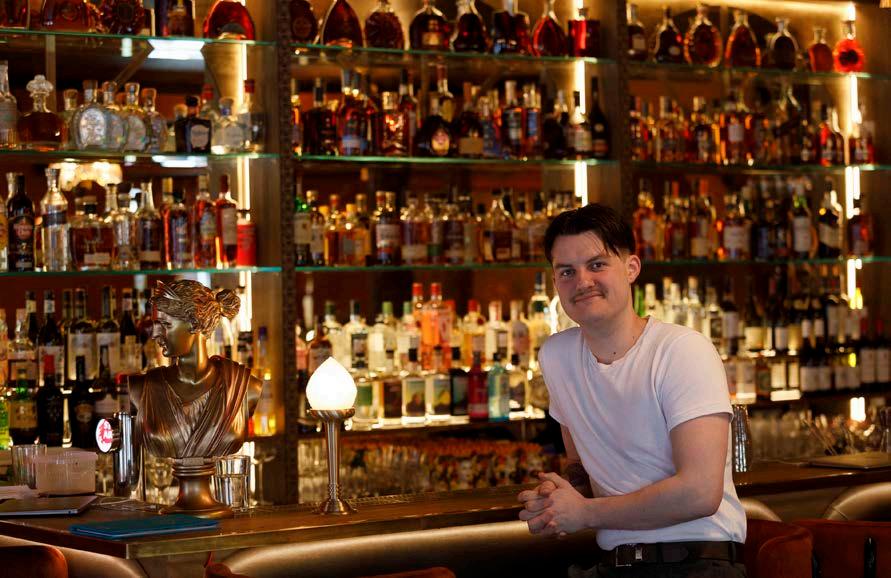




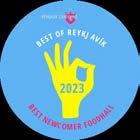

21 Map LAUGAVEGUR LAUGAVEGUR FLÓKAGATA HÁTEIGSVEGUR ÚTHLÍÐ AUTARH NÓATÚN LANGAHLÍÐ STAKKAHLÍÐ RAUÐAR ÁRSTÍGUR RAUÐ AR ÁRSTÍGUR ÞVERHOLT MJÖLNISH. ÁSHOLT STÚFH. TRA Ð ARH. GUNNARSBRAUT NÓATÚN KATRÍNARTÚNI Þ ÓRUNNARTÚN STÓRHOLTMEÐALHOLT STANGARHOLT STRÆTI SKÓLABRÚ LAUGAVEGUR BR OLT SKIPHOLT HAFNARSTRÆTI EIRÍKSGATA EGILSGATA HVERFISGATA LINDARGATA SÖLVHÓLSGATA SKÚLAGATA SÆBRAUT BORGARTÚN BRÍETARTÚN HÁTÚN MIÐTÚN SAMTÚN SÓLTÚN LOKASTÍGUR BALDURSGATA BRAGAGATA VITAST ÍGUR BARÓNSSTÍGUR SNORRABRAUT SNORRABRAUT BARÓNSSTÍGUR SKÓLAVÖRÐ USTÍGUR LAUF ÁS VEGUR LAUFÁSVEGUR FJÖLNISVEGUR FREYJUGATA SÓLEYJARGATA NJÁLSGATA GAMLAHRINGBRAUT VATNSMÝRARVEGUR HRINGBRAUT BERGÞÓRUGATA URGATATJARNARGATA AÐALSTR. GARÐ ASTRÆTI GRETTISGATA FRAKKAST ÍGUR NJARÐARGATA NJARÐARGATA VATNSSTÍGUR KLAPPARST ÍGUR BERGSTAÐ ARSTRÆTI BERGSTAÐARSTRÆTI FR ÍKIRKJUVEGUR P ÓSTHÚSSTRÆTILÆKJARGATA INGÓLFSSTRÆTIÞINGHOLTS STRÆTI ÓÐINSGATA ÞÓRSGATA VONARSTRÆTI AUSTURSTR. SKOTHÚSVEGUR TRYGGVAGATA GEIRSGATA VESTURGATA KIRKJU UR BANKASTR. BSÍ House Center Austurvöllur Icelandic Parliament Hlemmur Food Hall Sundhöllin Swimming Pool Landsspítali Hospital City Hall Hallgrímskirkja Church Listasafn Einars Jónssonar Ásmundasalur National Theatre The Culture House Bíó Paradís Reykjavík Art Museum Marshall House Grandi Mathöll Harpa Concert Hall Kjarvalsstaðir Museum Hljómskálagarður Park National Gallery VÍNSTÚKAN Wine bar & food PHOTOS FROM ICELAND Skólavörðustígur 22 Klappið app The official ticketing app for public buses in the Reykjavík capital area Search for "Klappid" in the App Store or on Google Play. New in Town
Hafnarstræti 1–3 Cocktail lovers rejoice: it’s time to get Tipsý! This new lounge is the latest addition to the downtown bar scene, freshly reclaimed from the puffin shop on the corner of Hafnarstræti and Naustin. With a lush, classy, vintage-feel décor – right down to the art-déco logo lettering – and proper mixologists sporting waistcoats, watch fobs and custom drink shakers, they are not messing around. It’s not for the inflation-weary budget, but definitely a perfect place for a relaxed evening of finely crafted libations when you’re feeling fancy. 1 A B C E D 2 2 B C D E 3 4 5 6 7 8 9 9 10 14 15 16 17 18 19 20 11 12 13
Art Exhibitions 19.05–01.06

Gallery openings, happenings, showings and pop-up exhibitions all around the capital region
Opening
i 8 GALLERY
Birgir Andrésson & Lawrence Weiner: Part II
Part two of the exhibition featuring work by Birgir Andrésson (19552007) and Lawrence Weiner (19422021, USA). The exhibition features installation, sculpture, painting and works on paper by Andrésson and Weiner, with each presentation highlighting examples from different mediums and eras of their careers.
Opens May 25
Runs until July 1
NATIONAL GALLERY OF ICELAND
Sigtryggur Bjarni Baldvinsson: Into the Valley in Late Autumn
The exhibition Into the Valley in Late Autumn is made up of large watercolours painted in the past two years; artist Sigtryggur Bjarni Baldvinsson focuses on the natural environment in Héðisfjörður, north Iceland, in late autumn.
Opens May 20
Runs until August 27
NORR 11
Rebekka Jóhannesdóttir:
Scaffolding
ÁSMUNDARSAFN
Mentor: Ásmundur Sveinsson and Carl Milles
The exhibition features the works of sculptors Ásmund Sveinsson (1893-1982) and Carls Milles (18751955) from Sweden. It is part of a collaboration between Millesgården Museum and Ásmundarsafn – both museums are dedicated to the life and work of the artists from which their respective names are derived.
Opens May 20
Runs until September 9
Rebekka Jóhannesdóttir’s new exhibition displays three-dimensional paintings, a kind of relief made of plaster. The works show the properties of different materials and methods that the artist has adopted and developed through certain techniques and processes.
Opens May 19
Runs until July 22
Art Picks
Ongoing
GALLERÍ LISTVAL
Guðrún Einarsdóttir – Málverk
Oil paintings
Runs until May 20
GALLERÍ SKILTI
Helgi Hjaltalín Eyjólfsson – Þið öll
Photographic representations
Runs until June 15
GALLERÍ UNDIRGÖNG
Helgi Hjaltalín & Pétur Örn: Markmið
XVI
Photography
Runs until June 15
GER ÐARSAFN ( KÓPAVOGUR ART MUSEUM )
Tracing Fragments
Group exhibition, mixed media
Runs until May 21
MUSEUM OF DESIGN AND APPLIED ARTS
Ada Stańczak: From Place to Place
Ceramic works Runs until May 30
Ýrúrarí: Presence
Textile works, installation Runs until August 27
Habitations
An exhibition of miniature apartments created by 4th graders from Garðabær
Runs until September 10th
At Home in the Design Museum
Over 200 examples of Icelandic design from 1900 to the present Runs until March 2026
NATIONAL GALLERY OF ICELAND
ÁSMUNDARSALUR
Studio Miklo – Circulus
Light & ceramic design works.
Runs until June 11
BERG CONTEMPORARY
Katrín Elvarsdóttir – Fifty Plants for Peace
Photography
Runs until July 8
EINAR JÓNSSON MUSEUM
Einar Jónsson – Sculpture Works & Garden Sculpture Permanent exhibition
GALLERY GRÁSTEINN
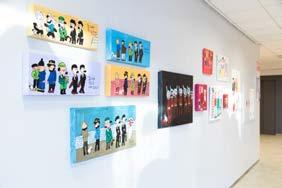
R. Benedikta – Undan Jökli
Illustrations and paintings
Runs until June 2
GALLERÍ GRÓTTA
Anna Álfheiður Brynjólfsdóttir:
LIT–ROF
Paintings
Runs until June 3
GLERHÚSI Ð
Einar Garibaldi Eiríksson:
Reykjavík / A Guide

Installation, photography
Runs until June 11
HAFNARBORG CENTER OF CULTURE AND FINE ART
Uncanny Virtuality
Digital art, mixed media
Runs until May 29
Jóhann Vilhjálmsson: Written Images
Drawings
Runs until May 29
HAFNARHÚS
DYNAMO: LHÍ Graduation Exhibition
Group exhibition of works by BA graduates of the Iceland University of the Arts
Runs until May 29
Erró: Freehand
Erró’s early freehand works meet his later collage-based works
Runs until May 31
Erró: Cunning Scissors Works spanning the entirety of Erró’s vibrant art career
Runs until December 31
HARPA
Circuleight
Mixed media installation
Runs until May 31
HJARTATORG
Ástriður J. Ólafsdóttir & Clizia
Macchi: Exhibition & Open Studio
Paintings, workshop space Runs until June 15
i 8 GRANDI
Forty Years of The Corridor Fortieth anniversary exhibition of The Corridor exhibition space Runs until June 4
Rúrí: Glassrain Installation Runs until September 17
NATIONAL MUSEUM OF ICELAND
Rúnar Gunnarsson: An eternity in a moment
Photography Runs until September 9
NORR 11
Eva Schram: WITH THE DYING OF THE LIGHT
Photography
Runs until May 22
N Ý LISTASAFNI Ð
CEREMONY: IUA Graduation
Exhibition
Group exhibition of works by MA graduates of the Iceland University of the Arts Runs until June 4

OPI Ð PROJECT SPACE
Vikram Pradhan: MELT
Photography, mixed media Runs until May 27
PORTFOLIO GALLERY
Fritz Hendrik – Drit / Droppings
Mixed media Runs until May 28
REYKJAVÍK MUSEUM OF PHOTOGRAPHY
Press Photographs of the Year 2022
Twenty Years of Kling & Bang
May 19 & 20 17:00
Kling & Bang, Marshall House
Has it been 20 years already? Has it only been 20 years!? It’s somehow hard to believe that the iconic, forward-thinking art gallery Kling & Bang is so young and that we’re celebrating its “legal age” now. Having started out on Hverfisgata – in a dearly departed edifice adorned with a giant sparkling outside wall art – and relocated to Grandi, their modus operandi hasn’t changed from showing cutting-edge work from exceptional artists. This twoday performance extravaganza will feature 10 incredible performances by some of their faves and besties, and is guaranteed to be an unforgettable party. Here’s to (at least) 20 more! RX
Art Without Borders Sale Exhibition
Runs until May 27 Gallery Fold
Art, by definition, should have no borders. But as we all know, the institutional powers-that-be have created them anyway. The wonderful festival Art Without Borders (List Án Landamæra) has been breaking down barriers since 2003, platforming art by people with disabilities of all sorts and changing the discourse around participation in the arts. This group exhibition at Gallery Fold will feature works by many of the festival’s foremost artists, all of which will be for sale. Accessibility at the gallery is decent and all are welcome. RX
Making art with other artists is both enriching and frustrating, wouldn’t you agree? Working with your parent or child is as well, wouldn’t you agree? Agreeing with your parent or child when you’re working on art together is, well… you see where we’re going with this. In the exhibition SAMMÁLA, meaning “agree”, father and son artists Elli Egilsson and Egill E ðvarðsson display works they made together by sending them back and forth between Las Vegas and Reykjavík, where each lives. Some rules applied, but otherwise it was open season and turned out something quite special. Go check it out and see if you agree. RX
B. Ingrid Olson – Cast of Mind
Installation, mixed media
Runs until December 20
ÍSLENSK GRAFÍK
Ragna & Ingimundur: 103 Vasar
Ceramics and sound installation
Runs until May 28
KJARVALSTA Ð IR
Kaleidoscope: Icelandic 20th
Century Art
Paintings, sketches, drafts, and more
Runs until August 7
MOSFELLSBÆR ART GALLERY
Geirþrúður Einarsdóttir and Berglind
Erna Tryggvadóttir – Litlar Lindir
Mixed media Runs until May 19
An annual exhibition held by the Icelandic Press Photography Association Runs until May 28
SIGURJÓN ÓLAFSSON MUSEUM
The Gift of Children
Paintings
Runs until Autumn 2023
From Various Sources
Sculpture
Runs until Autumn 2023
SUMAC RESTAURANT
Augnablikin: Leiðarvísir Augnablika
Photography and Paintings
Permanent exhibition
The Reykjavík Grapevine 6 / 23 22 Listings CONTEMPORARY ART IN THE CITY.
AND SPECIAL EVENTS. WWW. FIMMTUDAGURINNLANGI .IS PROGRAM: MONTHLY ART CRAWL. GOOD THURSDAY
ON THE LAST THURSDAY OF THE MONTH A NUMBER OF MUSEUMS AND EXHIBITION SPACES OFFER EXTENDED OPENING HOURS
Elli Egilsson & Egill E SAMMÁLA
Events
Concerts, comedy, movies and a bunch of stuff that defies categorization (and sometimes logic).
If you’re putting something on for the general public, send us a line to: events@grapevine.is
Friday May 19
Hekato B2B Rethe (PL)
21:00 Bravó
Ascension MMXXIII
20:00 Gaukurinn
RAFLOST Festival
20:00 Hafnar.Haus
Iceland Symphony's Open
Rehearsals
10:00 Harpa Eldborg
Faust Plays Beethoven
19:30 Harpa Eldborg
Jóhanna Guðrún Sings Céline Dion
20:00 Háskólabíó
TranceAtlantic 2023: Cloudchord
23:00 Iðnó
DJ Hristo
23:00 Kaffibarinn
Babies Ball
21:00 Kex Hostel
Tunglkvöld XV
20:00 Mengi
Saturday May 20
The Room – Party Screening
21:00 Bíó Paradís
Distrakt Audio Presents: Gescu (RO)
x Chad Andrew (USA)
21:00 Bravó
Emmsjé Gauti 20th Anniversary
20:00 Gamla Bíó
Ascension MMXXIII
20:00 Gaukurinn
RAFLOST Festival
16:00 Hafnar.Haus
TranceAtlantic 2023: The Disco
Biscuits with Cloudchord
19:00 Harpa Eldborg
St.Olofs Chamber Choir
13:00 Harpa Hörpuhorn
TranceAtlantic 2023: Dogs In A Pile
23:00 Iðnó
House of Lords & Jónbjörn
23:00 Kaffibarinn
Óskar Guðjónsson & Ife Tolentino
20:00 Mengi
Sweaty Saturday Session
16:00 Prikið
Valdimar & Örn Eldjárn
20:00 Salurinn
Sunday May 21
Ascension MMXXIII
20:00 Gaukurinn
TranceAtlantic 2023: The Disco
Biscuits with Dogs In A Pile
19:00 Harpa Eldborg
Choir Afternoon
14:00 Harpa Hörpuhorn
The Reykjavík Big Band
20:00 Harpa Silfurberg
TranceAtlantic 2023: Karina Rykman
23:00 Iðnó
DJ Cyppie Afrosól
22:00 Kaffibarinn
Comedy – Jim Jeffries (AUS)
21:00 Laugardalshöll
Dalin Waldo & Tildra
20:00 Mengi
Monday May 22
Open Decks w. Día
21:00 Bravó
Comedy – Todd Barry (USA)
20:00 Gaukurinn
TranceAtlantic 2023: The Disco
Biscuits with Karina Rykman
19:00 Harpa Eldborg
Korda Samfónía
19:30 Harpa Silfurberg
Hrikalegur Kjöthleifur
22:00 Kaffibarinn
Tuesday May 23
Karaoke Night
20:00 Gaukurinn
Leon S. Kemp (Nordic Voyage)
22:00 Kaffibarinn
Wednesday May 24
Stratosphere (GR)
21:00 Bravó
Hedwig & The Angry Inch
20:00 Gaukurinn
PVBR Presents: Victor Simonelli
22:00 Kaffibarinn
ASA Trio & Jóel Pálsson
20:00 Múlinn Jazzclub
Wednesday Night Grooves:
Leon S. Kemp
21:00 Prikið
Sara Flindt, tildra, Kötturinn sem
gufaði upp
18:30 R6013, Ingólfstræti 20
Kraftgalli DJ Set 20:00 Röntgen
Thursday May 25
Acidfest Iceland
19:00 12 Tónar
DJ Bensin
21:00 Bravó
Hedwig & The Angry Inch
20:00 Gaukurinn
Iceland Symphony Orchestra
Young Soloists 2023
19:30 Harpa - Eldborg
Atli James
22:00 Kaffibarinn
Quiz Night
20:00 Kex Hostel
Sandrayati
20:00 Mengi
Friday May 26
Jónbjörn
23:00 Bravó
Event Picks
Eydís Evensen
Sunday May 21 20:00
Harpa Kaldalón
5.990 ISK
Ever since the release of her debut album Bylur in 2021, Blönduós-born pianist and composer Eydís Evensen has been hailed as one of the bright new voices in contemporary classical music. Formerly a model but submerged in music since a young age, seeking out a piano wherever she could, Eydís has fast become internationally celebrated for her works. Now about to release her second album, The Light, on May 26 and embarking on her first North American tour, Eydís will delight her local fans with a send-off concert. RX
Mørose, Afterparty Angel & Ballados
20:00 Gaukurinn
Fusion Groove
23:00 Kaffibarinn
Acidfest Iceland
17:00 Kex Hostel
Saturday May 27
UNME III: Lafontaine x Elísabet
23:00 Bravó
Acidfest Iceland
18:00 Gaukurinn
Smokie (UK)
20:00 Harpa Eldborg
Young G&T
23:00 Kaffibarinn
Gamla Bíó
Karaoke Night
20:00 Gaukurinn
Ómar E
22:00 Kaffibarinn
Wednesday May 31
Símon fknhndsm
22:00 Kaffibarinn
Arta Jekabsone Quartet


20:00 Múlinn Jazzclub
Thursday June 1
HAUSAR
21:00 Bravó
Carmina Burana
20:00 Harpa - Eldborg
Leon S. Kemp (Nordic Voyage)
22:00 Kaffibarinn
Iðunn Einars & Sævar Jóhannsson
20:00 Mengi
See more at events.grapevine.is
Sara Flindt, tildra, Kötturinn sem gufaði upp
Wednesday May 24 18:00
R6013
Free, donations welcome We’ve got a hump day treat for you, with a fun mid-week show of electronic experimental kids bopping through downtown’s premiere independent basement venue, R6013. Newcomers Kötturinn sem gufaði upp will bring some fresh funky electropop. Tildra serves up a layer cake of weird grooves, wonky melodies and eclectic acoustics. Sara Flindt will perform the sparkling and glitchy pop bangers from her new EP It’s Always Nice To Be Wanted. It’s always nice to see a midweek show, so go make them feel wanted. RX
Hedwig & the Angry Inch
May 24–25 & June 1–2 20:00
Gaukurinn
4.990 ISK
Legendary queer rock musical Hedwig & the Angry Inch has been a cult sensation since it first hit off-Broadway in 1998 and the performance of Stephen Trask and John Cameron Mitchell’s iconic show remains an act of rebellion and liberation. Starring Hafsteinn Níelsson as Hedwig, Halldóra Björg Guðmundsdóttir as Yitzhak and the Angry Inch performed by the psychedelic rock band Nornagal, it will be the first musical ever shown at Gaukurinn. For all the children of the earth, moon and sun. RX

23 Listings Reykjavík Art Museum One museum Three locations Open daily listasafnreykjavikur.is artmuseum.is Hafnarhús Tryggvagata 17 101 Reykjavík Kjarvalsstaðir Flókagata 24 105 Reykjavík Ásmundarsafn Sigtún 105 Reykjavík Safnahúsi ð The House of Collections Viðnám: Samspil myndlistar og vísinda Resistance: Interplay of Art and Science Free admission for children & teens 3.2.2023— 26.3.2028
Nordur Music 20:00 Kex Hostel Acidfest Iceland 12:00 Lucky Records Ólöf Arnalds 20:00 Mengi Sunday May 28 Sunday Club 21:00 Bravó Elvis Costello 20:00 Harpa Eldborg Choir Afternoon 14:00 Harpa Hörpuhorn Bensol 22:00 Kaffibarinn Acidfest Iceland 19:00 Lemmy Monday May 29 Minimal Monday w. Tadas Ersha 21:00 Bravó Silja Glömmi 22:00 Kaffibarinn
May 30 Comedy – Failing In Love 20:00
Tuesday
19.05–01.06
Music News
Alþingi Passes New Music Policy Bill
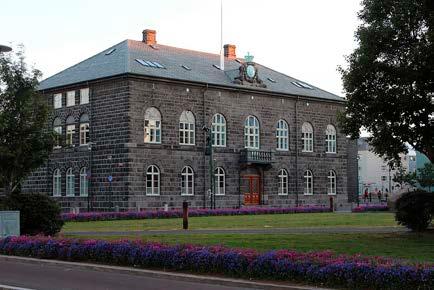
On May 8, Alþingi passed comprehensive new legislation on music policy. Minister of Culture Lilja Dögg Alfreðsdóttir’s bill is a landmark piece of legislation for the music industry as it draws up formal support for a more favourable music landscape. Among other things, the bill introduces the establishment of
a Music Centre, incorporating the many disparate institutions operating in the industry. The new Music Centre is set to open later in 2023, with no official date given. In any case, the bill provides formal grounds for a variety of new options for Icelandic musicians.
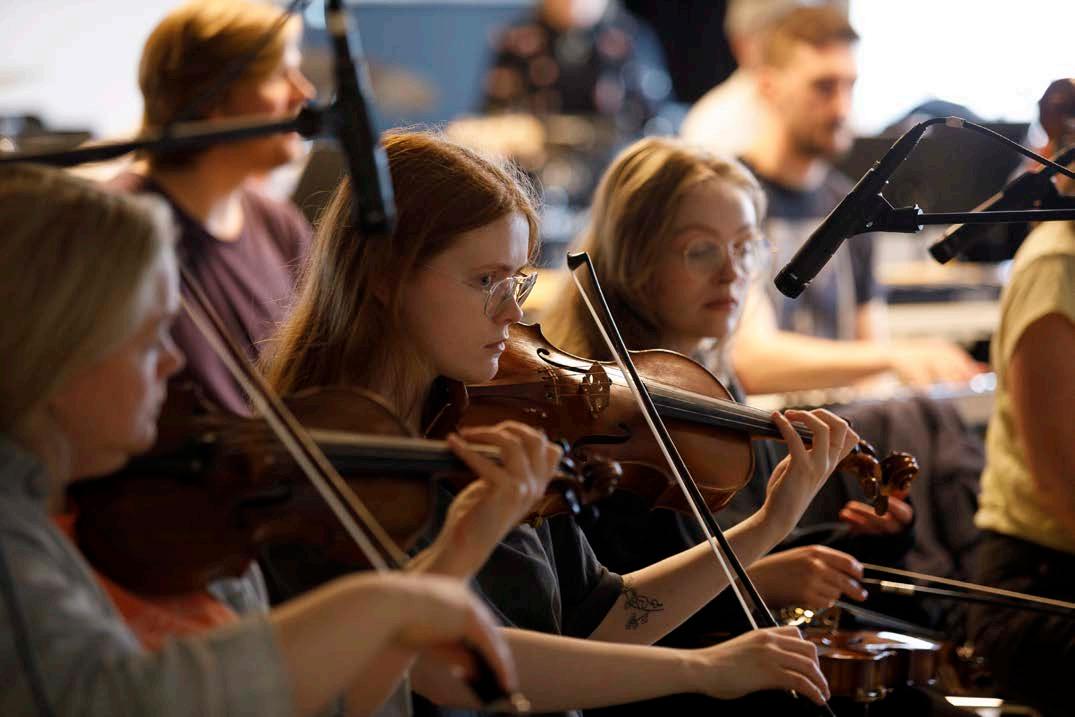
The Most Unusual Band In Iceland
Finding the music and healing with Korda Samfónía
Botnleðja Supports Pavement
The American indie-slacker, altrock band Pavement is set to play in Iceland on July 27, and 29. The band will take on Harpa on their first visit to Iceland. One of three warm-up acts has been announced – post-hardcore band Botnleðja. Starting out with their victory of Músíktilraunir in 1995, Botnleðja
released six albums during their lifetime. In 2011, they reunited, to the joy of many 90’s grunge fans. With the release of Blur’s “Song 2”, speculations arose about whether Damon Albarn stole the hook from Botnleðja’s “Þið eruð frábær.” No verdict is in, but it never looked good for Damon.
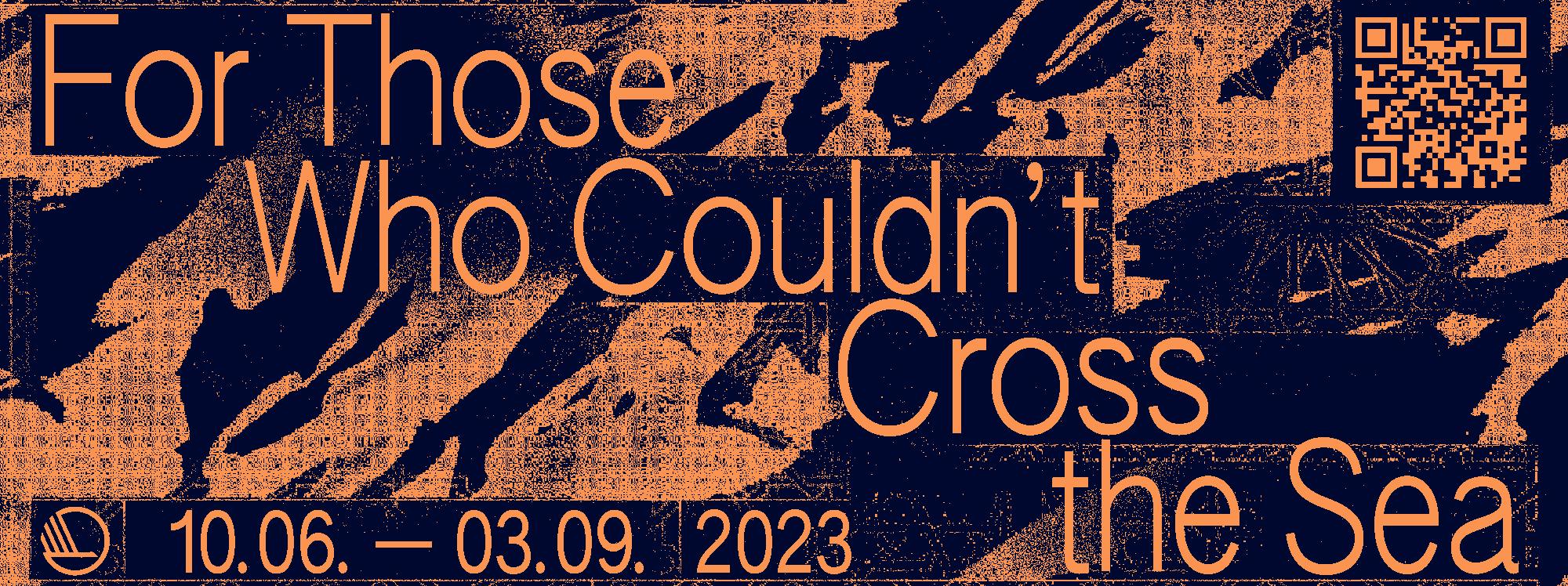
Superserious Secures Spot
The Danish Spot showcase festival was held in Århus, Denmark, on May 5–6. The festival’s overall goal is to highlight the up-and-coming music talent from Denmark and the Nordic countries. In Iceland, Reykjavík Music City in collaboration with Iceland Airwaves issued
a call for applications to the festival, and the band Superserious was ultimately chosen from applicants to make Iceland proud in the land of our former overlords. Pop queen Bríet was also booked to perform at the festival, having been selected by the organising committee.
WORDS
IMAGES
Jóhannes Bjarkason
Art Bicnick
numbering around 35 – the band consists of music students from the Iceland University of Arts and people from occupational rehabilitation centres.
The idea for the eclectic supergroup originates from musician and community organiser Sigrún Sævarsdóttir Griffiths, who studied at the Guildhall School of Music and Drama in England. Sigrún established the community-interest company MetamorPhonics to operate music rehabilitation projects, of which currently there are eight – one in Los Angeles, two in the United Kingdom and five here in Iceland.
MetamorPhonics established its first band, the London-based The Messengers, under its umbrella in 2012. A collaboration project with homeless charities in the U.K., the band comprises Guildhall students and unhoused individuals.
groups include people currently in occupational rehabilitation. With each band only meeting a handful of times a year to write and rehearse their material, each session is short and efficient. For Korda, they meet 10 times a year in three separate rounds.
ONE BAD DAY AWAY FROM CATASTROPHE
Sævar Helgi Jóhannsson and Jón
G. Breiðfjörð are members of Korda Samfónía, having been introduced to the concept through their studies at the Iceland University of Arts. Jón now serves as a volunteer and Sævar is a member of Korda’s leadership team.
Korda Samfónía is Iceland’s most unusual band. With a flexible line-up of members – currently


Korda Samfónía was formed almost 10 years later. The fourth Icelandic band to be established within MetamorPhonics, Korda Samfónía includes representatives from each of the three other community bands; 360° in Suðurnes; Barlómur in Akranes; and Hamarinn in Hafnarfjörður. The most distinct feature: all the
“I got into the program when I studied Music Communication at the university,” says Jón. “We collaborated with refugees and immigrants, went to primary schools and worked with children. It was this idea of being able to help people through music that attracted me to the concept.”
“When you meet these people and hear their stories, I feel like it could be anyone,” Sævar adds. “We’re all just one bad day away from being in a similar position. It has taught me immense compassion for other
The Reykjavík Grapevine 6 / 23 24 Music
Feature
people. You never know what’s going on in people’s lives.”
The overall aim of the project is to help people step back into society after suffering debilitating trauma or illness. Korda Samfónía and MetamorPhonics do so by increasing accessibility to music, inviting people to participate, and providing them with musical instruments and a safe space to write music. Members are encouraged to throw ideas around. Some catch on quickly, but for those who are more hesitant, the atmosphere is characterised by a “no idea is bad” philosophy.
CREATIVE CHAOS
Music therapy is a widely accepted form of rehabilitation throughout the world. It has been shown to have pain-relieving properties, boosting physiological wellness. As Sævar and Jón recall, they’ve noticed a major shift in members’ outlooks since starting work on the project.
“Music is a sociological phenomenon,” says Sævar, “It’s encouraging to play music together and playing in Harpa gives you a feeling of accomplishment. I notice [participants] feeling rejuvenated after taking part. Learning to support each other and listen is also a nice exercise. The most important thing about music is knowing how to listen.”
As Jón and Sævar explain, some members come to the band without any musical experience. For members of Korda, even the act of playing something as minimal as a shaker can be ground-breaking in their journey towards recovery.
“That’s also an interesting aspect of this programme,” Sævar notes. “People who’ve never studied music compose differently than those of us who have spent years thriving in a musical environment.”
On the topic of composing – in a group of people with contrasting backgrounds and varying levels of knowledge, composing music
sounds like it would be a chaotic act. How does Korda work around the experience gap? “We use various methods,” Sævar says. “For example, by using something as universal as a dot and a line to
environment of all ideas being valid,” Sævar continues. “We should just try them out. Nothing needs to be perfect.”
Even though the band’s inner workings seem complex, Sævar and the leadership team are firm believers in the process. “It’s like that phrase, ‘leap and the net will appear.’”
SUSTAINABLE LEADERSHIP
indicate rhythm. Even though it’s abstract, everyone can infer their meaning from it.”

“From an outsider’s perspective, it can look like massive chaos. But within this chaos, several exciting things are happening. Some may be chatting; others may be practising a piece or doing something completely different. It’s all meaningful,” Sævar clarifies.
In this massive group of contrasting characters, approximately half the members are music students. With that being the case, it can be tempting to assume certain power dynamics take shape. Sævar begs to differ:
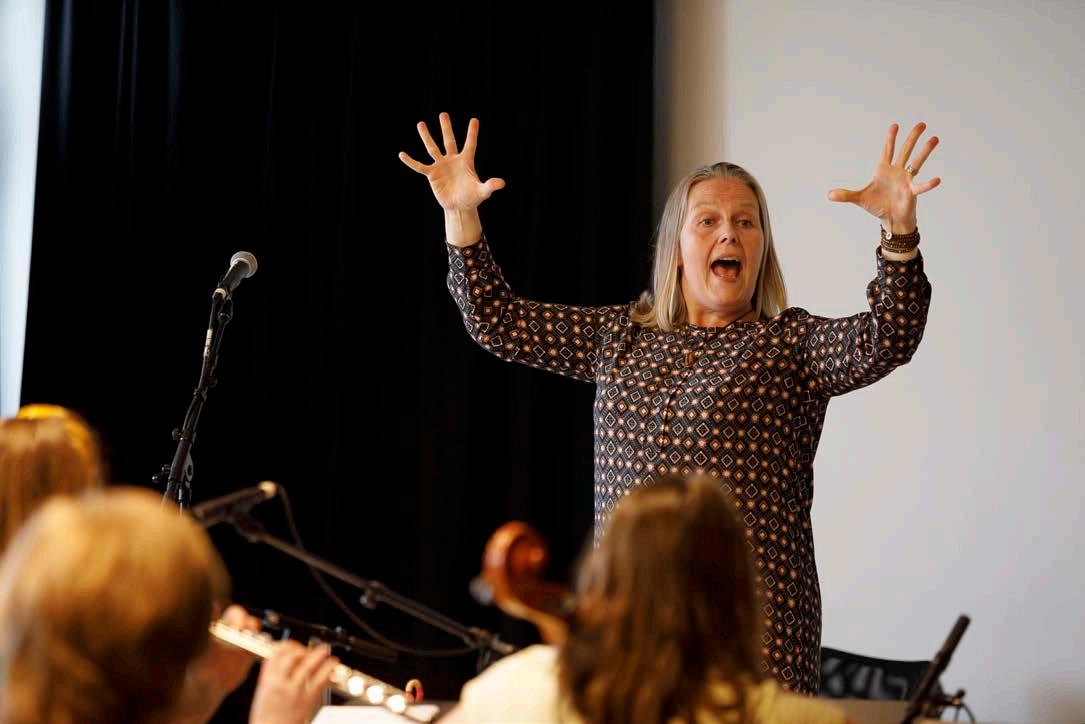
Korda Samfónía is now in its third year of operation. Sævar and Jón recount how it has developed since its inception. “Everyone has become so active in listening when an idea is presented and shows support. I think that’s beautiful,” says Sævar. Since patients get better and students graduate, the band's line-up changes occasionally. However, those who want Korda Samfónía in their lives can volunteer or come on as an apprentice.
“This is part of Sigrún’s vision for her to ultimately be unnecessary. To train people to put in the work
“Everyone is involved and welcomed, and we try our best to not say ‘no’ to any idea. Instead, we try to lead the ideas into a different avenue. Let’s try it! And if it doesn’t work, it doesn’t work. Although sometimes I think to myself, ‘What have I gotten myself into?’” he jokes.
For people outside of liberal arts circles, the notion of openness and inclusivity of ideas may appear to be alien. In Sævar and Jón’s experience, they’ve met many people with a deep-seated notion of personal faults that prevent them from making music. People have been raised with the belief of being tonedeaf or thinking they can’t keep a steady beat. Korda wants to dispel those myths by getting people to try something new, promoting the opinion that everyone can play music. “You learn how to hold a beat the first time you start walking,” Jón says confidently. “We provide this

and create with the group,” Sævar explains. “It’s also a good thing when people quit the band. Because that means they’ve moved on to something else. Maybe they’ve opened a business or started a new job. Suddenly, they don’t have time for the band anymore,” Sævar continues.
Based on the inclusiveness at play and the amount of compassion the people behind Korda Samfónía have for the project and participants, it’s easy to have hope that this model of sustainability will work out for the group. In the meantime, the organisers will just have to keep trusting the process.
Korda Samfónía invites you to their annual concert in Harpa Silfurberg on May 22 at 19:30. You can get your tickets at tix.is and come see Iceland’s most unusual band for yourself.
25 Music
It’s also a good thing when people quit the band.
You learn how to hold a beat the first time you start walking.
Manufacturing Content
The morally bankrupt economy of modern Icelandic hype
WORDS Davíð Roach Gunnarsson
IMAGE Supplied by Alda Music
Prettyboitjokkó, or Patrik
Atlason, is Iceland’s newest pop star manufactured by joint patriarchal forces in a corporate handshake with a mainstream media hungry for freaks and clicks. His first single, conveniently also titled “prettyboitjokko”, was released March 3 and it’s the kind of basic bitch autotune-pop with a hiccuping house-beat and a catchy chorus that you can’t get out of your head – even though you hate it.
In interviews, he stresses the utmost importance for boys to look fine, to be “drippin’,” and that anybody can be a “prettyboitjokkó.” But to be that you have to smell good and to smell good you have to wear a cologne that costs a lot of money (Tommy Hilfiger is not expensive enough). Patrik has a lot of money that flows on his social media pages. He wears expensive high fashion brands and drives a blue Porsche, but wishes he could have gotten a pink one (poor little PBT!).
All of his riches seem to derive from the fact that he is an heir to a KFC/ Candy empire – a fact that he flaunts like it’s something he’s earned. With only one single out he had about six tidbits and mini-interviews on Vísir, all addressing him like he’s already a bona fide pop star.
His manager is Birgitta Líf, also an heiress (in her case to the World
Class gym empire), and her father and Patrik’s grandfather both showed up signing a supposed management contract in a ridiculously staged video posted to PBT’s Instagram – that of course instantaneously became news on Vísir. Soon we were bombarded with advertisements for prettyboitjokkó chocolate bars, a World Class sponsored video, an appearance in Vikan and a warm-up gig for the Valur-Tindastóll basketball playoffs game. His five song album PBT hit streaming services on May 5, and it’s more of the grinding autotuned idiocy of single (that also appears here).
It’s as if somebody set out with the goal of making music even dumber than ClubDub – and succeeding. It’s enough to look at titles like “Hot in the Club,” “All the Girls,” and “Gugguvaktin” to tell as much. Prettyboitjokkó is the product (literally) of a society where the barriers between art, content, marketing and commerce have evaporated to the point of being indistinguishable. He’s the inevitable result of the bottomless surface worshipping in modern day Instagram influencer culture, taken to its logical extreme.
One thing I find a bit charming is his revival of the slang tjokkó from around the turn of the century (pronounced “chocko,” invoking chocolate to reference a tan).
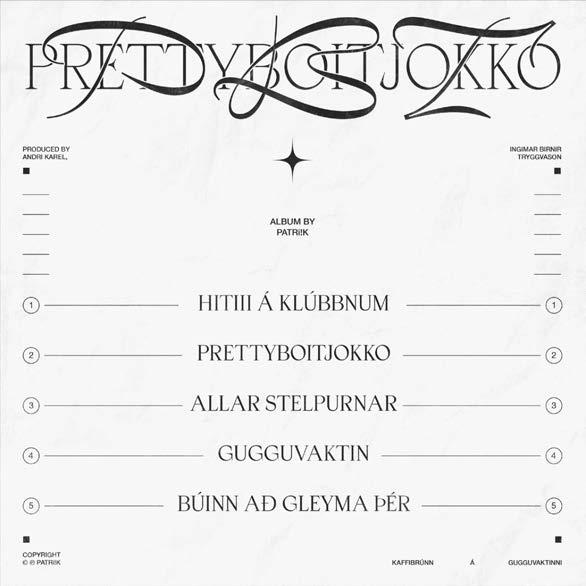
around him. “For these things to work, you must consider the work you just released to be your greatest,” he says. “Even though I’ve been in the business for this long, I’m just as excited to show my dad new demos and get feedback
artists. He perks up at the mention of his acting career. “The season of Trapped that no one watched,” he quips.
Despite his long list of accomplishments, Gauti says he feels like he’s
But that also reminded me of the millennium figure which is his closest ancestor, Gillzenegger, whose EXIT-themed birthday party PBT just happened to perform in last weekend. We now seem to have a whole generation on our hands that has never heard of the term “sell out”, and for which the concept behind it doesn’t even register as a bad thing. Where everything is for sale all the time. It’s all just vibes and “stemming.”
Every person I pass on my way to meet Emmsjé Gauti seems to be loading a car for a trip to the countryside or to lug unwanted junk to the recycling centre. The same goes for the rapper, who is preparing the celebration of his 20th rap-iversary party at Gamla Bíó on May 20. When I arrived, Gauti and his wife were prepping for a big trip to Sorpa – a staple of Icelandic-ness on those days when the sun makes an appearance during our sad excuse for a spring. We venture inside for a cup of coffee and the hope of a thorough conversation about his 20-year career.
Instead of regurgitating his biography back at him, I invited Gauti Þeyr Másson to take stock of his career.
Having pondered the request, he tells me that he considers himself to be the frontman of the band Emmsjé Gauti, because he couldn’t function without the great people
on whether it’s good or not – or I know that it’s great and I want the acknowledgement.”
STAYING HUMBLE
The most important thing Gauti has learned regarding the business side of music is that he is merely a cog in the wheel. “I would be nothing without the people taking care of the tech side of things, or the people that perform with me. I’m not trying to reduce the significance of me standing in front of people. I believe in being humble towards what you do and how it can’t be taken for granted. Sometimes I forget that and I have to remind myself because from time to time it can feel like a normal job.”
Gauti also mentions that making music isn’t that different from other jobs. Artists have to grind and struggle to get to where they want to be, just like dentists, builders or athletes. When asked if he would still be making music if he hadn’t already reached this level of success, Gauti takes pause. “It would definitely be harder to give yourself the time to create,” he finally says. “There have
just getting started. “ I find it so boring to do nothing. We don’t have infinite time here so why not make the most of it?”
On top of everything else, Gauti has also started working with Geðlestin, a collaboration project between the mental health advocacy group Geðhjálp and the Red Cross that aims to educate teens on the importance of mental health. Asked whether he has been diligent in looking after his own mental health throughout his career his answer came fast. “The answer is a definite no! I learned it the hard way. The sad part is I know when I was that age, I would never have listened to that kind of information. Regardless, the point is not to make everybody an expert in mental health but to plant the seeds so if the time comes, they know where to ask for help.”
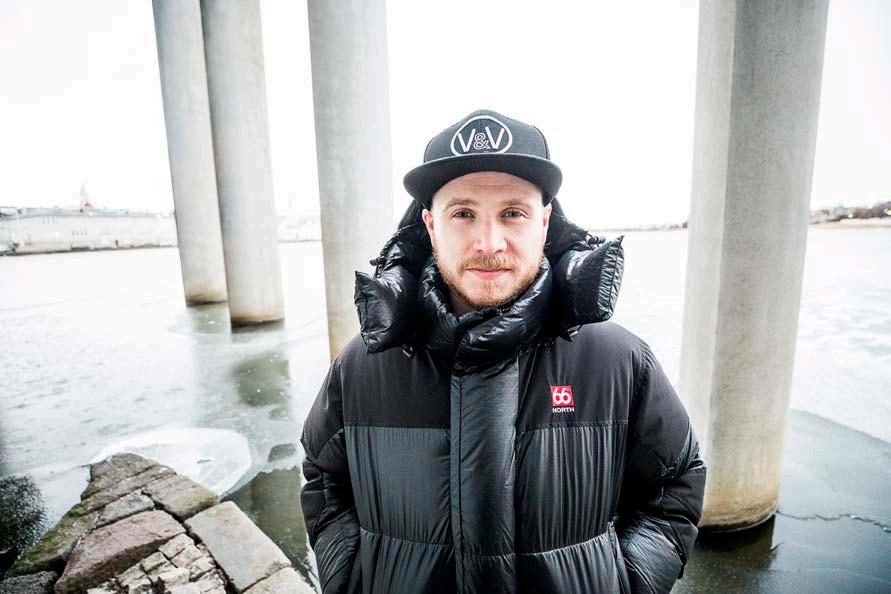
BACK TO THE PARTY
Regarding his anniversary concert, Gauti aims to thoroughly enjoy himself, which hopefully spreads into the crowd and translates into a fantastic party. “I’m going all out! As things
been many artists who came up with me that have fizzled out because the main focus wasn’t music. Whether they would have made it or not can’t really be answered.”
NOT YOUR AVERAGE RAPPER
Over the past 20 years, Emmsjé
Gauti has started a family, released seven albums, dabbled in acting, had a few successful business ventures and established himself as one of the country’s most popular
are right now, we have a setlist of 32 songs that we are trying to chisel out. I have never done a show like this before. I’ve done Jülevenner [Gauti’s annual Christmas concert] but I’ve never had one where it has this element of nostalgia and getting past collaborators to pop by. It will be a great time!”
Emmsjé Gauti celebrates the 20th anniversary of his career on May 20, in Gamla Bíó. You should go. Get your ticket at Tix.is – if there are any left.
The Reykjavík Grapevine 6 / 23 26 Music
20
20 Gathering wisdom from rap veteran Emmsjé Gauti
Interview Hindsight Is
/
Prettyboitjokkó is the product (literally) of a society where the barriers between art, content, marketing and commerce have evaporated so it’s impossible to tell them apart.
Review
WORDS Sævar Andri Sigurðarson IMAGE Art Bicnick
Even though I’ve been in the business for this long, I’m just as excited to show my dad new demos.
The sad part is I know that when I was that age, I would never have listened to that kind of information.
WORDS Sara Flindt
IMAGE Janosch Bela Kratz
Danish-born, Icelandbased artist Sara Flindt takes us through her most recent EP. Having previously worked under the moniker ZAAR, Sara joined fellow musicians Salóme Katrín and Rakel Sigurðardóttir to produce the 2022 split album While We Wait. The album received a 2023 Iceland Music Awards nomination.
Sara released her debut album under her given name, It’s Always Nice To Be Wanted, on May 5.

way of interacting with reality, rather than representing reality.” In this way, they’re not so different from memories. Remembered conversations melt into the cello and the flute, fragile and intimate. The voices of this track grew and divided like little microbes as I clipped and nudged them into place – the smallest changes in timing changed meaning. In the demo, the rain was recorded from my bedroom in Vesturbær. But over time, the memory outgrew that recording. I had to find a new one.
BLUE MOUNTAIN
Coming back from the Westfjords, stopping for burgers in Hólmavík, my friends taught me an Icelandic proverb: “Fjarlægðin gerir fjöllin blá.” Proverbs are the sound of thoughts echoing through time. Here I’m singing to the mountains across a valley; the echo is a shepherd’s song, a call back to safety.
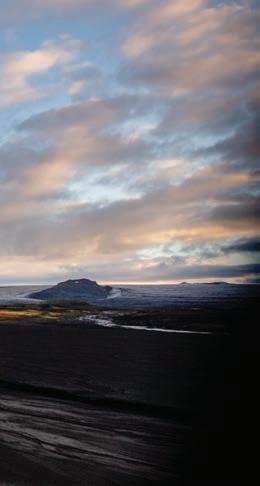
IN BETWEEN THE CRACKS
Early in the project, I began recording people to discover how they understood home. Eventually the talks felt less like one-on-one interactions and more like a larger conversation happening around me, the voices speaking directly to each other. But they spoke in the logic of dreams.
ORGANIZE ( IANTBW VERSION )
This track feels like the kind of practical advice you might get from a mother. But organising isn’t about order, it’s about creating and forgetting. This track exists in many versions: I began shaping this version in 2019 with my dear friends and co-producers Jonathan Jull Ludvigsen and Bjarke Amdrup. Another version lives on last year’s split album While We Wait with RAKEL and Salóme Katrín.
IT’S ALWAYS NICE TO BE WANTED
For the third edition of the Filthy Interview series, we are joined by two members of occult-inspired metal band Svartþoka: Ólöf, who supplies the band with vocals, theremin and synths; and Dia, who serves as the Svartþoka’s screaming guitarist and has fun using objects – like knives – to hit the strings.
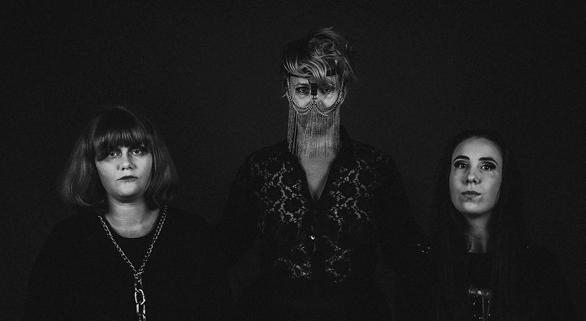
FS How did Svartþoka come to be?
ration from occultism and esoteric practices and incorporate rituals and folk beliefs into our performances.
Ó We draw heavily from Icelandic folk tales, particularly those that deal with darkness and the unknown. We seek to embody these themes through our performances and create a mood that transports the audience.

FS You conduct rituals during your performances; can you tell us more about that?

D The rituals on stage are about particular events and our inner voice. We feel that going on stage and expressing ourselves in front of people is a ritual in itself. We let out the ghosts from the past and embody their memory.
FS How does DIY and art factor into your process?
Ó We’re both visual artists and we incorporate that into our performances and merchandise. We’ve been hand-painting our merch and Dia designed the band’s logo.
Across two countries, four years, six living arrangements and nine hairstyles, I’ve been trying to figure out what it means to belong somewhere. Each track of It’s Always Nice To Be Wanted is made in a place that I called home at some point, recorded with only the objects and instruments from that space.
DON’T LOOK BACK, CARRY ON
Sound artist Francisco López talks about field recordings as “a creative
IS IT TOO LATE TO COME HOME
I was complaining one day to my friend Áslaug Magnúsdóttir, who also produced this track, about how I couldn’t fully express my heart through my vocals. She advised me to just record directly into the computer mic. I did. I was pretty vulnerable, on a couch in Nuuk, feeling far away from home. My dear friends Salóme Katrín, RAKEL and Sandrayati sing back to me through the computer.
This song came to me when I was at a residency in 2019 alone. The chorus is recorded on an electric organ in the living room of one of the six places I called home during the development of the EP. I couldn’t afford a string orchestra, so I used my pedalboard and my voice to create vocal-strings – the sort of transformation that happens at dawn, suspended between dreams and actions.
Ó The band was born out of a drunken conversation in 2020 in the Hard Rock Café basement here in Reykjavík, where we decided that it was time to start this journey through darkness. It took us a year to get our act together, but once we did, things took off quickly. We are very DIY and do everything ourselves, from recording and mixing our music to making our own merchandise.
D Svartþoka has basically become an entity in and of itself, a triple-headed beast that works through us.
FS What is the inspiration behind your music?
D Svartþoka – the densest, blackest fog – represents the concept of complete darkness and almost sticky obscurity. We draw inspi-

D Art is an important part of the process for us. We’re planning to make costumes for the shows. I am also a tattoo artist, so perhaps a matching tattoo soon?
FS You’re playing the Ascension festival soon; who are you looking forward to seeing?
Ó I’m really excited to see Hekla, Kælan Mikla, Múr and Misþyrming. Our performance at Ascension festival will be very special as well. We will perform a new song that we’ve never played before. It will be a lot more dramatic than the previous ones.
Catch Svartþoka’s performance at the Ascension festival taking place at Gaukurinn on May 21, and a Summer Solstice show at Gaukurinn on June 21. Post-performance crawling fog assured!
27 Music Filthy Interview Knife Play And DIY Meet the Esoteric Queens from Svartþoka Track By Track It’s Always Nice To Be Wanted Sara Flindt searches for home EXPLORE UNSEEN ICELAND ON THE ULTIMATE FLYING RIDE OPEN EVERY DAY | flyovericeland.com MUSEUM OF DESIGN AND APPLIED ART GARÐATORG 1 210 GARÐABÆR OPEN TUE–SUN 12–17 WWW.HONNUNARSAFN.IS Instagram Facebook honnunarsafn PERMANENT EXHIBITION HÖNNUNARSAFNIÐ SEM HEIMILI AT HOME IN THE DESIGN MUSEUM THE PLATFORM HABITATIONS 4TH GRADERS TAKE ON INTERIOR DESIGN 18.04.–03.09. RESIDENCY ADA STAŃCZAK CERAMIC DESIGNER 20.02.–30.05. EXHIBITION PRESENCE NEW SWEATERS BY ÝRÚRARÍ 28.04.–27.08.
WORDS Francesca Stoppani IMAGE Einar Jarl Björgvinsson
We Tried It
Paddling Around The Arrowhead
Experiencing Iceland’s most picturesque mountain from a new angle
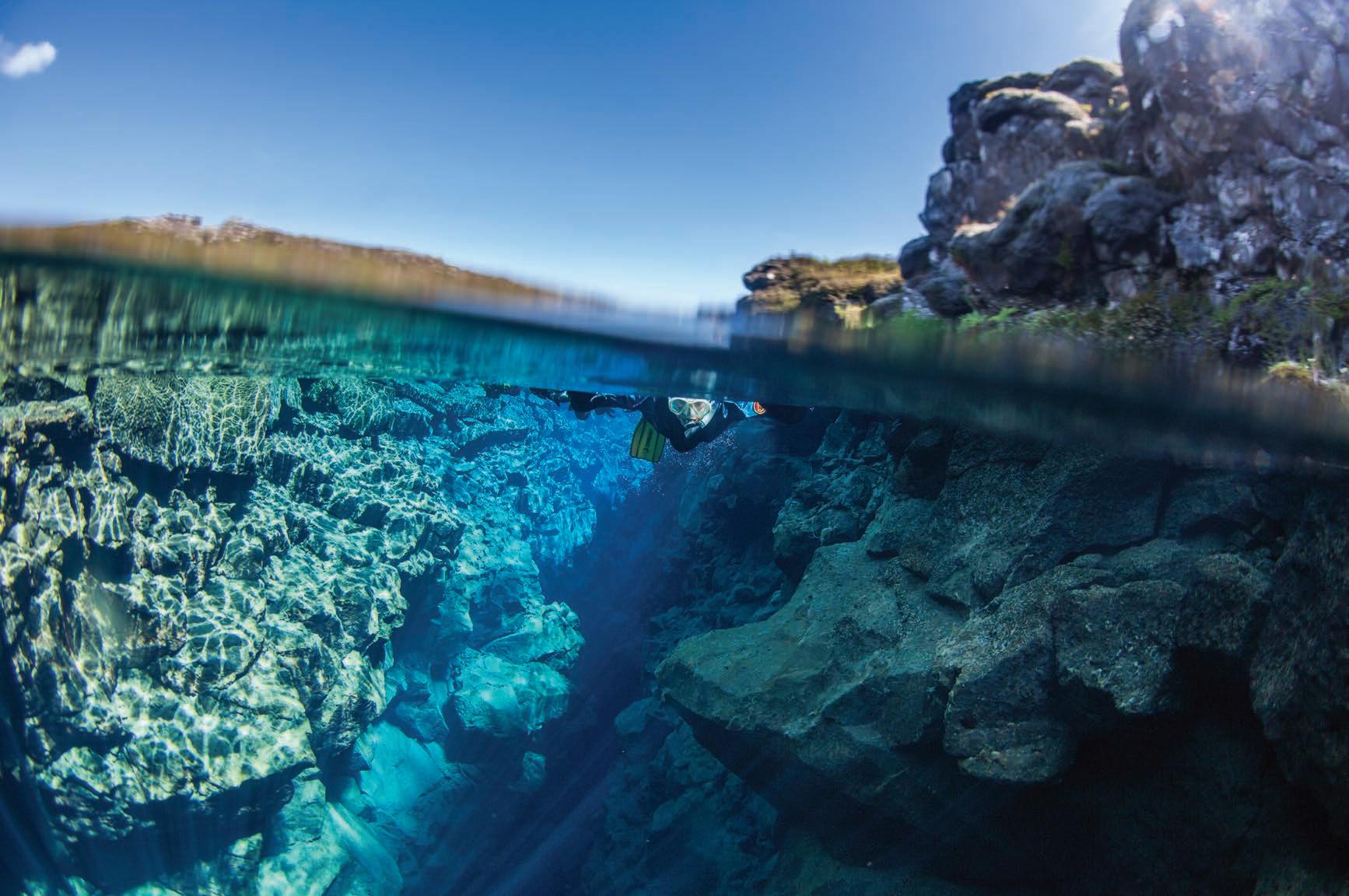
WORDS Lea Dörschel
IMAGES Art Bicnick
Tour provided by VesturAdventures.is
overboard. I recommend wearing some woollen clothing – ideally thin merino wool clothing – underneath for added warmth and comfort. It can get chilly while kayaking on the ocean. Thankfully the weather was cooperative when we hit the water in early May. The sun was out and it was actually quite warm – at least by Icelandic standards.
THE MYSTERIOUS PUFFIN ISLAND
After a short demonstration of how to paddle, we walked down to the beach where our kayaks were already waiting for us. I jumped in my kayak, got pushed into the ocean and started to get a feel for how to paddle myself forward and turn the boat. While kayaking, Garðar informed me about the special landmarks around the area. Obviously, he started by telling me everything he knows about Kirkjufell mountain. Then he went on about a puffin island not far from the coast
legs a bit – kayaking is an effective upper body workout!
While taking a short break on land, Garðar showed me the old pens for sorting sheep during the “réttir” back in the days.
Soon yearning for the open water, we jumped back into our kayaks and off we went!
A FRESH ICELANDIC SNACK
Blue skies, the sun sparkling on the surface of the water, feeling the warmth of the sun on my skin – what a wonderful day for kayaking! On the way back to the basecamp Garðar stopped by some seaweed, ripped it out of the water and gave it to me.
Where are my Game of Thrones fans at? Do you remember the Arrowhead – one of the most iconic landmarks beyond the wall? Outside the confines of your television screen, that mountain is known as Kirkjufell and it is located a two and a half hour drive from Reykjavík on the northern shore of the Snæfellsnes peninsula.
Kirkjufell may just be the most famous mountain in all of Iceland – at least it’s the most photographed. Today I’m experiencing this gorgeous mountain from a completely new perspective: sea level. Let’s go kayaking!
GRAB YOUR PADDLE
While most people prefer to go to Kirkjufellsfoss to take photos of Kirkjufell rising like a magnificent fin in the background of the falls, I won’t stop there today. The starting point for my kayaking tour is the small town of Grundarfjörður, so that’s where I head to meet with Garðar, the founder of Vestur Adventures.

He will be my guide for today’s tour and efficiently goes about equipping me with a dry suit, gloves, shoes and a life jacket to keep me dry and afloat should I find myself
of Grundarfjörður and the dramatic story surrounding it – I won’t spoil it for you, though, you’re going to have to hear it from Garðar. It was an education being out on the water with someone who is so knowledgeable not only about his home town, but the entirety of the Snæfellsnes peninsula. I stored away valuable tips about the must-sees in my memory for my next trip west.
TIME TO STRETCH
Our first stop was an old harbour that consisted of nothing more than an old landing stage. Continuing our kayaking tour, we stumbled upon a lost puffin who bobbed in the water and watched us pass by. He was quite curious until we came a bit too close, so he decided to dive to safety. We’d been kayaking for half an hour at this point and decided to make landfall. It felt so good to just stand up and stretch my arms and
I looked at him with a sceptical expression. What does he want me to do with it? He smiled and told me to eat it. It’s our little snack: Truffle seaweed fresh from the ocean. It’s called “truffle seaweed,” he said, because the aftertaste is pretty similar to the taste of a truffle. Let me just tell you, my mouth tasted like seaweed for the rest of the day.
While I was still chewing on my seaweed, we encountered a seal. Quite curious, it first watched us from a distance, then decided to dive and swim around us.
When it was time to paddle ashore and return to Vestur Adventures’ base, I changed out of my dry suit while Garðar prepared some hot beverages for us.
We sat down outside in the sun, enjoying our hot chocolate and coffee, talking about what we have just experienced: Learning more about Icelandic nature and history, eating seaweed and encountering wildlife – this was truly an adventure.
The Reykjavík Grapevine 6 / 23 28 Travel
We’d been kayaking for half an hour at this point and decided to make landfall. It felt so good to just stand up and stretch my arms and legs a bit – kayaking is an effective upper body workout!

Birdwatching With A Pro
Learning to “catch and release,” the birder’s way*

WORDS Iryna Zubenko
IMAGES Art Bicnick & Sigurjón Einarsson

pandemic hobbies and, as you can imagine, there was a lot of sourdough and banana bread baked over those months. One friend, however, proclaimed her newfound passion for birdwatching. She mentioned
immediately notice a pair of binoculars on his windshield. We follow his car for half an hour to the Flói Nature Reserve. A couple of times, the lead car would stop and we’d spy a giant lens poke out the window, eliciting a
Ivividly remember the moment I met with friends after lockdown. Everyone was sharing their
an app where you can track the birds you see. It sounded like a perfect hobby – learning something new, experiencing a sense of achievement when spotting a new bird and spending time in nature (although, as I’d soon discover, that’s not entirely necessary).
Fuelled by curiosity to learn more about birds and how to spot them without travelling too far outside the city, I sought out avid birdwatcher and bird photographer Sigurjón Einarsson.

GETTING STARTED
After bouncing each other a few emails, Sigurjón and I agree to meet at a gas station outside Reykjavík. It’s not hard to spot Sigurjón – you
slight jealousy from the Grapevine’s lesser-equipped staff photographer – bird paparazzo Sigurjón snaps a few shots before I can blink. As we arrive at our destination he jokes: “I have to travel a lot all over Iceland for work and this one is always with me,” he points at his camera. “Sometimes my wife comes with me, so she has to sit in the back – this one has the front seat.”
“Do you need such a big camera to go birdwatching?” I ask, wondering if I could even lift that thing. Sigurjón reassures me that you don’t really need a camera or, in fact, leave the city.
His passion goes back to childhood, when he was spending time with his
The Reykjavík Grapevine 6 / 23 30 Travel
In the beginning, I went out and just photographed birds. Today, I usually go out because I have a photo in my mind.
grandparents on a small island in Breiðafjörður. “I always liked birds and I was always interested in photography, even though I didn’t practise it before the digital technology came along,” he shares. “It somehow clicked together and I started doing more of both. Some people say I’m crazy,” he cracks up with laughter. “I think it’s one of the best types of craziness you can have.”
Sigurjón has a day job with the Soil Conservation Service that allows him to take time off whenever he needs to chase birds. He recalls a time when a bird he was long pining for was spotted in a village not far from where we are now.
Sigurjón didn’t think long, jumped in his car and drove all the way from Hvanneyri, more than an hour and a half away. “I went there, saw the bird and drove back home again. In two hours, I was down here and back home and kept on working.”
HOW TO SMALL TALK WITH A BIRDWATCHER ?

As we walk through a small forest, created and taken care of by the Forestry Association of Eyrarbakki, Sigurjón keeps asking me if I know this or that bird. Admittedly not knowing any, I try to ease awkwardness with a small talk.
“Do we have mandarin ducks in Iceland?” I ask, explaining they are my favourite bird. Expecting a response in the negative, I’m soon surprised. “Right now we do,” Sigurjón says. “You don’t see them
it’s not the birds moving nearer to us, but Sigurjón trying to lure them.
“Sometimes I play their songs, I try to get them closer to me,” he says, showing me an app that plays select bird sounds. Nothing is flocking
all the time. They don’t breed here. There are two of them in Vík – two males, very colourful and beautiful.” In my mind, I’m already planning a visit to these beauties. “I remember in 2017 there were two of them in Húsavík, so I drove from Akranes all the way to Húsavík to see them,” Sigurjón continues. His dedication doesn’t cease to amaze me.
“It’s probably like going hunting for hunters,” he says. “But the reward for the hunter is to shoot the bird.
I have nothing against hunters, but this makes me more happy – just to go see the bird and take photos of it. We can say ‘catch and release’ when we’re photographing – I can shoot the same bird again and again.”
We continue on our way and the vibrant sounds of birdsong amplifies.
I am surprised again, as I realise
to our sound today. “It’s probably because of the weather, it was very cold yesterday and the day before,” Sigurjón explains.
SNEAKY HIDEOUT
As we stop at the wetlands, it becomes more and more clear Sigurjón is no amateur. “This is my floating hide,” he says, producing a piece of equipment I’ve never seen before from his trunk – it’s a portable camouflage tent that allows you to blend in with the surroundings and approach the birds without disturbing them. Naturally, I want to see it at work and Sigurjón obliges – with a woolen base layer hand knitted by his wife and waterproof overalls, he’s fully prepared, unlike me. “Do you have other shoes?”
Sigurjón asks and, as I shake my head, he says he can just carry me closer to the shore. “Should we do it the viking wife way?”
On the water, the floating hide looks even more bizarre – one needs to submerge themself entirely, simultaneously trying not to disturb the water or cause any noise. There’s a bird nesting nearby, so Sigurjón only stays in the water for a few shots. On many occasions he has spent about six hours in his hide position. “In the beginning, I went out and just photographed birds. If I could get any photo, I was happy. Today, I usually go out because I have a photo in my mind. I spend more time waiting for that moment.”
PLAYBOOK
BIRDER’S
How can an urban dweller, like myself, get started in birdwatching?
“Buy decent binoculars and go to some easy place, like the local pond or local forest. That’s a good beginning,” says Sigurjón.
After some time, you’ll learn how birds act around you and may be able to approach them. “If you see that the bird is stressed, move away a little bit,” the expert cautions. “This white bird here,” he loses his own train of thought as a bird flies past. “This is the Arctic tern – it has the longest migration of all animals on this planet, it goes from pole to pole twice every year. They’re only 125 grams.”
Sigurjón returns to the previous topic and adds: “If you scare a bird off the nest, predators around are quick to come and steal the eggs. If it is cold, like now, the eggs can easily cool down quickly and kill the babies inside. Always think of the benefit for the bird, not yourself.”
STARTING MY OWN BIRD COUNT
There are 75 bird species that breed in Iceland and Sigurjón has seen around 265. While he might not be fully satisfied with today’s “catch,” I have had the pleasure of witnessing an array of species: a golden plover, Arctic tern, black-tailed godwit, rednecked phalarope, red-throated loon, raven, whooper swan, black-headed gull, meadow pipit, white wagtail, greylag goose, redwing and snipe. And even though you won’t see me in a floating hide anytime soon, I’m already looking for “kíkir” (binoculars). Nature is amazing!


Check out Sigurjón’s bird photography on Instagram: @sigurjoneinars
*No birds were harmed in the making of this article
31 Travel
Always think of the benefit for the bird, not yourself.
Wake Up, Reykjavík!
IMAGES Art Bicnick

“Ostpaj med murklor” is scribbled on the blackboard in front of me. “What is a cheese pie?”

I ask, embarrassed about my lack of knowledge. The chef-waiter at Arla Unika, a Stockholm institution built on all things dairy, shrugs. “It’s like a quiche and we serve it with a mushroom sauce.” What arrives, however, is a warm, wobbling hulk of a slice of molten yellow custard, seemingly held in place by sheer will and a buttery tart shell. The “mushroom sauce” turned out to be morels – I was expecting buttons. That my friends and I tucked into the pie with
gusto is an understatement. We ate with abandon, delighted with the warm savory custard whose nondescript nomenclature had surpassed itself. Moments like these are the highlight of any dining experience; the unexpected joys, the feeling where you get more than you anticipated.
When I got back to Reykjavík, I promptly dove into all things Västerbottenostpaj. The cousin of quiche
has a filling of eggy custard with milk, whole eggs, sometimes cream and always Västerbottenost – a

in Reykjavík. I left deeply hurt and, if I’m being honest, angry. Was I expecting a Niko Romito experience
sharp aged cheese whose popularity has resulted in shortages in Sweden – all baked in a pastry shell. Internet searches yield quiche- or pie-like variations, but the version I had at Arla Unika stands out. What is otherwise a home-cooked comfort food was elevated to a fine dining experience in a casual café setting, with its prodigious use of technique, underlining what makes restaurant food distinct from home cooking.
If you are wondering why I am waxing eloquent about a cheese pie I ate in Sweden, when we are meant to be talking about Reykjavík, it is because this dish was that push I needed to put my long simmering thoughts into words about the fever of dullness that has gripped the dining scene here.
As a food critic, I eat out more than your average diner. New York Times critic Pete Wells once estimated about 800 meals on the job. Our playgrounds are vastly different, but I suspect the eateries visited runs into the several hundreds, too. And despite the glamorous appeal of trying new places, food writing and food critique is a privileged slog. My own take on it has been to write about places I want more people to go and enjoy for themselves rather than doing slam pieces (which may garner more attention, I am painfully aware of, but resist nonetheless).
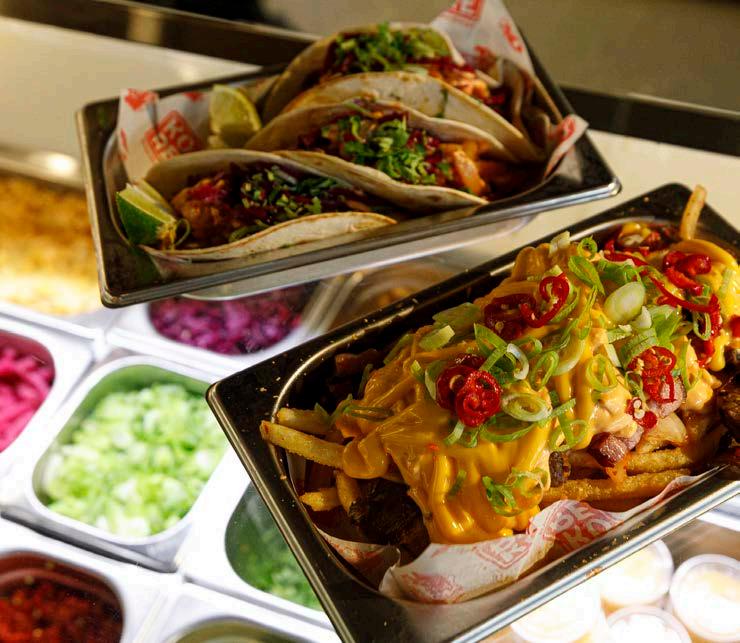
This is something I learned from my old editor, Kripal Ammanna, at Food Lovers in India, as far back as 2010 – a sentiment Mr. Wells subscribes to as well.
Contrast that casual Stockholm lunch with a dinner I had at a recently opened Japanese-Italian restaurant
by way of Tokyo? Kinda, but with a healthy Nordic reality check. Instead, our table (incidentally all Icelanders with Asian backgrounds) squirmed with discomfort with each new plate. The menu claims heritage from two places firmly rooted in technique and produce vastly different from the other. What we were served was neither Japanese nor Italian and far from a fusion of the two.
TROPES TRUMP TECHNIQUE
The trouble isn’t with this particular restaurant alone. Menus across the country and the recipes of food bloggers appearing on popular websites and in newspapers are a pale imitation of the originals they claim to be a version of. This isn’t about authenticity, but about understanding the essence of what makes a particular dish what it is. It is about understanding that rice being a principal ingredient in both doesn’t make risotto and grjónagrautur the same.
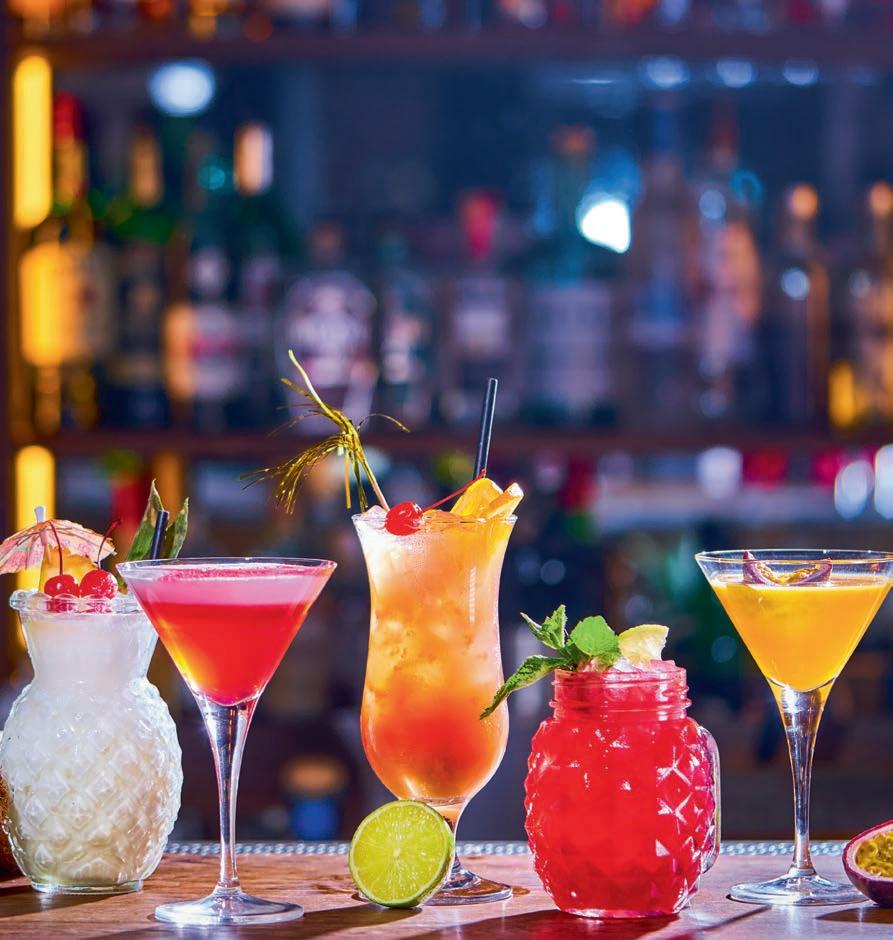

History is rife with erasures, impositions and assimilation of influences. All of these histories, old and new, play out on plates around us – like enslaved West Africans who wove seeds into their hair to literally and figuratively birth a cuisine in a land different from their home; Dalits who remain ostracised under the guise of food purity; and, more recently, the raging debates over syrniki and its Slavic heritage in the background of the Ukrainian war. Closer to home, Icelandic staples from pönnukökur to vínarterta are borne out of both scarcity and trade monopolies imposed by Danish colonisers.
Food is an agent of change and control. It isn’t mere sustenance. What
The Reykjavík Grapevine 6 / 23 32 Food
WORDS Shruthi Basappa
Feature
SÆTA SVÍNIÐ / Hafnarstræti 1-3 / Tel. 555 2900 / saetasvinid.is 990 1.690 HAPPIEST HAPPY HOUR IN REYKJAVÍK ICE LANDIC GASTROP UB
The dining slumber that afflicts the hospitality industry has got to shake loose
This isn’t about authenticity, but rather about understanding the essence of what makes a particular dish what it is. It is about understanding that rice being a principal ingredient in both doesn’t make risotto and grjónagrautur the same.
we eat, it is said, tells us who we are. I say what we cook and sell tells us what we value. Given that Iceland is no longer in a phase of scarcity, it would behove those with culinary influence to consider their values.
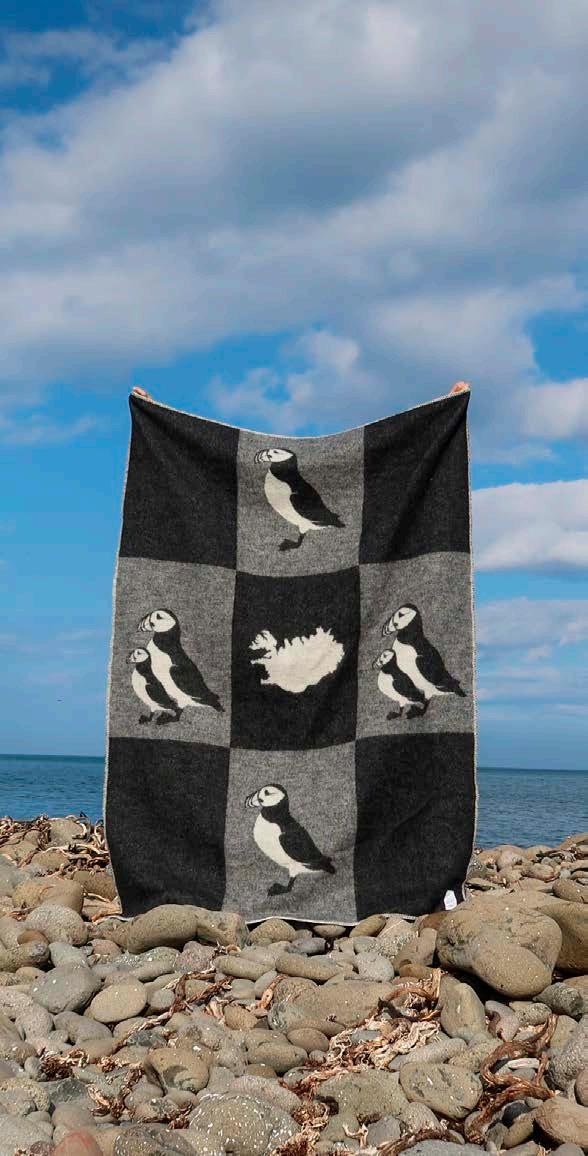
That the reverence reserved for French haute cuisine isn’t extended to other cuisines is a reality known and possibly even expected, misplaced as it is. Even the most detached home cook would shudder with horror if coriander were suggested in place of tarragon – even
excuse), technique is a respectful way to represent a cuisine chefs are otherwise mining for novelty. The irony is that chef/investor led highend restaurants get a free pass for their lack of understanding of these cuisines, whereas restaurants true to their cuisines are labelled inaccessible and foreign.
Continuing to push whitewashed versions on menus and blogs – often packaged as a “Nordic take” – reinforces the idea that other cultures are all the same; a bland beige of
showers of crudely cut spring onion and squirts of mayo instead of being presented as the lovingly pleated parcels of juicy meat they are. Where tempura isn’t garishly coloured shrimp or a grease-fest of deadbeat mushrooms, but an ethereal veil of crunch that delicately encases chunks of veggies and shrimp, their colours bright and their texture firm and crisp. I long for aggressively seasoned warm rice in my sushi. I long for fun fusion food that takes the best of two different worlds and fuses them in imaginative new ways.
I also long for the day when bloggers will stop parading problematic totems as validity (mango chutney, here’s looking at you). Somehow ekta indverskur Madras lentils is hard to digest given that the colonial name has long been reclaimed by the native Chennai. Such is the impact of lazy writing that passes as recipes today that celebrated Nanna Rögnvaldsdóttir even admits that she will not do any more cookbooks.
as they add bearnaise “extract” to flavour their eggy concoction. But all bets are off when it comes to world cuisines in Iceland. They seem to exist only to inspire jiffy weekday dinners with the convenience of a can of coconut milk or to entice customers with their otherness, as one menu attempted by boldly proclaiming its dipping sauce as “exotik soyasósa.”
In a bid for authenticity, nomenclature has become the stand-in for the actual cooking of the dish. Tropes, rather than technique, seems to be the magic mantra. Sprinkle enough words like soy, sesame, kimchi and kosho, and you’re firmly in Asia. Add coriander and chilli to the mix and you’ve arrived in Mexico! Sprinkle nuts and now you are in “Miðausturland,” an imaginary nation whose actual geographical boundaries are no match for the imaginary ones stretched by local eateries as far out as Northern Africa.
Despite the sophisticated techniques, expensive ingredients and man hours demanded by Asian cuisine, the expectation is that it should be cheap food. In all my years spent eating here, I am yet to see a restaurant claiming to do “Asian” food even attempt velveting, or add tadka to their “dal” (dal without tadka is just boiled lentils, no matter how you spin it), or master steaming and deep frying. In the absence of access to ingredients (an often touted
homogeneity devoid of nuance, lacking sophistication, and somehow primitive and therefore less important.
We’ve seen the backlash to the criticism of the Icelandic Opera’s production of Madama Butterfly, which was called out for its problematic stereotypes. The feeling that these are just cultures we can freely take
I often hear the refrain that the Icelandic customer is a stubborn one, seeking familiarity and safety when dining out. But that thought centres only one kind of customer and wholly ignores the other growing one. Almost 20% of our population is now of foreign origin. In an environment where dairy monopo-
from, with zero accountability was evident in the truly vitriolic comment sections. How these stereotypes are both born and supported by food narratives is a documented phenomenon.
PASS THE MAYO
When the world has been asking the hard questions about foodways and representation, Iceland keeps going hard at the mayo machine.
I long for a truly bombastic meal where the funkiness of kimchi is fully embraced, where dumplings aren’t shamed with superfluous
lies, supermarket chains and import companies are dictating availability, restaurants should be held accountable to both the paying customers as well the cuisines they are recklessly plumbing from.
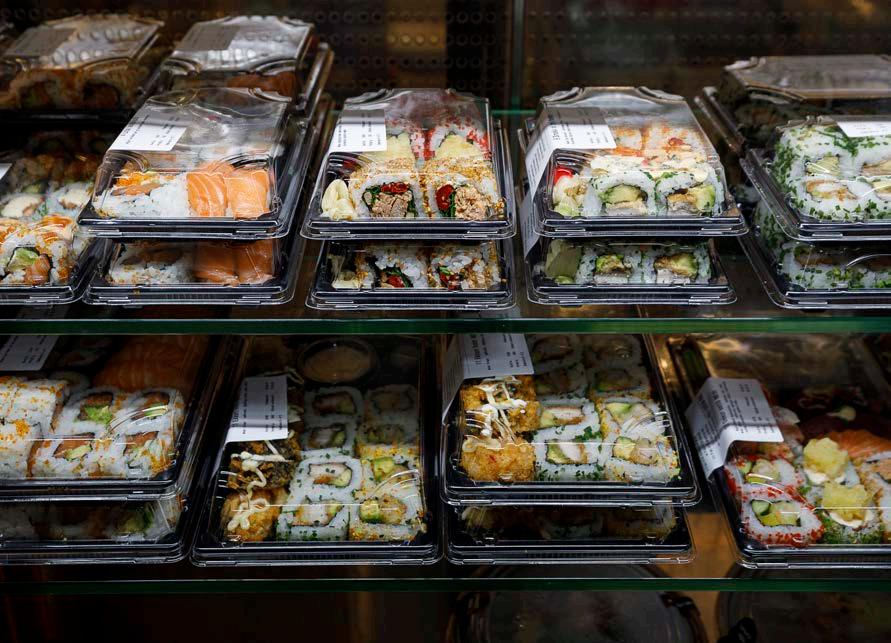
We are a diverse society, well on our way to being a truly multicultural country. By any global metric, we are a privileged lot in Iceland. To eat well and learn from each meal shouldn’t be a pipedream.

33 Food You can pick up your copy of The Reykjavík Grapevine in Krónan all around Iceland! THE PUFFIN BLANKET 100% WOOL www.islensk.is Retalers are Gullfosskaffi, Rammagerðin and
many others
In a bid for authenticity, nomenclature has become the stand in for the actual cooking of the dish. Tropes, instead of techniques, seems to be the magic mantra.
Despite the sophisticated techniques, expensive ingredients and man hours demanded by Asian cuisine, the expectation is that it should be cheap food.
Working outside the home is enormously difficult for someone as inconsistent with planning as myself. I’d love to be the kind of person who meal preps. I’d love to open my fridge in the morning and be greeted by neatly stacked Tupperware containers, labelled by day. I’d pick out a container and venture off
healthy, homemade lunch to enjoy a few hours later.
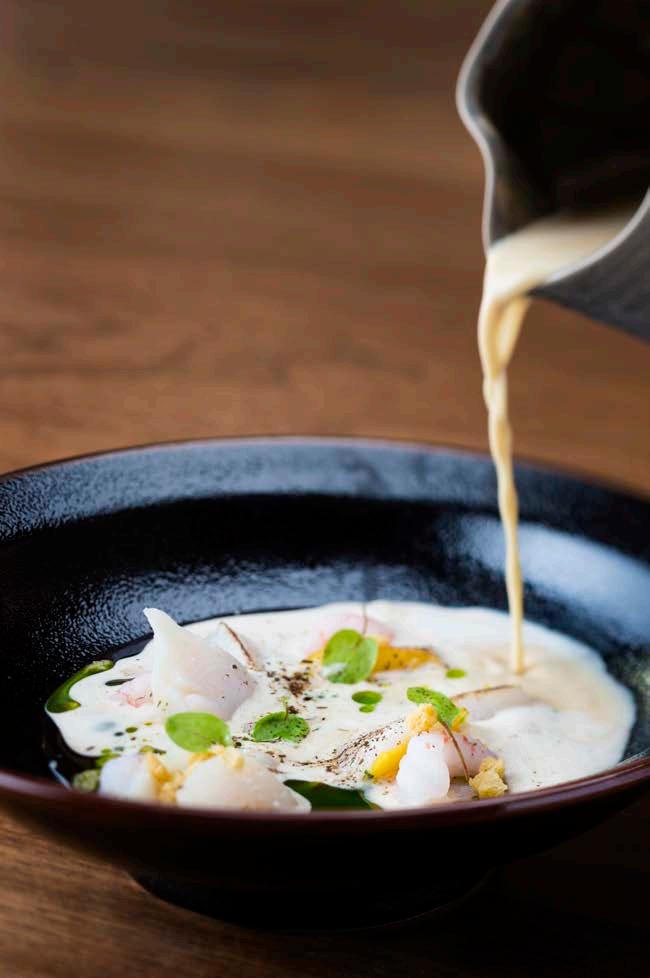
That is not my reality. Instead, upon trading in my glorious working from home set-up for this gruelling office gig at the Grapevine, I’ve turned to the eateries of 101 Reykjavík for midday sustenance. Let me tell you, it gets old. Fast.
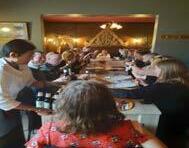

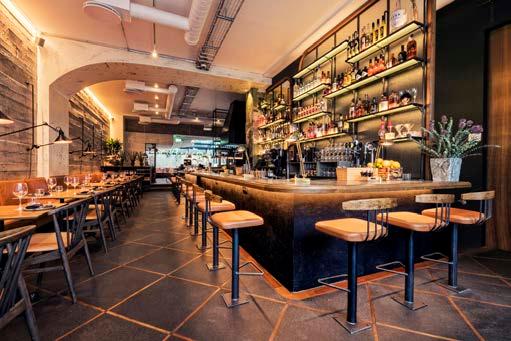
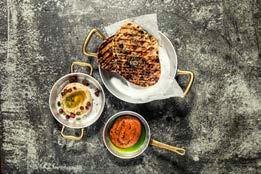


It’s burgers and french fries for as far as the eye can see. Deep fried this, mayo-slathered that. Bread and batter and blech. Enough, already. I just want a fucking salad.
Here are some spots I’ve checked out in my search for some afternoon greenery.
VEGAN WORLD PEACE
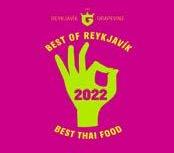

Aðalstræti 2
After an extended closure for repairs, Vegan World Peace is open once again – it’s particularly convenient since it’s directly below Grapevine HQ – and serving up a selection of salads. I’m partial to the Bean Salad (2.050 ISK), a nice base of mixed greens, topped with lightly roasted crispy bell pepper, carrots, cucumber, tomato, avocado, cashews, edamame, green beans and tofu. A bean curd dressing is served on the side so the diner can dictate how much they want to add to their veg. In short, it’s a delightful lunch.
Austurstræti 9
The Quinoa Salad (2.899 ISK) at Laundromat is a heartier take on a salad, with the greens mixed in with red quinoa, seeds and rye bread croutons. It’s lightened up by the added greed veggies and avocado. The cranberry and hibiscus dressing is delicious, but the last bites of the salad are sometimes swimming in it, so ask for a sparing amount of you want your salad crisp to the last bite.
GLÓ
Austurstræti 17
It was a happy day when Gló reopened a 101 outpost in mid-May. Though it’s a takeaway spot tacked on to the 10-11 convenience store, I’ll take it! In fact, I’ll take a Vegan Bowl (2.231 ISK), with mixed greens, crispy broccoli, roasted sweet potato, quinoa, hummus, and roasted coconut shavings, thanks.



SÓLON ISLANDUS


Bankastræti 7a
The Sólon Salad is a fine salad. At 3.990 ISK, it’s also the most expensive on this list by a fair margin. Still, a bed of baby romaine, topped with pickled tomatoes, cucumber, apples and roasted walnuts is a dependably tasty combo. The lemon dressing is nice, but, again, should be asked for on the side if you’re a control freak like me who wants a very precise dressing-to-salad ratio.
Laugavegi 28 537 99 00 sumac@sumac.is sumac.is BEST THAI FOOD 2022 2021, 2020, 2019, 2018, 2017, 2016, 2015, 2014, 2013, 2012, 2011, 2010 AND 2009, TOP TEN : BEST RESTAURANTS IN ICELAND DV 17.06.11 Lots of options for vegetarians. LOVE B A N T H A I RESTAURANT love t haifood w w w . b a n t h a i . i s PHONE : 5522-444, 692-0564 banthai130@gmail.com Laugavegur 130, Hlemmur, 105 Reykjavík ban t hai Best goddamn restaurant 2011 - - - - - - - - - - - - - - - - - - - - - -
IMAGE Art Bicnick
If your bar has a happy hour, email us on events@grapevine.is with the details.
JUNGLE COCK TAIL BAR
Every day from 16:00 to 18:00
Beer 1000 ISK, Wine 1100 ISK
Cocktails 1800 ISK.
KAFFI LÆKUR
Every day from 16:00 to 19:00 & 22:00 to 23:00 on Tue–Sat
Beer 950 ISK, Wine 1050 ISK.
KALDI
Every day from 16:00 to 19:00
Beer 950 ISK, Wine 950 ISK.
LOFT
Every day from 16:00 to 20:00
Beer 860 ISK, Wine 950 ISK.
LÓLA FLORENS
Every day from 15:00 to 18:00
Beer 1200 ISK, Wine 1200 ISK.
PETERSEN SVÍTAN
Every day from 16:00 to 19:00
Beer 900 ISK, Wine 1200 ISK.
PRIKI Ð
Every day from 16:00 to 20:00
Beer 700 ISK, Wine 1000 ISK.
PUNK
Every day from 16:00 to 18:00
Beer 850 ISK, Wine 950 ISK.
UPPSALIR BAR
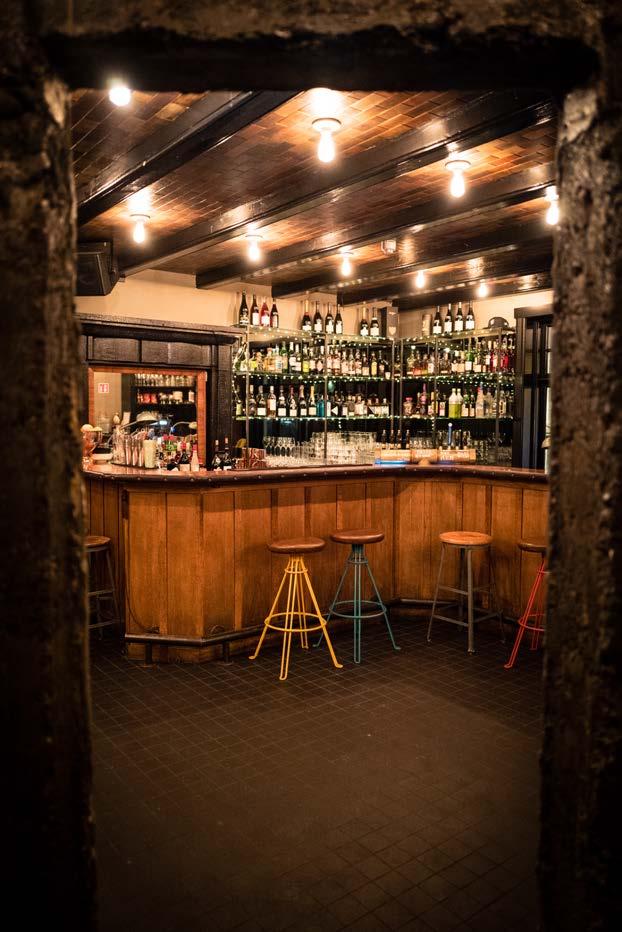
Every day from 16:00 to 19:00
Beer 750 ISK, Wine 900 ISK.
RÖNTGEN
Featured
Röntgen
Hverfisgata 12
BASTARD BREW
Every day from 16:00 to 19:00 500 ISK off Beer, Wine and Cocktails.
BÍO PARADÍS
Every day from 17:00 to 19:00
Beer 850 ISK, Wine 850 ISK.
BREWDOG
Wed-Sun from 14:00 to 17:00
Beer 990 ISK, Wine 990 ISK.
BRÚT BAR
Every day from 16:00 to 19:00
Beer 700 ISK, Wine 750 ISK. 2F1 on wine and beer on tap.
FJALLKONAN
Every day from 15:00 to 18:00
Beer 990 ISK, Wine 1190 ISK.
FORRÉTTABARINN
Every day from 16:00 to 18:00
Beer 800 ISK, Wine 900 ISK.
GAUKURINN
Every day from 16:00 to 21:00
Beer 900 ISK, Wine 1100 ISK.
JÖRGENSEN
KITCHEN & BAR

Mon, Tue, Wed 16:00–18:00, Thursday from 16:00–20:00, weekends from 12:00 to 18:00
Beer 750 ISK, Wine 900 ISK.
Every day from 16:00 to 19:00
Beer 900 ISK, Wine 1000 ISK.
SÆTA SVÍNI Ð
Every day from 15:00 to 18:00
Beer 990 ISK, Wine 1190 ISK.
SKÚLI CRAFT
Every day from 12:00 to 19:00
Beer 900 ISK, Wine 900 ISK.
Happy hour includes four selected tap beers
SLIPPBARINN
Every day from 15:00 to 18:00
Beer 1000 ISK, Wine 1000 ISK.
SPILAKAFFI
Every day from 17:00 to 19:00
Beer 950 ISK.
STÚDENTA KJALLARINN
Everyday from 16:00 to 19:00
Beer 710 ISK Wine 850 ISK.
VE Ð UR
Every day from 12:00 to 19:35
Beer 800 ISK, Wine 800 ISK.
ÖLSTOFAN
Every day from 15:00 to 20:00
Beer 1000 ISK, Wine 1000 ISK.
Having recently claimed the title of the Grapevine’s Best Goddamn Bar (again!), we obviously have to make sure you go! In case you haven’t dropped by before, we’re here to tell you Röntgen’s got it all: a relaxed happy hour, rowdy late nights, two floors with different vibes, a great mix of DJs and excellent bartenders. The place quickly dominated the Reykjavík bar scene almost immediately after opening a few years back, attracting a fashionable clientele and fostering a comfortable environment that work in tandem to imbue Röntgen with undeniable appeal. Staff favourite drinks are Peroni on draft and the secret-menu Filthy Martini.
Happy hour / 4–7pm Beer / Wine / Cocktails
Happy hours
Every day from 16:00–19:00 Cheapest beer 900 ISK Wine glasses 1000 ISK
A Selection From Every Happy Hour in 101 Reykjavík Cheap Eats
Here are some sweet meal deals that’ll fill your tummy and without draining your bank account.
DOMINO’S
Tuesday, pick-up only
Tuesday Special: medium pizza with
three toppings: 1.200 ISK all day on.
DRAGON DIM SUM
Every day, except Sunday, from 11:30–14:30
Choice of any two dumpling baskets: 2.190 ISK.
GLÓ
All day, every day
Bowl of the Month: 2.290 ISK.
NOODLE STATION
All day, every day
Vegetarian noodle soup: 1.100 ISK.
PIZZAN
All day, every day
Combo Pick-up Offer: choice of menu pizza & breadsticks: 50% off.
PHO VIETNAMESE
All day, every day
Pho & wonton soups: 1.890 ISK.
REYKJAVÍK ROASTERS
All day, every day
101 STREET FOOD
All day, every day
All appetizers & main courses:
2.050 ISK.
APÓTEK
All day, every day
Soup of the Day: 1.990 ISK.
BÆJARINS BEZTU
All day, every day
Hotdog and soda: 990 ISK.
BRÚT
On Friday, Saturday & Sunday
Bottomless Brunch, including selected drinks: 6.900 ISK.
DEIG
On weekdays after 10:00
Poor Man’s Offer: filled bagel, doughnut & drink: 1.850 ISK.
HAM BORGARA BÚLLA TÓMASAR
All day on Tuesday
Tuesday Special: burger, fries & soda: 1.790 ISK.
HLÖLLABÁTAR
Every day until 14:00
Lunch Offer: Choice of any sub and soda: 1.995 ISK.
ÍSLENSKI BARINN
All day, every day
Soup of the Day: 1.650 ISK.
LEMON
All day, every day
Combo of the Month: large sandwich & juice: 2.195 ISK.
MAI THAI BISTRO
Every day from 11:00–14:00
Lunch of the Day: 1.890 ISK.
Breakfast menu & sourdough toasts (various toppings): 580–1.350 ISK.
SHALIMAR
Weekdays from 12:00–15:00
Curry in a Hurry Lunch Special: 1.590 ISK.
SHANGHAI
All day, every day
Choice of 3-dish combo: 2.290 ISK for one; 4.390 ISK for two.
SUBWAY
All day, every day
Sub of the Day: 1.399 ISK for 6”; 1.899 for 12”.
ZORBIAN HOT
All day, every day
Chicken shawarma wraps & falafel wraps: 1.490 ISK.
35 Food Hverfisgata12
Appy
RÖNTGEN
Listings
What If Iceland Had Joined The British Empire?

Another alternative history thought exercise to wrap your mind around
WORDS Valur Gunnarsson
IMAGE Art Bicnick
There is a grave in Australia dated 1841 belonging to a former convict, police constable, gambler, explorer and spy. If this wasn’t an impressive enough resume, the title under which he rests forevermore is “King of Iceland.” Bizarrely, that is accurate – at least in a manner of speaking – due to events in the summer of 1809, when this king led something of a revolution.
In 1807, at the height of the Napoleonic Wars, the Danish kingdom and the British Empire found themselves on opposing sides. After a brief engagement, the Royal Navy captured the Danish vessel Admiral Juul and its captain, Jörgen Jörgensen, was taken to London. Beginning a series of strange events, Jörgensen soon found himself released from captivity and in the employ of soap salesman Samuel Phelps.
Iceland had been isolated from the Danish motherland for two years and Phelps smelled a business opportunity. Jörgensen had convinced him that Icelanders in the midst of famine would be happy to buy what wares he had to offer and offered to come along as an interpreter. Phelps would sell them food and tobacco in exchange for tallow to sell back home. And so two English merchant vessels set off for Iceland, with which they were technically at war.
The Dane Frederich Christopher, Count of Trampe, governed the colony and turned the English away. Famine or not, Icelanders were still forbidden to trade with foreigners. But the English soon returned – this time they weren’t open to debate. The Count was seized and interned on their ship while the locals looked on in puzzlement. Englishman Phelps could not officially seize the country without permission from His Majesty’s Government. It was therefore up to his interpreter to take charge.
REVOLUTIONARY ICELAND
Inspired by the French Revolution, Jörgensen decided to declare a republic, making himself its master and commander. Houses were searched for firearms to be req-
uisitioned and a republican guard was formed consisting of a dozen or so previously disadvantaged Reykvíkians, including some released from prison. Uniforms were sewn, the prison house turned into a barracks and a small fortress was constructed on the coast, defended by six Danish cannon discovered in storage and probably intended to be used against Turkish raiders 200 years earlier.
Many found work for the revolutionary government, paid for out of the heretofore royal Danish coffers and foodstuffs were transported from better-off areas to where they were most needed. Most local dignitaries continued on in their posts, with little opposition to the new regime. The first Icelandic flag was raised, displaying three codfish on a blue field and it was proclaimed that elections would be held a year hence. Until a popularly elected government took office, Jörgensen would continue in his role as Lord Protector. Perhaps the greatest novelty in what amounted to the country’s first constitution was that everyone would have the right to vote, irrespective of standing, which was going farther than most revolutionaries at the time would consider.
But as suddenly as the revolution began, it was over. Perhaps it was surprising that no resistance was
to England as prisoners, as both were seen as detrimental to English interests. Meanwhile, judge Magnús Stephensen made himself governor of Iceland in the name of the Danish king, but without his appointment.
Jörgensen now found himself a prisoner of England for the second time in as many years, but his adventures were far from over. He supposedly witnessed the battle of Waterloo from the safety of a nearby tree while serving as a British spy before being imprisoned again for gambling debts. This time he was shipped to Australia, where he would become a constable upon his release before eventually dying in Tasmania.
But what if Jörgensen would have fought the British and tried to rally the residents? In all likelihood, six old Danish cannon and a 12-man army would not have held off two Royal Navy vessels, unless by some miracle the British would have decided this was not worth the effort in order to give the country back to the Danes.
Even if we imagine Jörgensen holding out, by the end of the war in 1814 the English would have made sure the country was returned to Danish hands. Britain would not have fought republicanism on the mainland for the best part of a quarter century
cably moved into the British sphere of influence. Why wasn't it incorporated fully as the British Empire was expanding again after the loss of its American colonies?
The idea had surfaced in 1785 when it was suggested that Iceland become a British penal colony. Perhaps sentencing convicts to Iceland
dustry, enabling the country to rise from desperate poverty much sooner. Young Icelanders would have aspired to go to Oxford and Cambridge to study and a railway might even have been built – which we still haven’t gotten around to.
Or perhaps, more likely, the fish would have been gobbled up by
offered when foreign ships arrived. The fortress did not fire a shot, nor did the revolutionary guard, and Jörgensen was busy holding a ball where he attempted to bring both royal and revolutionary dignitaries together.
Even more surprising was who deposed the Lord Protector. It turned out to be neither the Danish reconquering their lost territory nor Icelandic landowners worrying about their privileges. Rather it was Phelps’ countrymen, the British, coming to the aid of an enemy kingdom. Count Trampe and Jörgensen were brought
only to see it pop up in Iceland. This might have created a dangerous precedent. So an independent Iceland in 1809 was unlikely. But another opportunity presented itself.
BRITISH ICELAND
Sir Joseph Banks of the Royal Academy in London, who had previously visited Iceland and had an affinity for the place, managed to have Iceland, Greenland and the Faroes excluded from the British naval blockade in 1810, thereby likely averting famine. By the end of the Napoleonic Wars, it was clear that Iceland, though still ruled from Copenhagen, had irrevo-
was deemed too harsh a punishment, and in any case the idea was impracticable since Britain was not at war with Denmark at the time. When war did break out in 1807, annexing Iceland was put back on the table. This was egged on by Sir Joseph Banks who complained about Danish misrule and thought that Icelanders could develop as a people under English guidance, as well as provide resources such as sulphur and fish to the empire.
What if this had taken place? Instead of moaning about Danish historical injustices, Iceland patriots would have had to take a greater interest in current affairs. The 19th century would have been an era of progress as would turn out to be the case, but perhaps even more so as the industrial revolution was centred on Britain. Nevertheless, as the century wore on, many in Iceland would have begun to clamour for independence.
But the tone would have been different. Instead of emphasising how the Sagas had preserved Nordic history in order to garner respect from the larger Scandinavian countries, connections with Saxon and Viking England would be held up as examples of past glories. British scholars would have shown a mild interest in the Icelandic Sagas, but perhaps more as works of noble savages than common ancestors.
Whether the English would have done much to improve matters, as Sir Joseph Banks anticipated, is open to debate. In the optimistic scenario, English capital would have flooded in, fishing boats been acquired, fish factories established and fishing turned into a major in-
British boats and processed in home ports, as was to be the case until the Cod Wars of the later 20th century put an end to it. A British naval base would have been established to ward off attention from the Germans and the French. Perhaps this would have continued operating in the later half of the 20th century, leading to a different outcome in those fishing disputes.
The Danes agreed to home rule in 1904 and Iceland became sovereign in 1918 without much fuss. Ireland had to fight harder for their independence and perhaps London would not want an Icelandic example of self-rule to egg them on. Things would have taken longer in this scenario and perhaps Iceland could have become independent in the interwar era but remain under the British crown, like Australia, New Zealand or Canada. Maybe we would have celebrated a new king this year. Or perhaps the idea of a republic would surface again…
Are you enjoying Valur Gunnarsson’s reimagining of historical events?
Then you’ll love his new book, with each chapter offering an expanded in-depth exploration of how Iceland could be different today if only key historical happenings hadn’t played out the way they did.
What If Vikings Had Conquered the World? And Other Questions of Icelandic and Nordic History is out June 1 through Salka Publishing. Preorder your copy at shop.grapevine.is starting May 19.
And check out the Grapevine’s Alternative History Of Iceland podcast for more hypothetical hijinks.
36
Alternate Reality
The fortress did not fire a shot, nor did the revolutionary guard, and Jörgensen was busy holding a ball where he attempted to bring both royal and revolutionary dignitaries together.
British scholars would have shown a mild interest in the Icelandic Sagas, but perhaps more as works of noble savages than common ancestors.
Living In A Planter’s Paradise

A shopping bag of goodies to turn your home into a jungle
IMAGES Supplied The first day of summer was a month ago, but it’s just recently feeling like spring is in the air. What better way to embrace the season than to exercise your green thumbs and set the groundwork to transform your home into a lush sanctuary. We’ve been doing just that of late, repotting our beloved photosynthesising babies and introducing some new specimens to the fold. Here’s the merch that has us happily playing with dirt.
WORDS The Reykjavík Grapevine
1 Plant Tower A tiered planter to keep fresh herbs on hand at all times, available from Flying Tiger, Laugavegur 13 1.200 ISK
2 Fresh Basil A basil plant to populate that plant tower. Break up the plant at the root ball into smaller segments before replanting, available from Krónan 589 ISK
3 Large Planter with Tray Your plants need drainage to be healthy, so this tray will come in handy, available from FAKÓ, Holtagarðar 9.995 ISK

4 Germination Plate Let’s see if you can grow an avocado tree!, available from Lauuf.com 2.550 ISK
26 stores across Reykjavík and Iceland
5 Hanging Planter Let your tradescantia zebrina live her best life high off the ground, available from Søstreme Grene, Kringlan 1.860 ISK
6 Nursery Pots
For using as inserts in decorative planters that lack drainage, available from Garðheimar, Stekkjarbakki 6 from 130 ISK



7 Planting Soil
Most plants need soil. This one should do the trick, available from Garðheimar, Stekkjarbakki 6 from 650 ISK
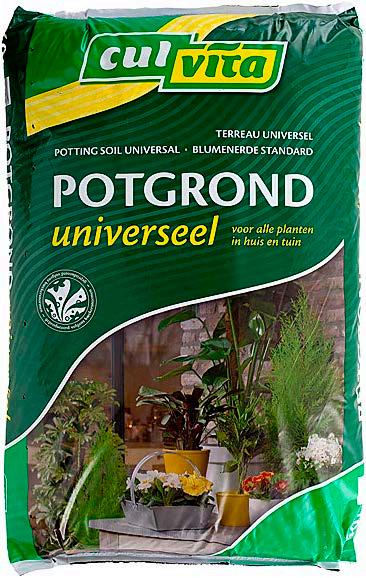

8 Grow Light
Those long summer days aren’t going to last forever. Keep the sun shining on your plants with a grow bulb, available from IKEA.ison hand at all times, available from Flying Tiger, Laugavegur 13 1.790 ISK


37
View locations and opening hours at kronan.is
With fresh products and low prices!
The Haul
1 6 2 7 3 4 5 8
Stay like a local
8 hotels, restaurants & spas in the heart of

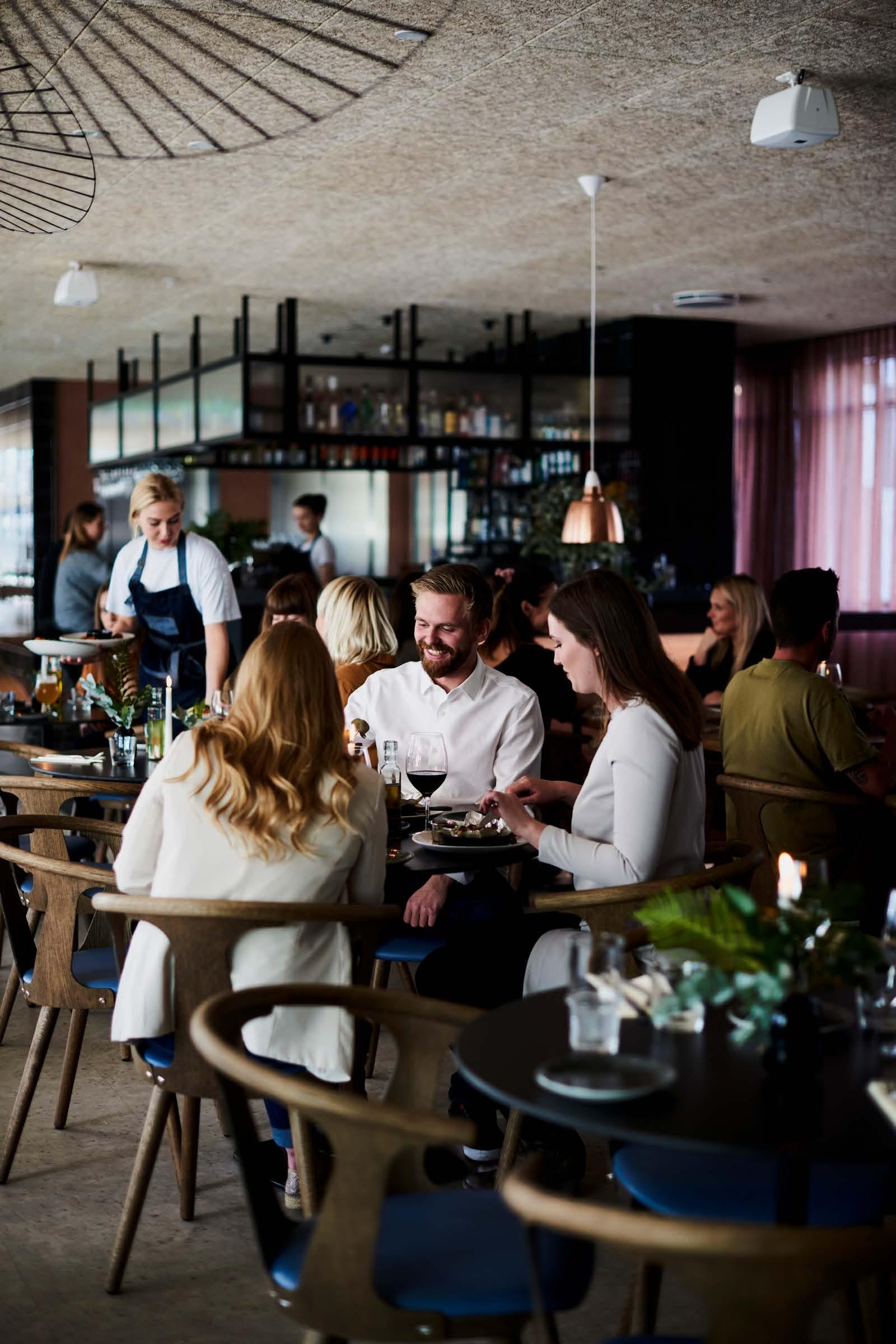
Musings
HELP!
I

am stuck in a parking lot again
WORDS Charlie Winters
IMAGE Art Bicnick

Over the past few months, I, an adult with a fully developed frontal lobe, have gotten stuck in nine separate parking lots. And when I say stuck, I mean absolutely lost, not being able to find the exit and having to clamber over a fence while amused locals gawk. This problem with parking places has led to ridicule from friends and family who seem baffled by how this is even possible, especially since I don’t own a car. I believe it has something to do with the parking lots, it can’t just be me. Right? Let’s look at the numbers.
Any proper scientific research regarding the accurate mapping of infrastructure always starts at the same place: Google Maps. Looking up parking lots in the Reykjavík area gives us forty-seven different potential locations to get stuck in. Taking the population of the city into account, that’s 0.00038 parking lots per capita – an avoidable amount. The solution is simple, mark out every single one and avoid them like locals avoid clothes in summer.
My plan was working for a while.
Google Maps doesn’t mark out privately owned parking spaces. This complicates my initial numbers. Taking into account the many buildings across Reykjavík and adjusting for parking spaces according to the number of businesses in the region gives us a fuck ton of places per capita that my dumbass can get stuck in. This makes the problem unavoidable.
The husks of empty cars lie silent and unmoving. The painted lines meet in jagged corners marking acceptable parking spots. How did I get here again? Why does this keep happening? Whose muddy footprints are these? Have others been lost within the dark asphalt plains?
I’ve dexterously avoided the great mounds of Iceland University of the Arts. I’ve resisted the temptation of the free parking near the harbour. I’ve even defeated the Kringlan twins of terror, whose bridge has confused many a wandering traveller. Things were going well.

It had not been a week before I was stuck in the lot of the State Police Office overlooking Sæbraut. The view is nice, but the fence gave me splinters, I give it 7/10. Evidently,
If they are in fact unavoidable, perhaps I must instead train myself to escape them. And who better to learn from than other successful runaways? In many of the parking lots I’ve been stuck in, there are footprints. They’re especially easy to track in mud and snow. Like Ariadne of the legends of old, they have left me trails of twine to escape these labyrinthian spaces. Following their footprints, I can deduce their methods of escape and learn their secrets. Soon I shall be able to leave parking lots without embarrassment. Wait… All the footprints lead to the fences. They all just hopped the fences. No one knows how to get out. It’s hopeless. I’m going to spend the rest of my life on stretches of asphalt watching the paint fade under the wear and tear of unnecessarily large jeeps. Iceland’s car-centricity has doomed me to a paved existence.
If you are reading this, I need help. I am trapped in a lot near Hlemmur. I’m too short to climb over the bars. Please, somebody, come get me out of here. It’s been days now and I have to get home. I already missed Eurovision.
38
[
Reykjavik ]
“Life. Don’t talk to me about life.”
The Grapevine answers your most burning questions
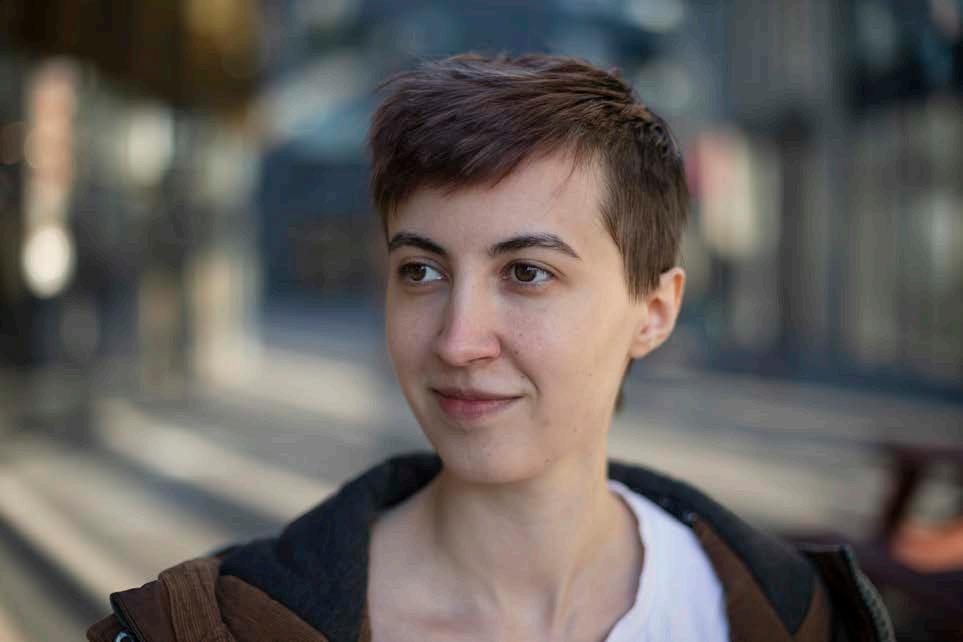
No point in dressing for the weather, the car is our preferred suit attire on tires. We drive to work (which is five minutes away) in one of our gigantic Jeeps and spend 36 minutes looking for a parking spot. For lunch we get some skyr and hangikjötsalad and wave at the fisher-people. Once the work day is done at 15:00, we head home for some quality time in the hot tub and to read the Sagas before making some cod and potatoes for dinner. One episode of a Nordic crime drama later, and it’s off to bed to begin anew.
WHAT TIME IS IT ?
What time indeed. Who’s to say at this point? The sun refuses to leave. The light deceives us. Mother Nature
is a liar. The birds chirp and trill at all times. Lost souls wander the streets at midnight, thinking they’re on their way to get groceries before the stores close. Only to discover that the doors were locked hours ago. Reality is crumbling around us. We don’t know when to sleep. How to get a good night’s rest, when there is no night?? I can’t recall the last time I’ve been securely taken to the halls of Morpheus. Has it been a day? Two days? Is it 3 a.m. or p.m.? I don’t remember the stars…
WHAT IS THE MEANING OF LIFE, THE UNIVERSE AND EVERYTHING ? Instead of taking this as an opportunity to showcase my nerd
credentials – I know it’s 42. You know it’s 42. We all know it’s 42. It always has been, always will be 42. Hold my towel – let’s maybe wonder at the meaning of the question again. More specifically you, yes you, and the joy you found in asking this question. This universal question that fits everywhere. The conversation starter. The evidence of sci-fi literacy. Is it even about the answer? What answer could I even give you that would satisfy you more than my engagement with the question in the first place? What meaning does the question of life, the universe and everything hold for you? Yes, you, I’m writing to you. I see you. I’m the one asking the questions now! Answer me!

39 The most special co ee from specialists in speciality co ee. Co ee & Sandwiches Hafnarstræti 11 ka _o_le
dodge the odd overeager cyclist.
Last Look IMAGE Art Bicnick
Potent Quotables
If you have animals, you're going to get connected to some of them.
It's a place for everybody to get inspired.

From an outsider’s perspective, it can look like massive chaos. Sævar

It’s probably like going hunting for hunters.

the mayo machine.
Shruthi Basappa advocates for representation and elevated technique within Icelandic food culture on page 32.
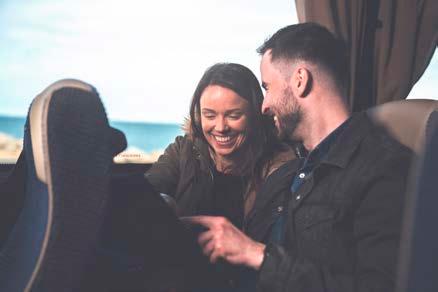
Maybe we would have celebrated a new king this year.
What would happen if Iceland had joined the British Empire? Valur Gunnarsson has all the answers on page 36.

Discover Float Therapy in the Blue Lagoon The deeply relaxing interplay of floatation and light massage alleviates stress, relieves pain, and brings inner peace. Airport Transfers All flights 45 min Free WiFi For our flexible Flybus schedule, please visit www.flybus.is, Prices from 3.899 ISK Prices & availability are subject to change without notice. mountainguides.is BOOK NOW Adventure Day Tours The Reykjavík Grapevine Free copy Volume 20Issue 6 2023Best before June 1 Culture Music Travel
Pálína Axelsdóttir Njarðvík discusses life and gives the Grapevine a peek at lambing season on
8.
page
Melkorka Sigríður Magnúsdóttir shares why you should visit Iceland Innovation Week on page 15.
deconstructs
idea
Helgi Jóhannsson
the
of Korda Samfónía on page 24.
The Grapevine goes birdwatching
with expert Sigurjón Einarsson on page 28.
When the world has been asking the hard questions about foodways and representation, Iceland keeps going hard at















































































































































